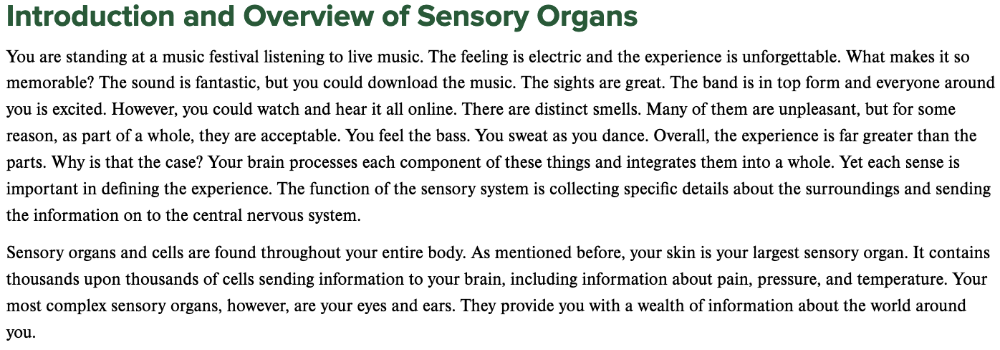
Chapter 6 Introduction and Overview of Sensory Organs
...
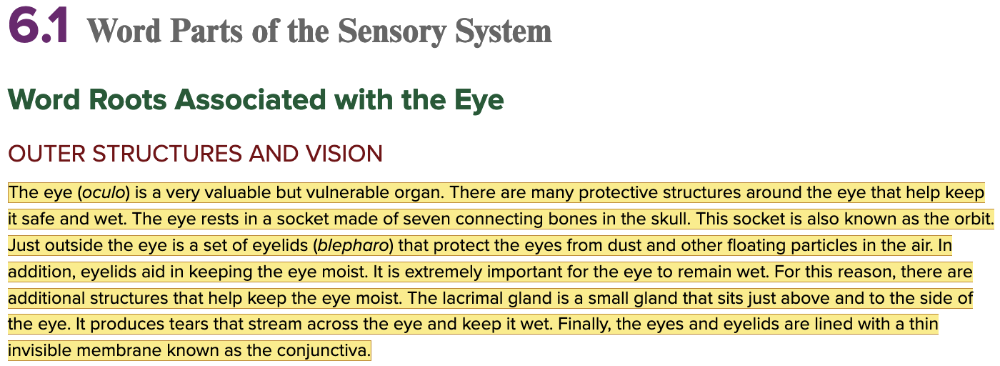
Chapter 6.1 Word Parts of the Sensory System
Word Parts Associated with the Eye
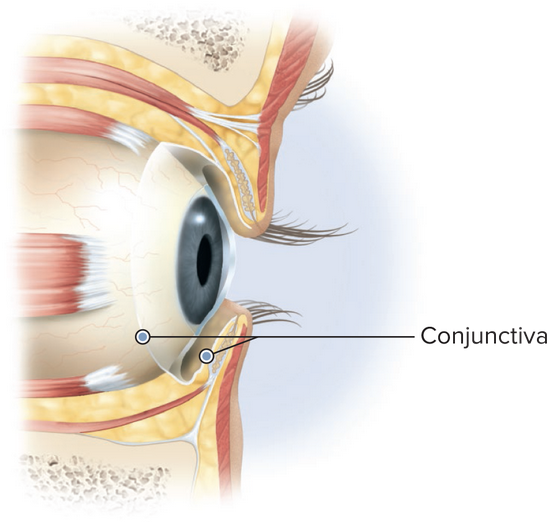
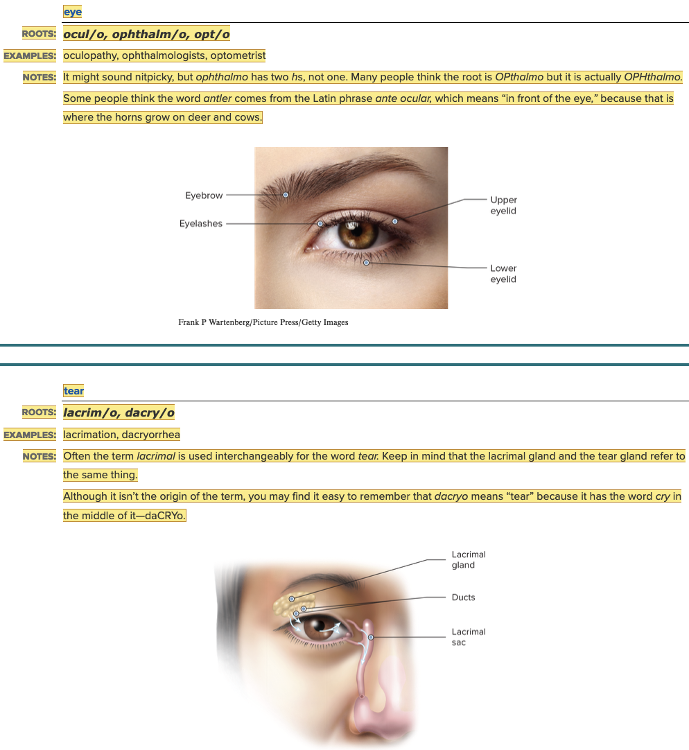
Chapter 6.1 Word Parts of the Sensory System
Word Parts Associated with the Eye: Outer Structures and Vision
- Parts of Sensory System: Root Examples Part 1
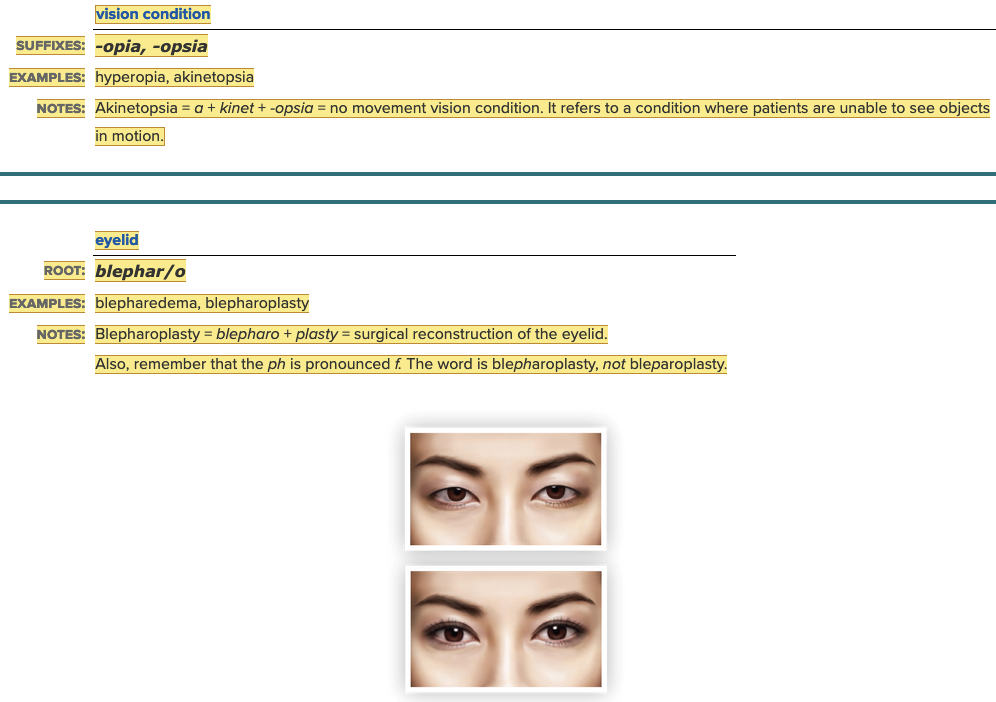
Chapter 6.1 Word Parts of the Sensory System
Word Parts Associated with the Eye: Outer Structures and Vision
- Parts of Sensory System: Root Examples Part 2
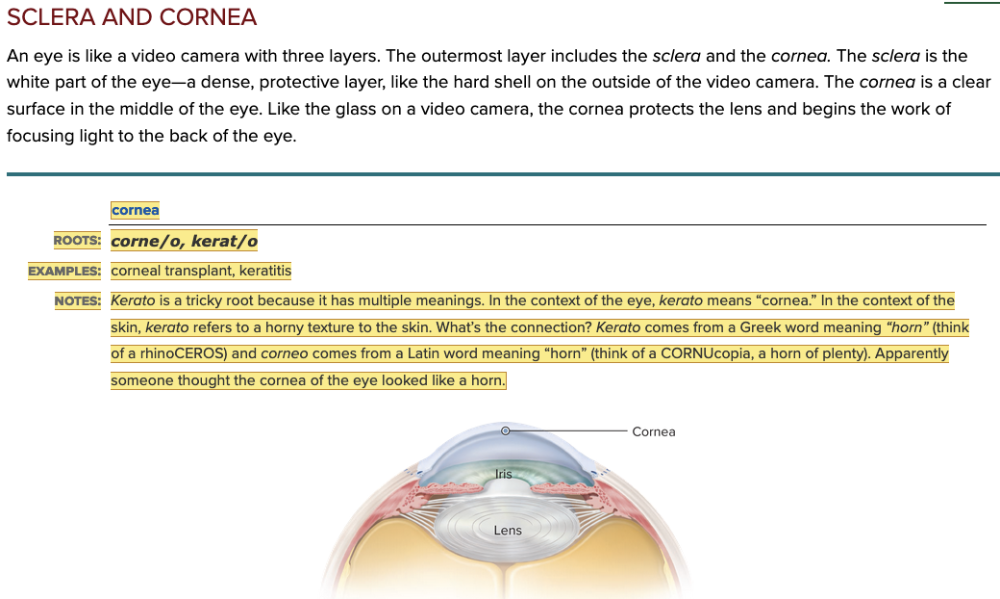
Chapter 6.1 Word Parts of the Sensory System
Word Parts Associated with the Eye: Sclera and Cornea
- Parts of Sensory System: Root Examples Part 1
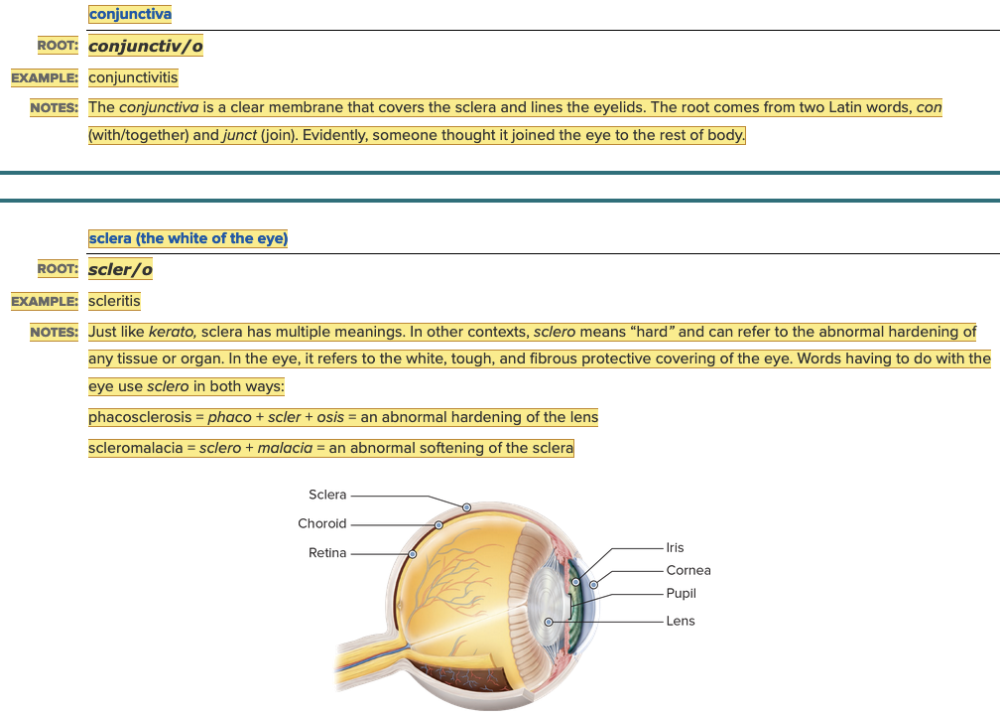
Chapter 6.1 Word Parts of the Sensory System
Word Parts Associated with the Eye: Sclera and Cornea
- Parts of Sensory System: Root Examples Part 2
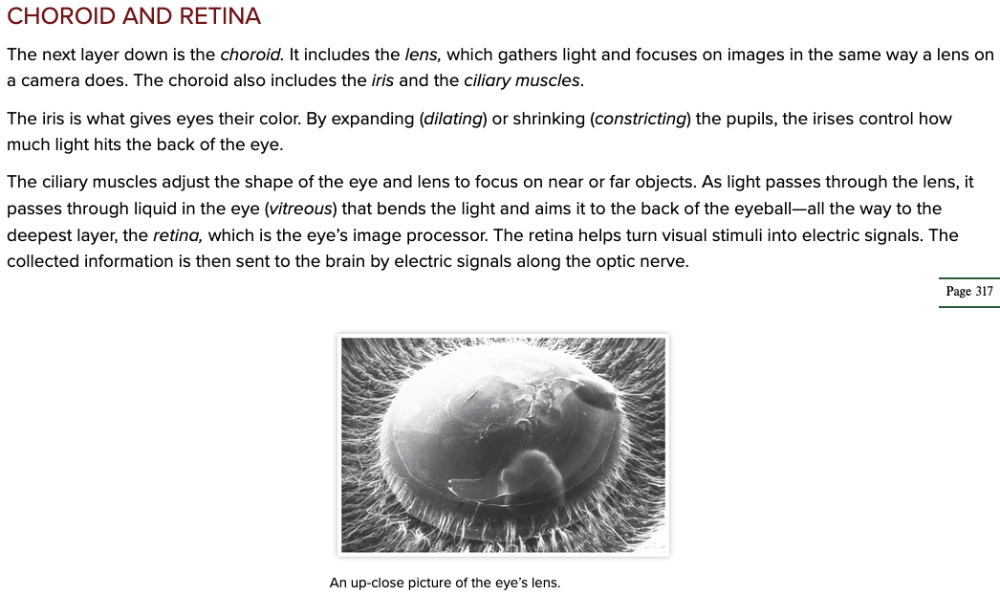
Chapter 6.1 Word Parts of the Sensory System
Word Parts Associated with the Eye: Choroid and Retina
...
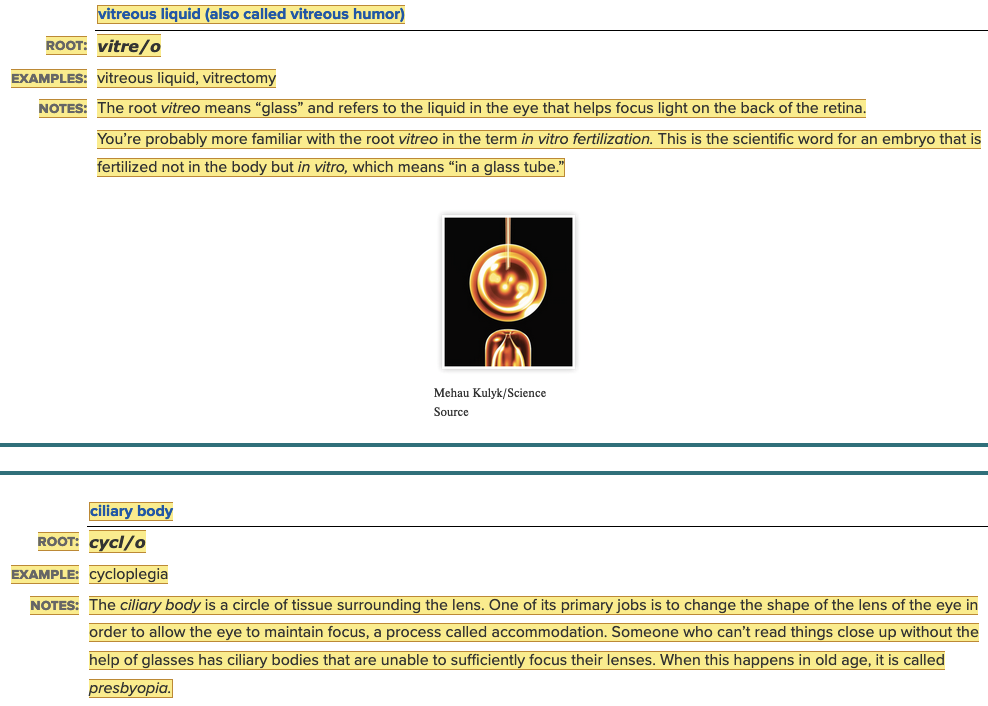
Chapter 6.1 Word Parts of the Sensory System
Word Parts Associated with the Eye: Choroid and Retina
- Parts of Sensory System: Root Examples Part 1
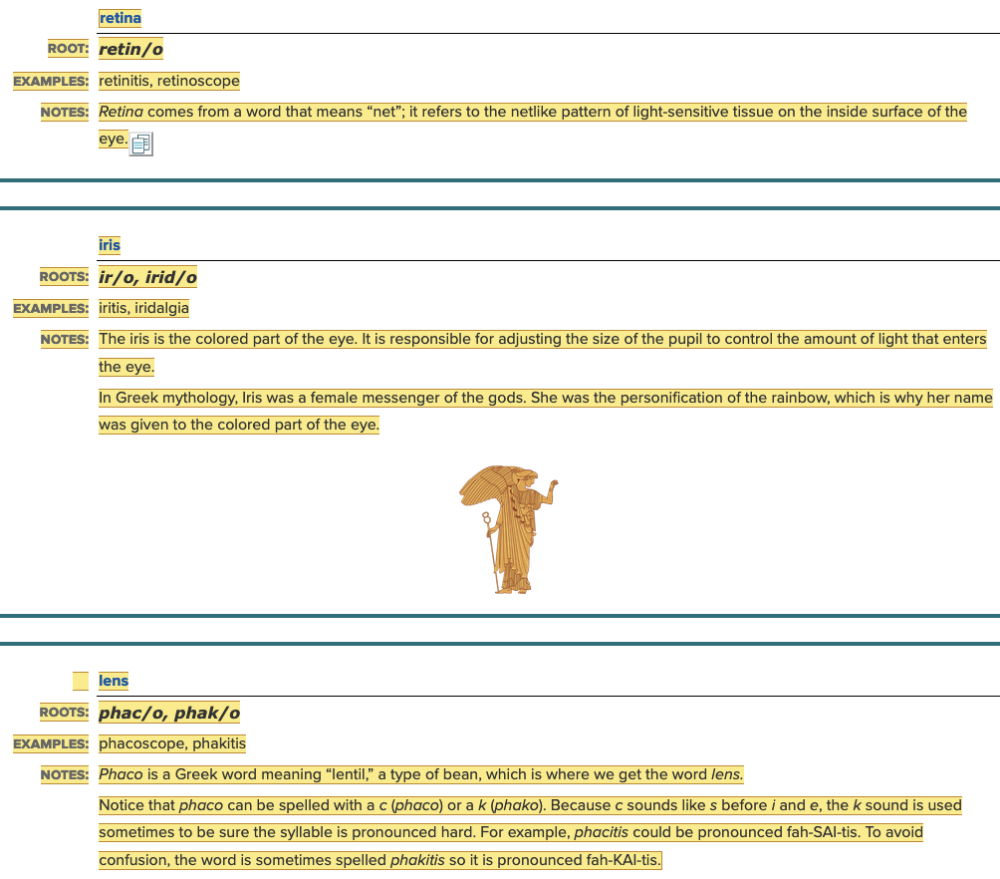
Chapter 6.1 Word Parts of the Sensory System
Word Parts Associated with the Eye: Choroid and Retina
- Parts of Sensory System: Root Examples Part 2
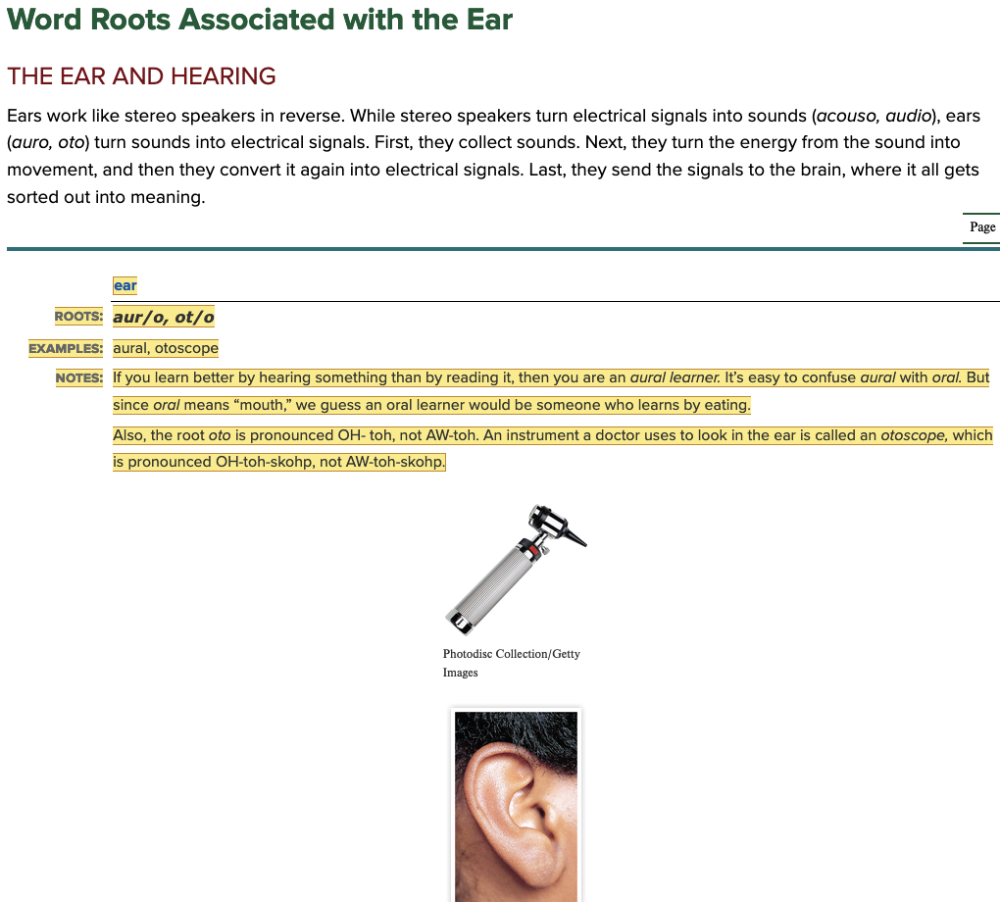
Chapter 6.1 Word Parts of the Sensory System
Word Parts Associated with the Ear: The Ear and Hearing
- Parts of Sensory System: Root Examples Part 1
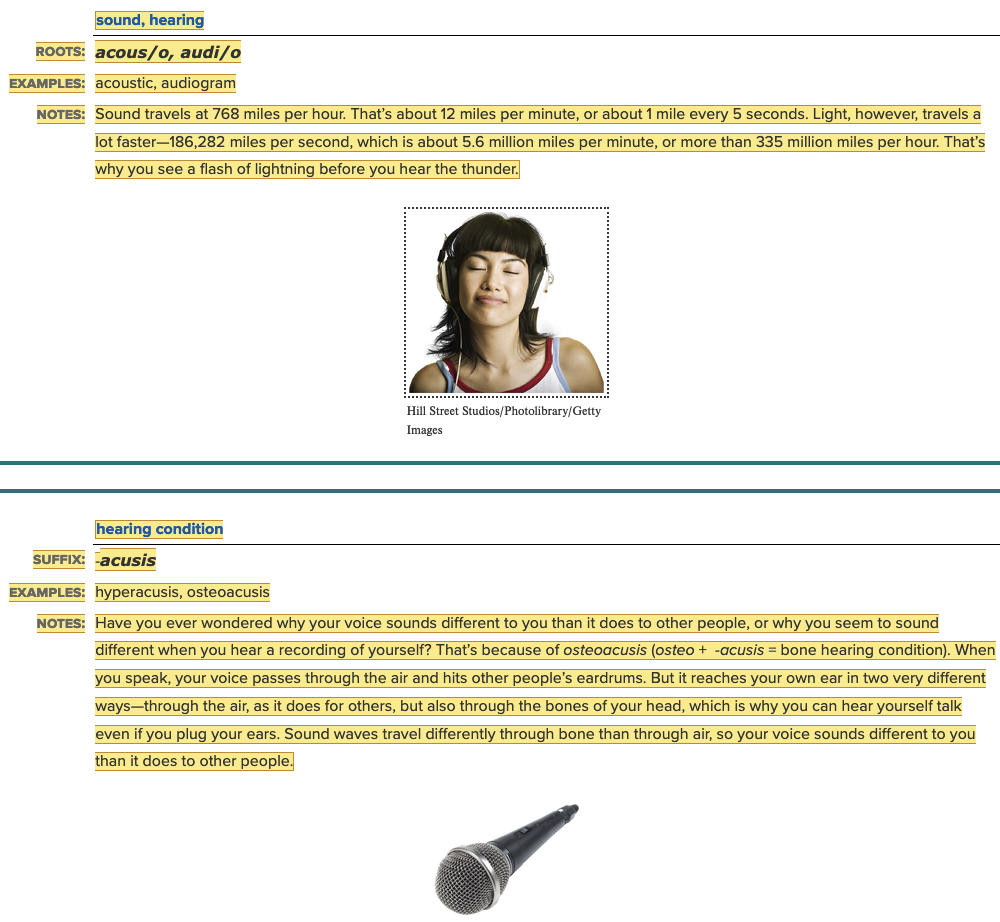
Chapter 6.1 Word Parts of the Sensory System
Word Parts Associated with the Ear: The Ear and Hearing
- Parts of Sensory System: Root Examples Part 2
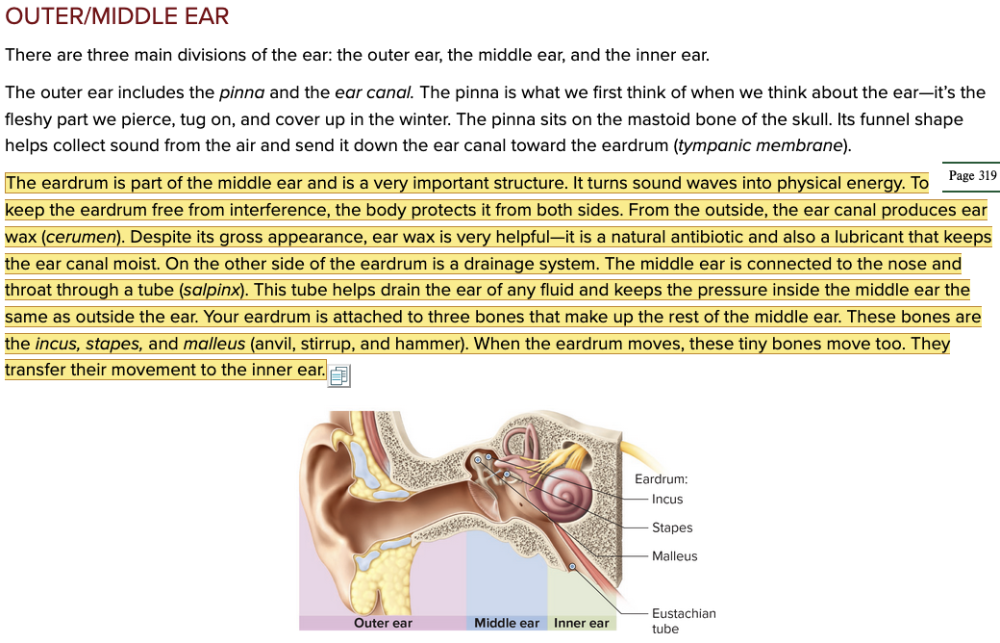
Chapter 6.1 Word Parts of the Sensory System
Word Parts Associated with the Ear: Outer/Middle Ear
...
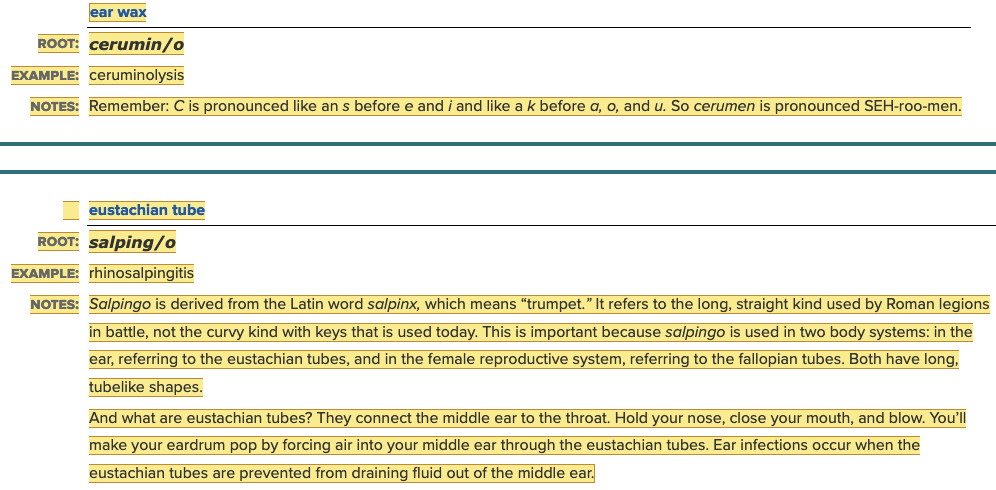
Chapter 6.1 Word Parts of the Sensory System
Word Parts Associated with the Ear: Outer/Middle Ear
- Parts of Sensory System: Root Examples Part 1
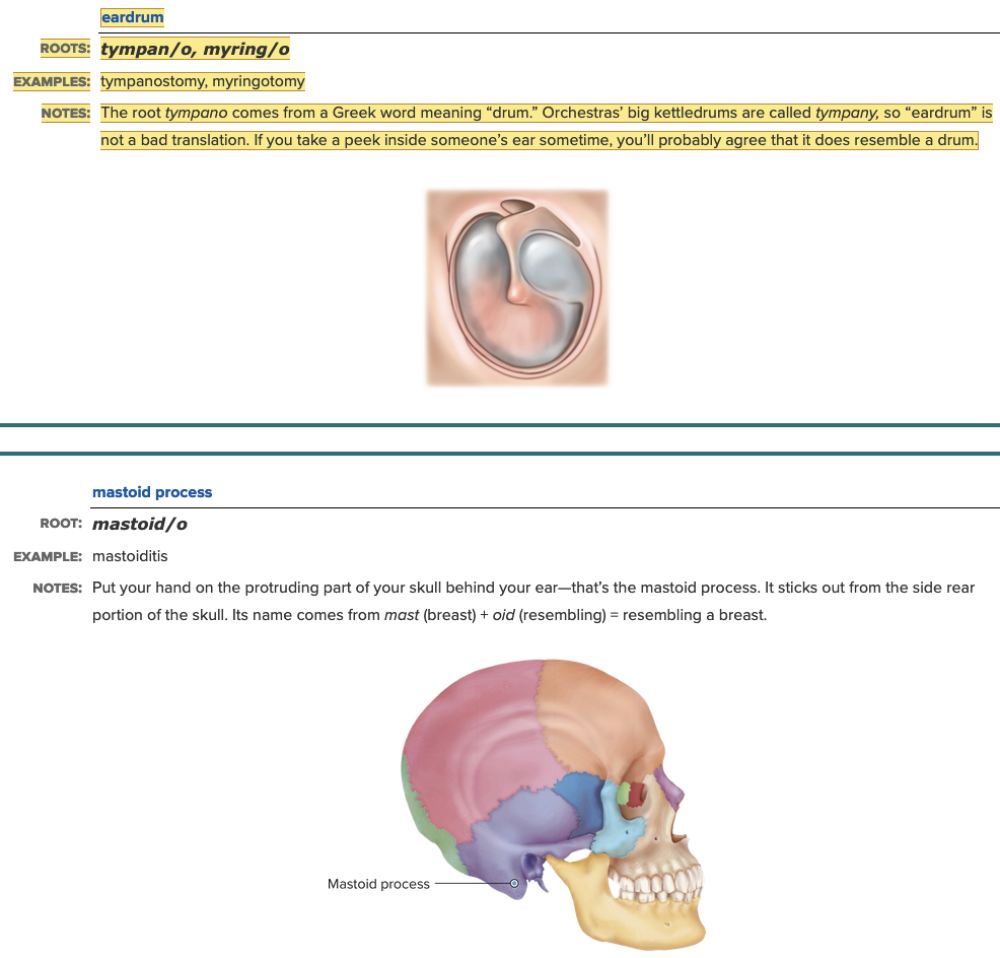
Chapter 6.1 Word Parts of the Sensory System
Word Parts Associated with the Ear: Outer/Middle Ear
- Parts of Sensory System: Root Examples Part 2

Chapter 6.1 Word Parts of the Sensory System
Word Parts Associated with the Ear: Inner Ear
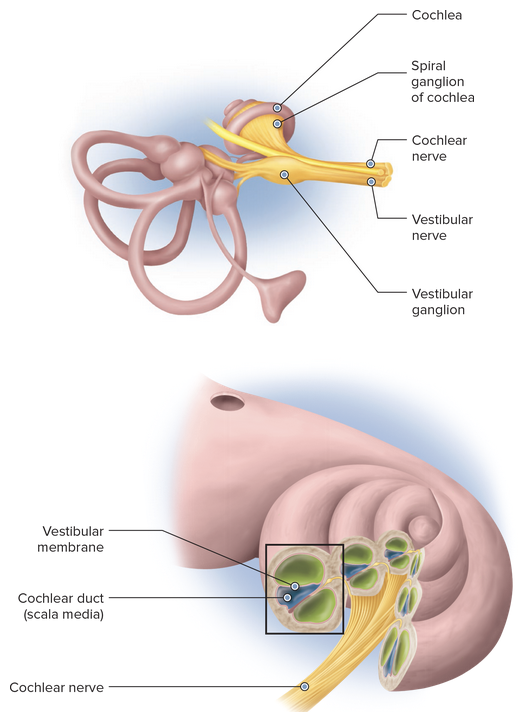
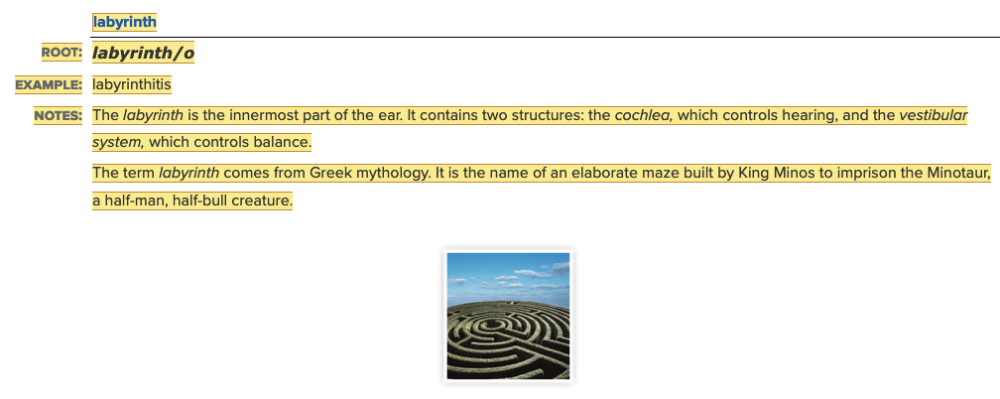
Chapter 6.1 Word Parts of the Sensory System
Word Parts Associated with the Ear: Inner Ear
- Parts of Sensory System: Root Examples Part 1
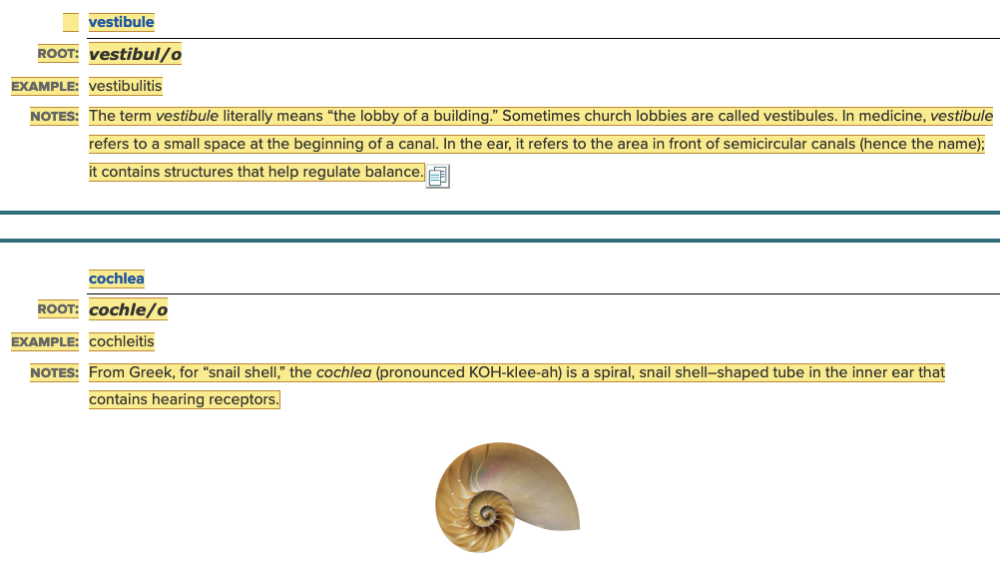
Chapter 6.1 Word Parts of the Sensory System
Word Parts Associated with the Ear: Inner Ear
- Parts of Sensory System: Root Examples Part 2
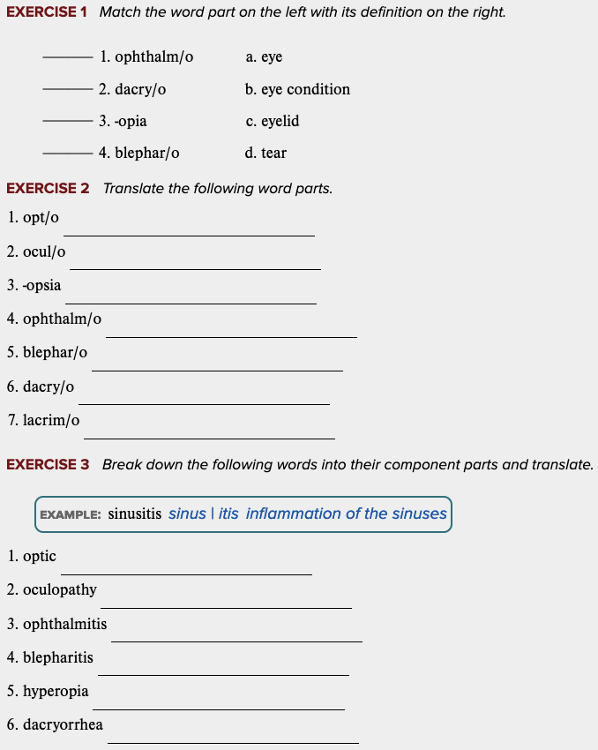
Learning Outcome 6.1 Exercises: Exercise 1, 2, 3.
...
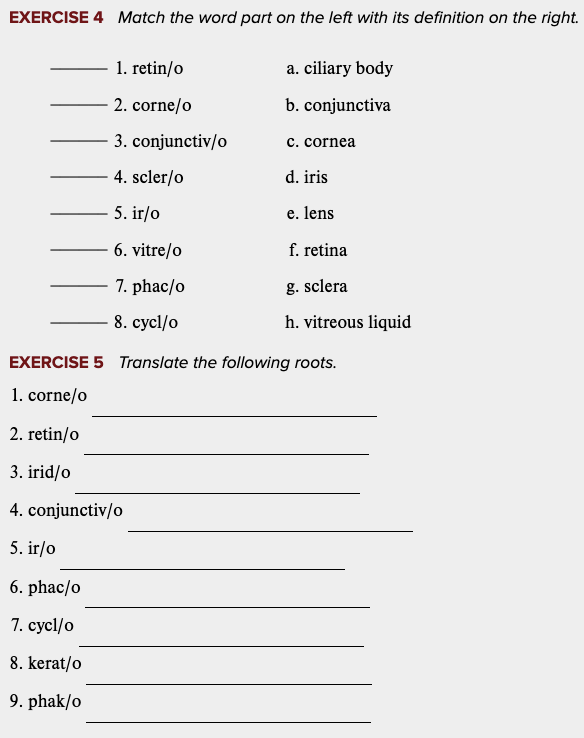
Learning Outcome 6.1 Exercises: Exercise 4, 5.
...
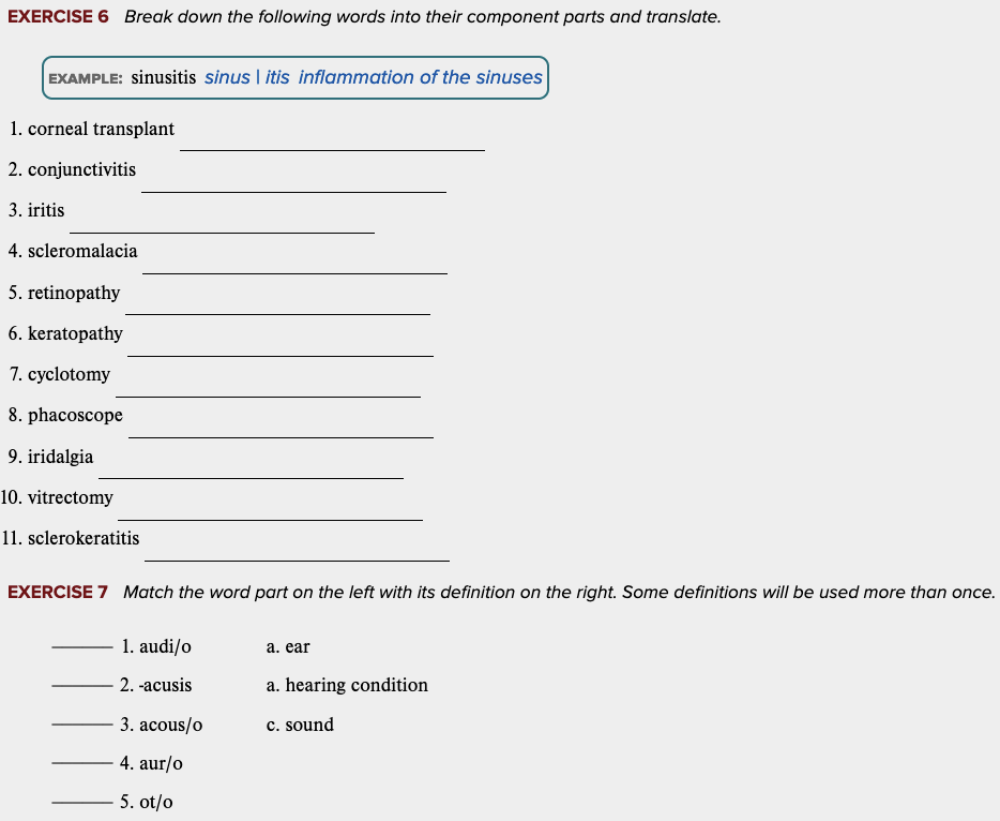
Learning Outcome 6.1 Exercises: Exercise 6, 7.
...
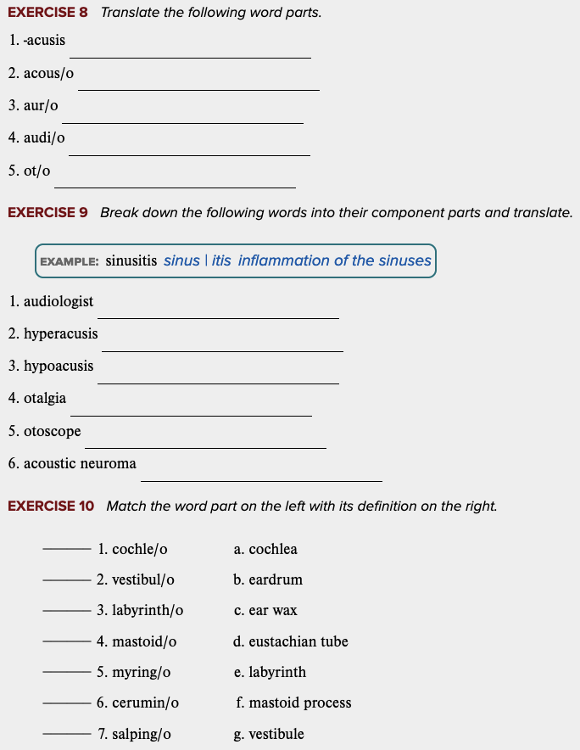
Learning Outcome 6.1 Exercises: Exercise 8, 9, 10.
...
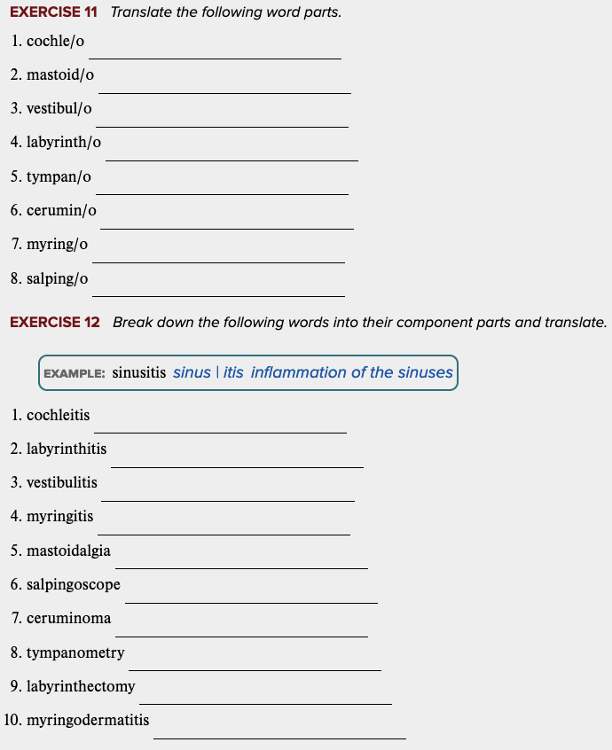
Learning Outcome 6.1 Exercises: Exercise 11, 12.
...
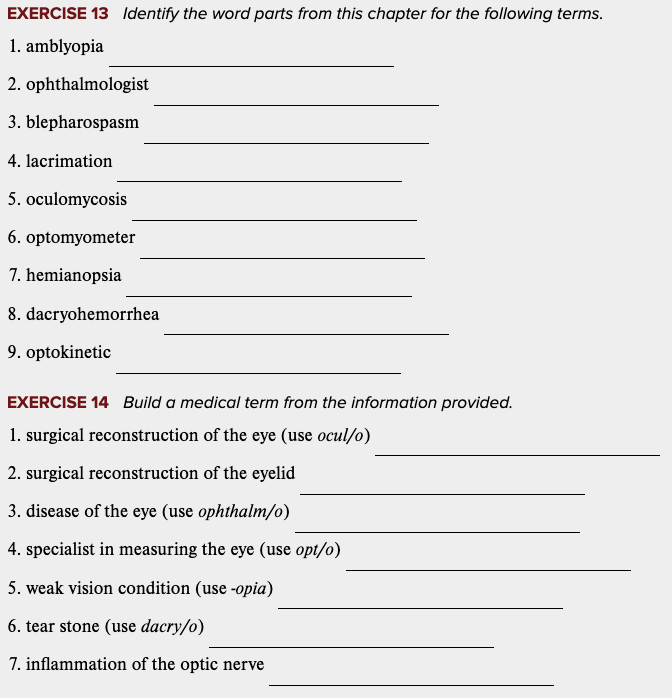
Learning Outcome 6.1 Exercises: Exercise 13, 14.
...
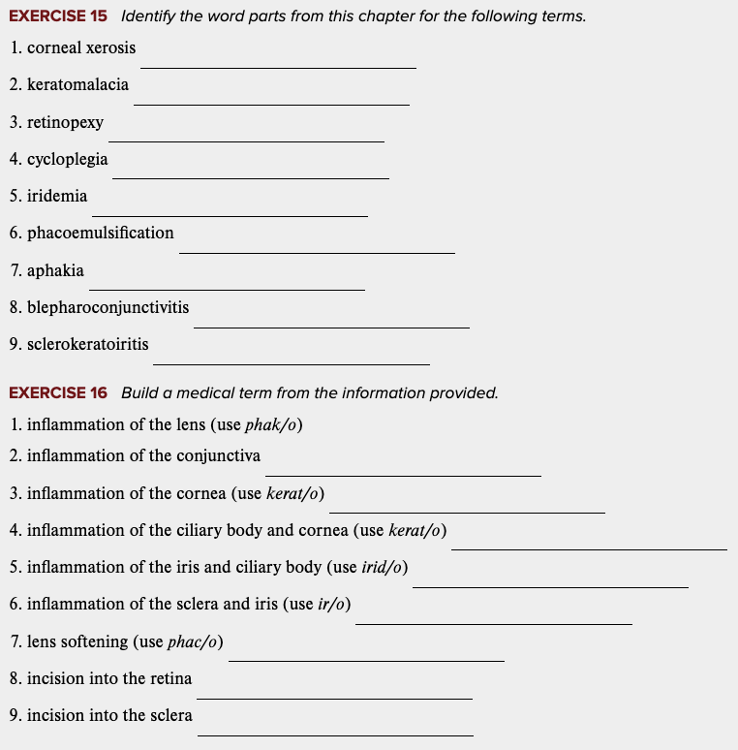
Learning Outcome 6.1 Exercises: Exercise 15, 16.
...
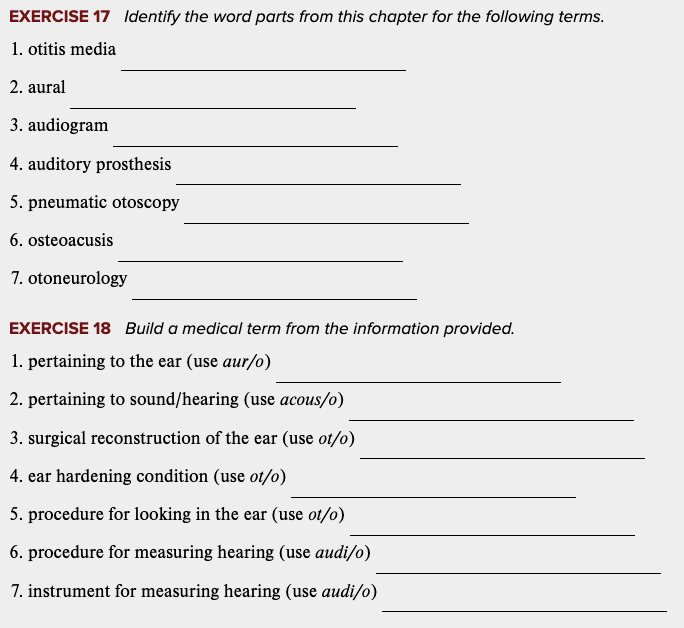
Learning Outcome 6.1 Exercises: Exercise 17, 18.
...
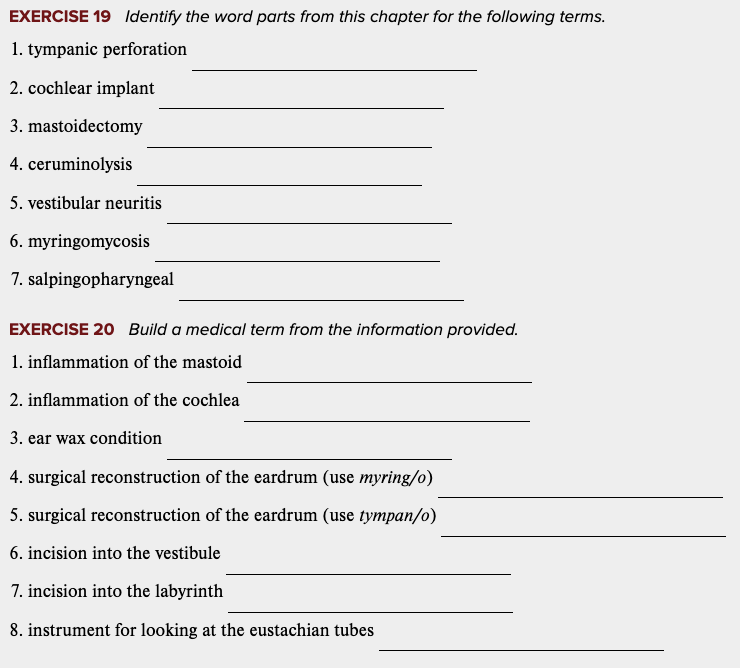
Learning Outcome 6.1 Exercises: Exercise 19, 20.
...
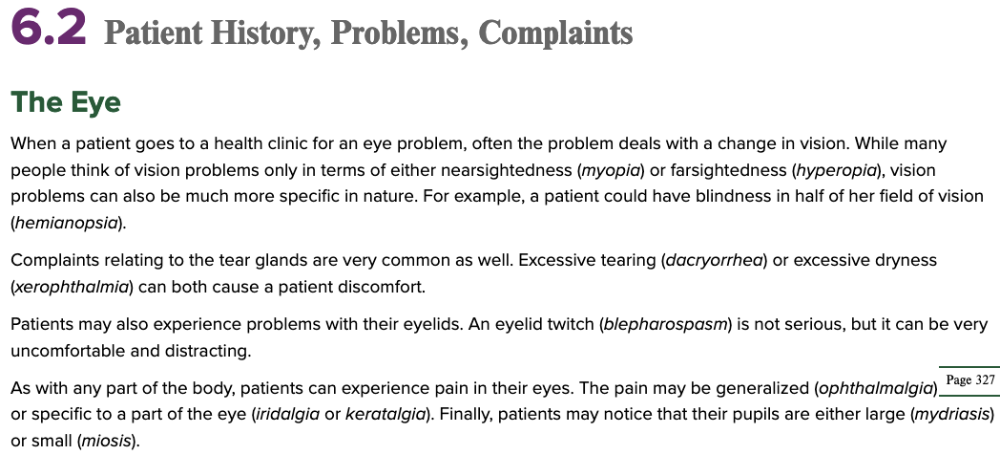
Chapter 6.2 Patient History, Problems, Complaints
- Subjective: The Eye
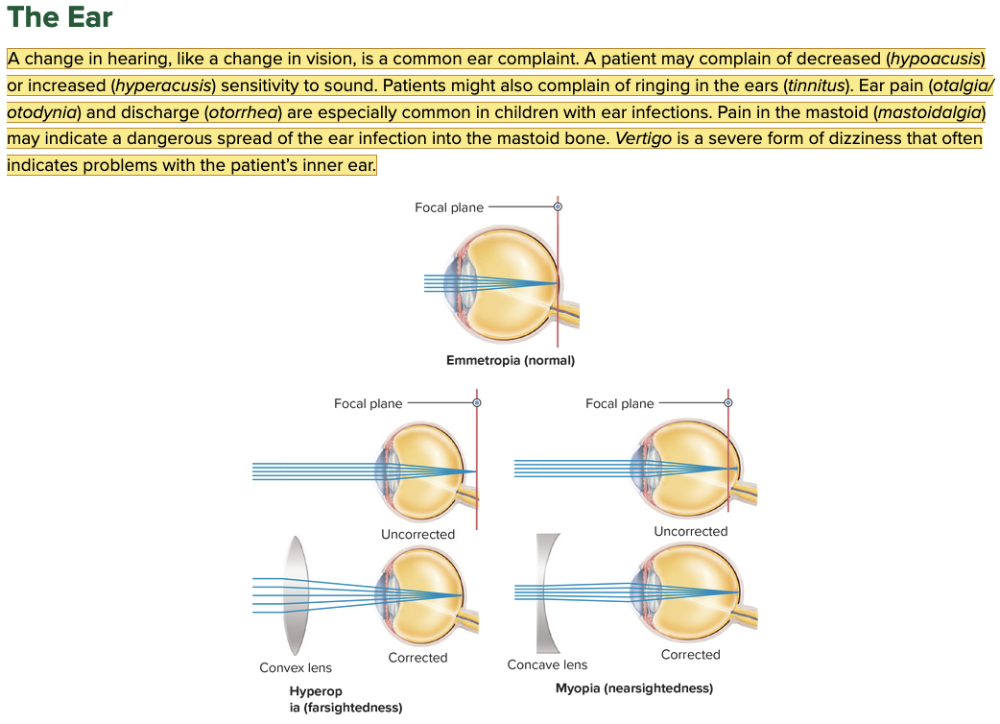
Chapter 6.2 Patient History, Problems, Complaints
- Subjective: The Ear
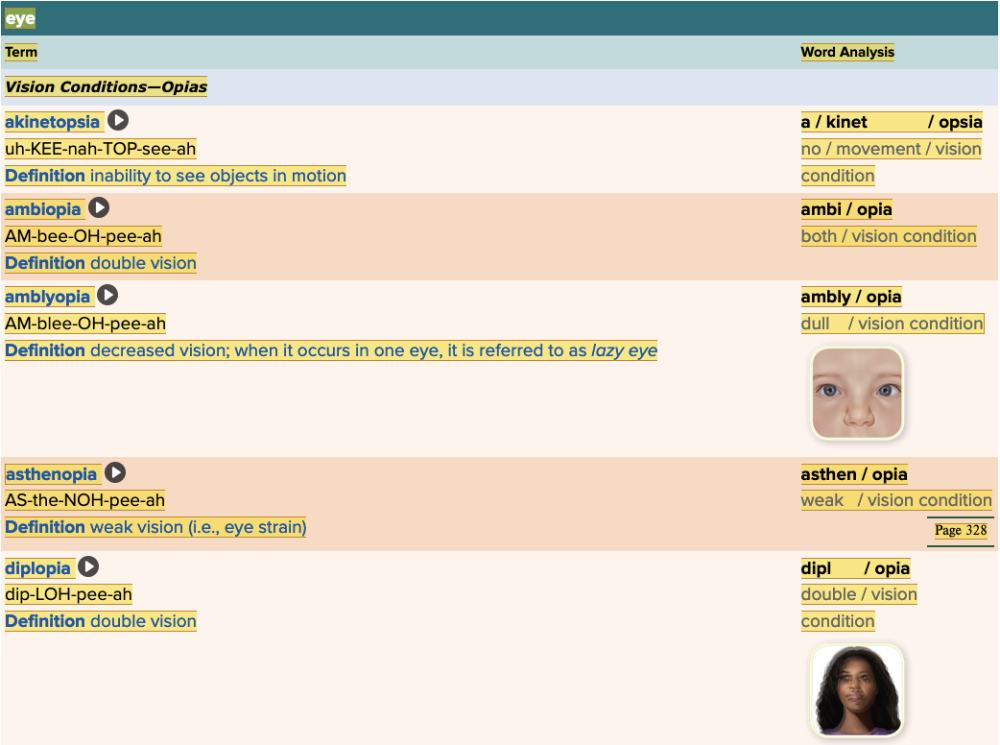
Chapter 6.2 Patient History, Problems, Complaints
- Subjective: The Eye Table - Vision Conditions-Opias Part 1
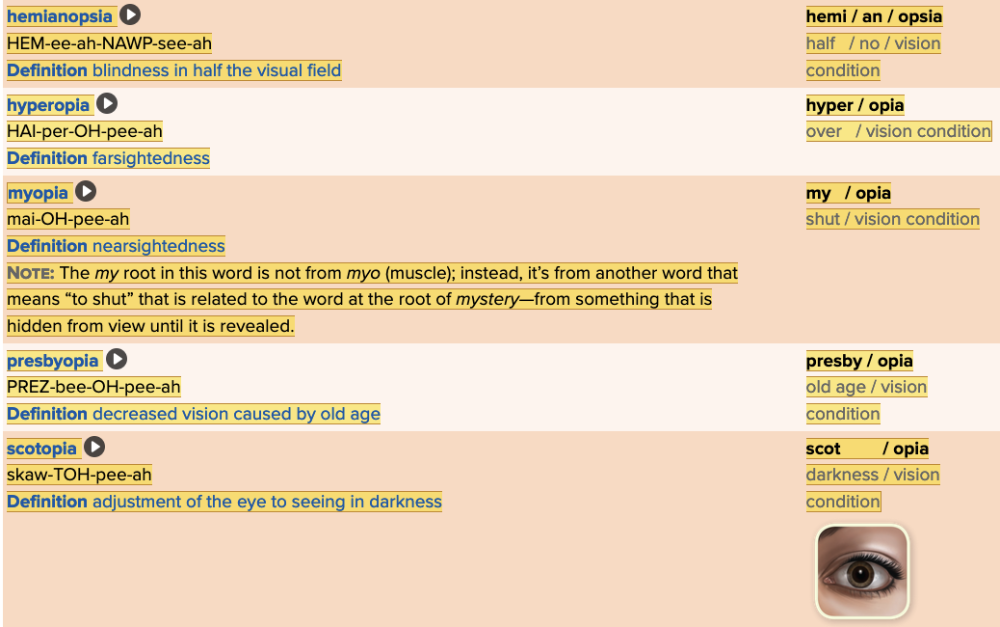
Chapter 6.2 Patient History, Problems, Complaints
- Subjective: The Eye Table - Vision Conditions-Opias Part 2
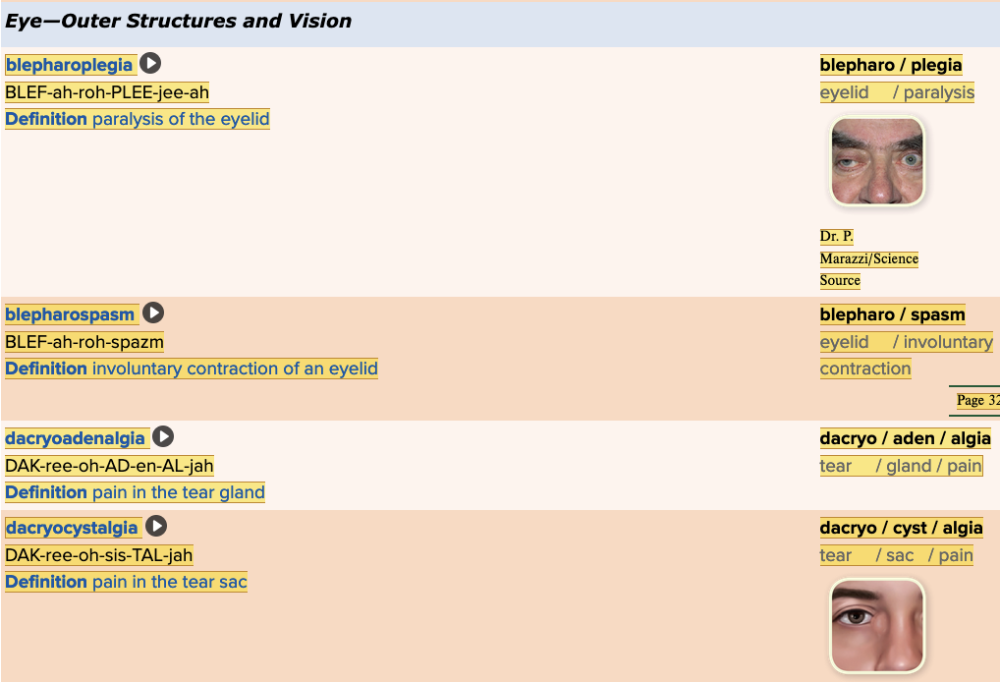
Chapter 6.2 Patient History, Problems, Complaints
- Subjective: The Eye Table - Outer-Eye Structures and Vision Part 1
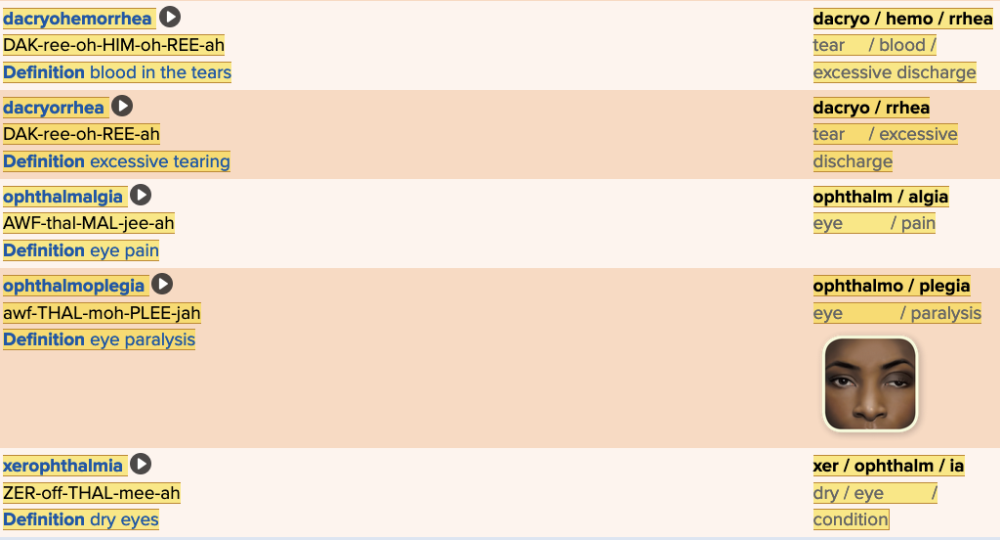
Chapter 6.2 Patient History, Problems, Complaints
- Subjective: The Eye Table - Outer-Eye Structures and Vision Part 2
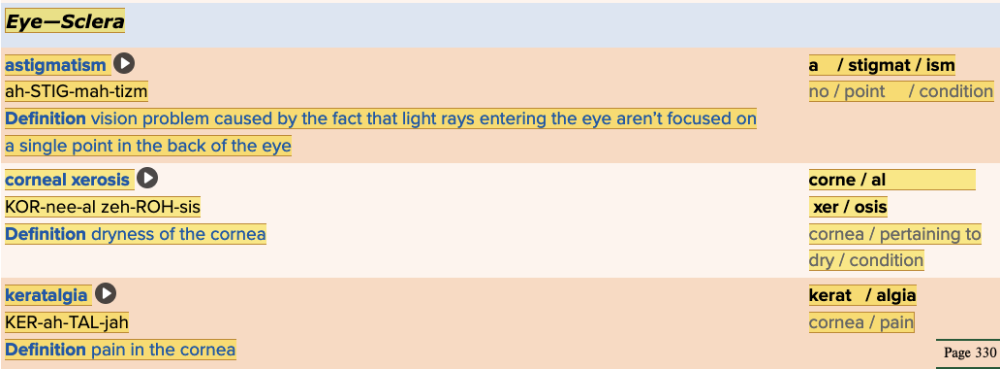
Chapter 6.2 Patient History, Problems, Complaints
- Subjective: The Eye Table - Eye-Sclera
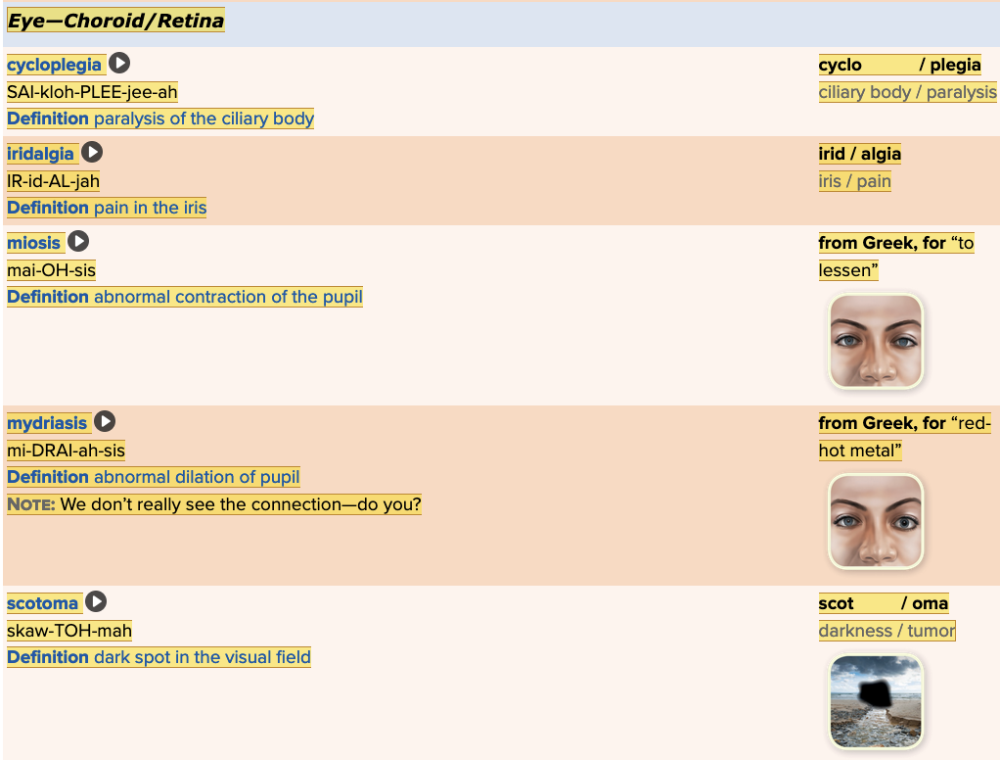
Chapter 6.2 Patient History, Problems, Complaints
- Subjective: The Eye Table - Eye-Choroid/Retina
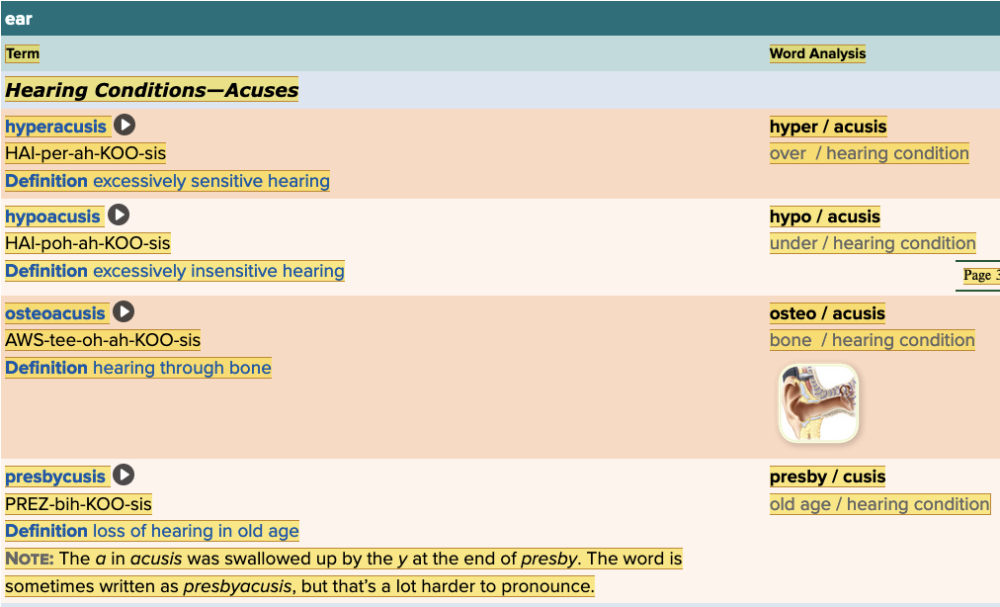
Chapter 6.2 Patient History, Problems, Complaints
- Subjective: The Ear Table - Hearing Conditions-Acuses
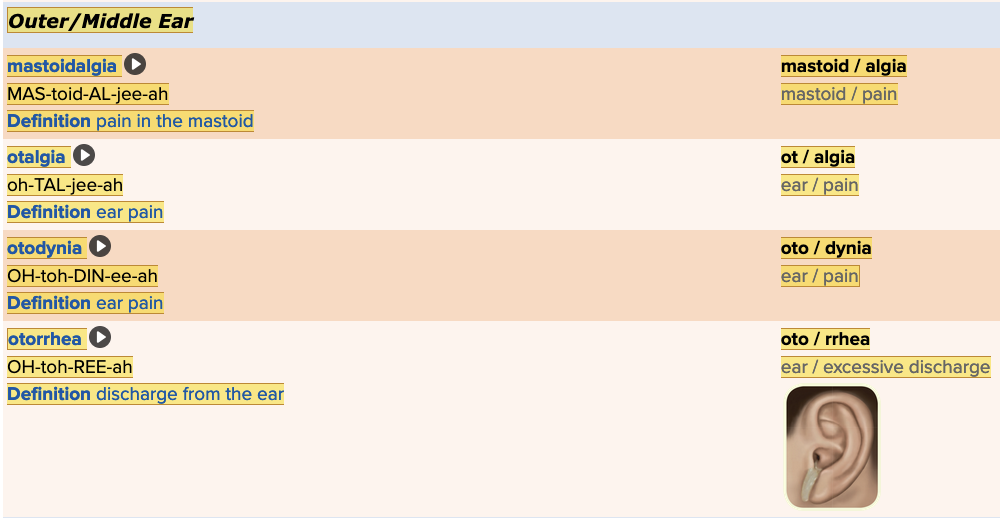
Chapter 6.2 Patient History, Problems, Complaints
- Subjective: The Ear Table - Outer/Middle Ear
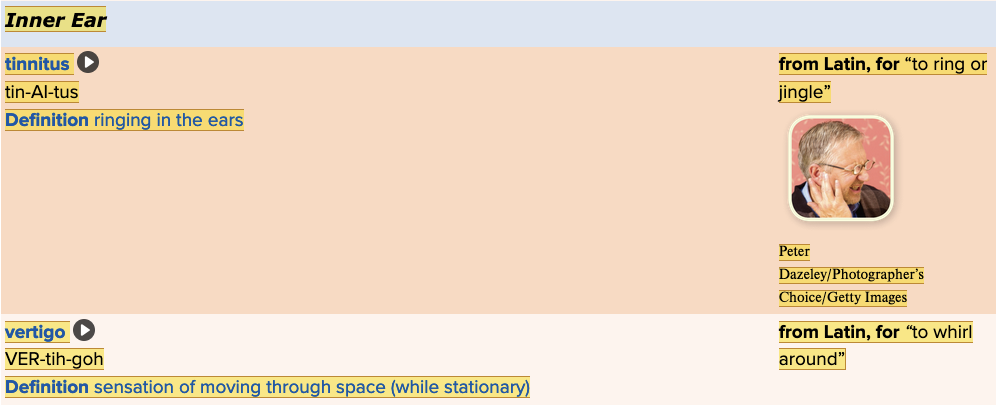
Chapter 6.2 Patient History, Problems, Complaints
- Subjective: The Ear Table - Inner Ear
...
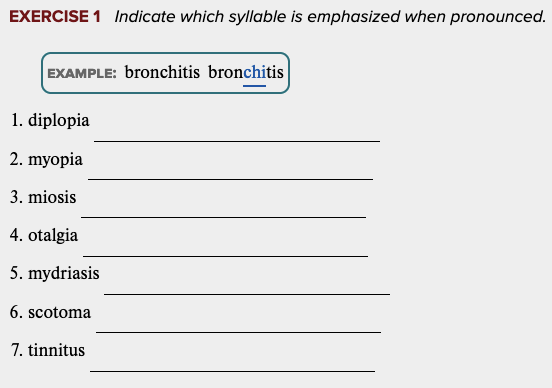
Learning Outcome 6.2 Exercises: Exercise 1.
...
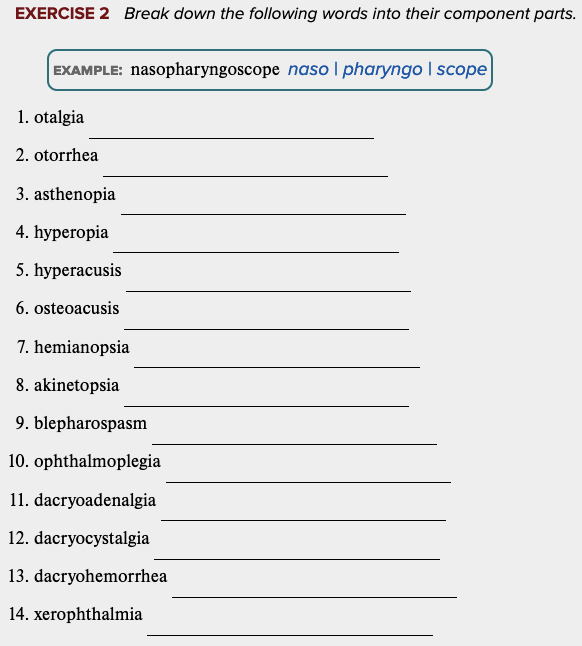
Learning Outcome 6.2 Exercises: Exercise 2.
...
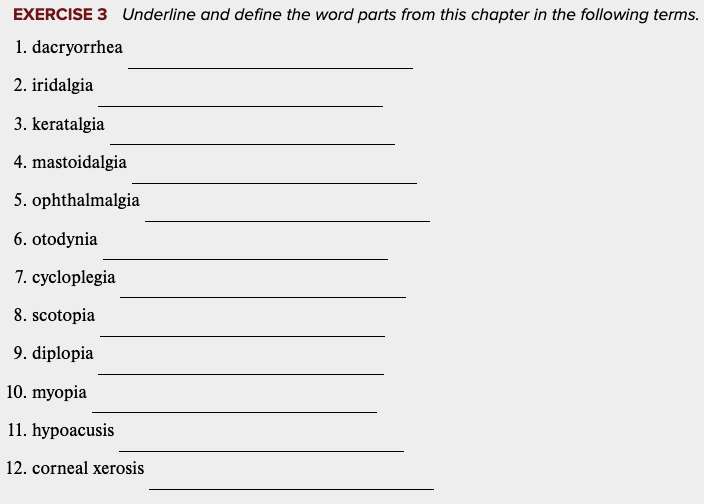
Learning Outcome 6.2 Exercises: Exercise 3.
...
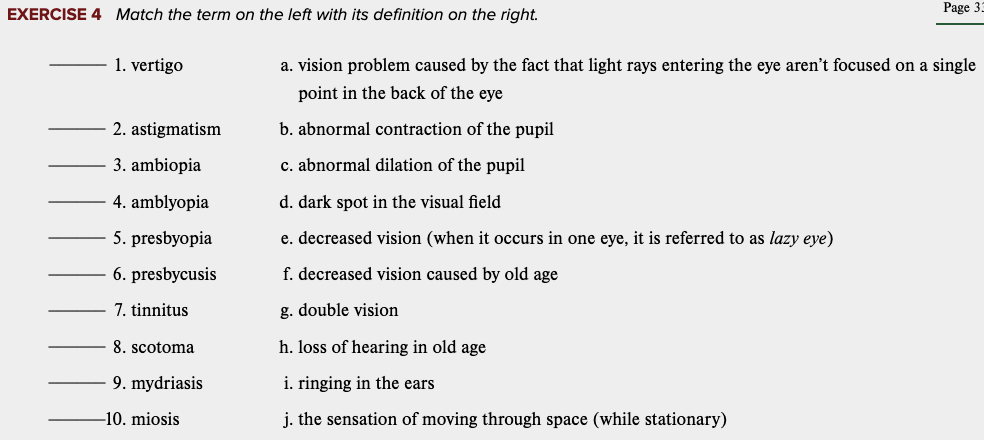
Learning Outcome 6.2 Exercises: Exercise 4.
...
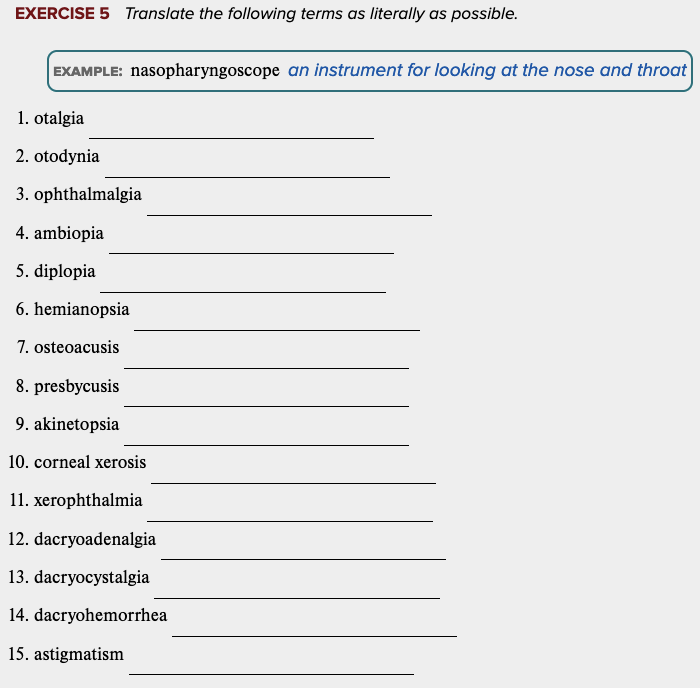
Learning Outcome 6.2 Exercises: Exercise 5.
...
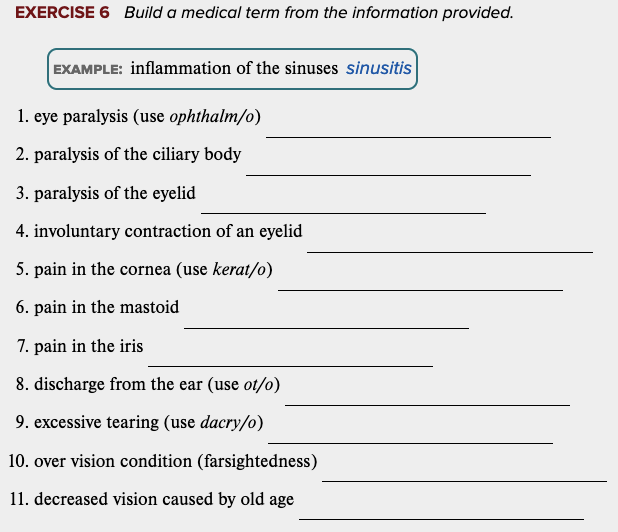
Learning Outcome 6.2 Exercises: Exercise 6.
...
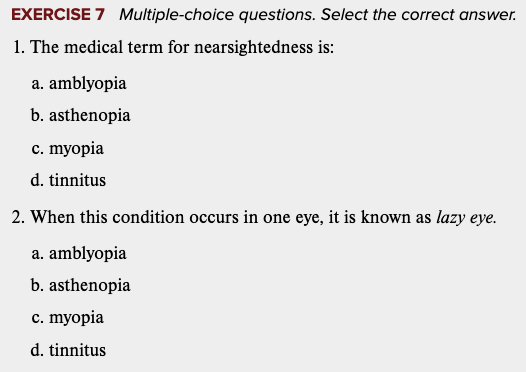
Learning Outcome 6.2 Exercises: Exercise 7.
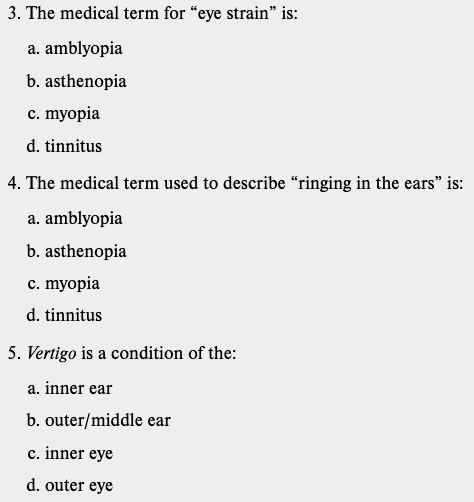
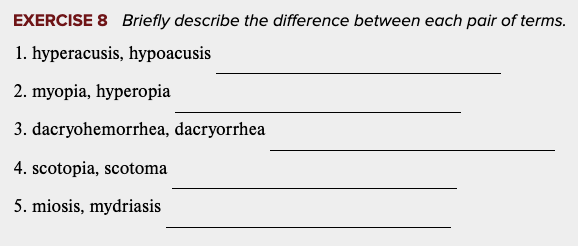
Learning Outcome 6.2 Exercises: Exercise 8.
...
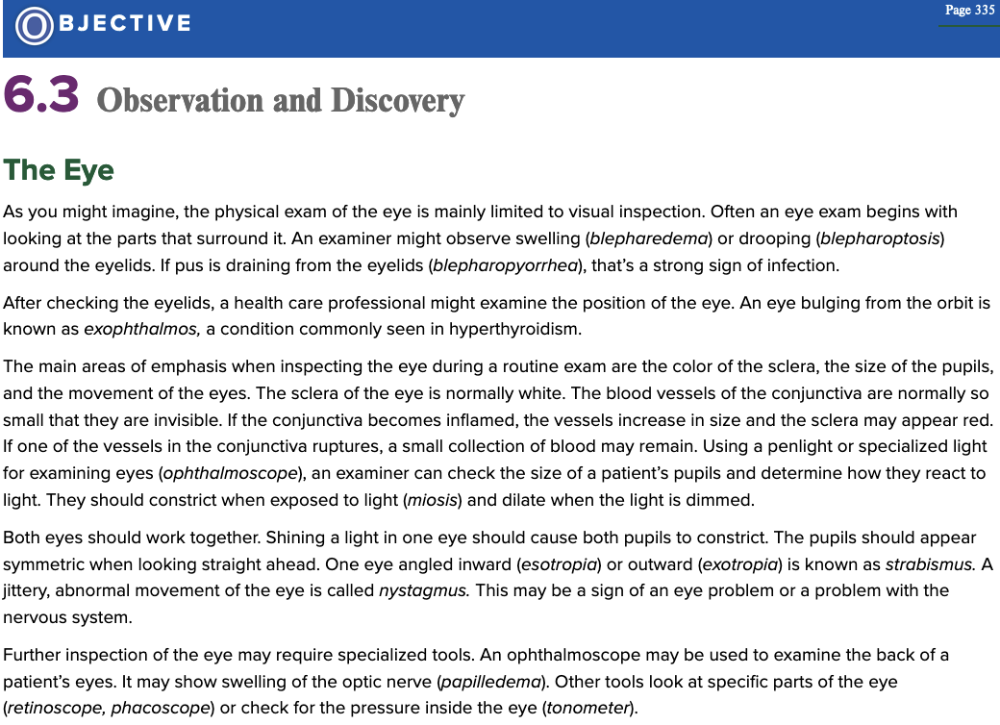
Chapter 6.3 Observation and Discovery
- Objective: The Eye
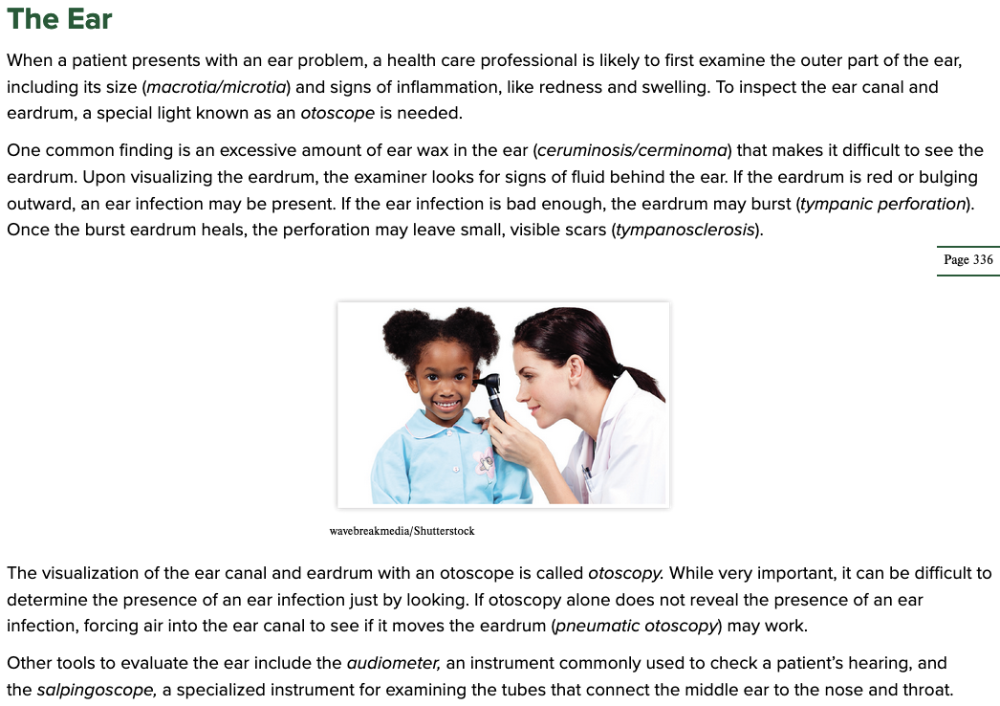
Chapter 6.3 Observation and Discovery
- Objective: The Ear
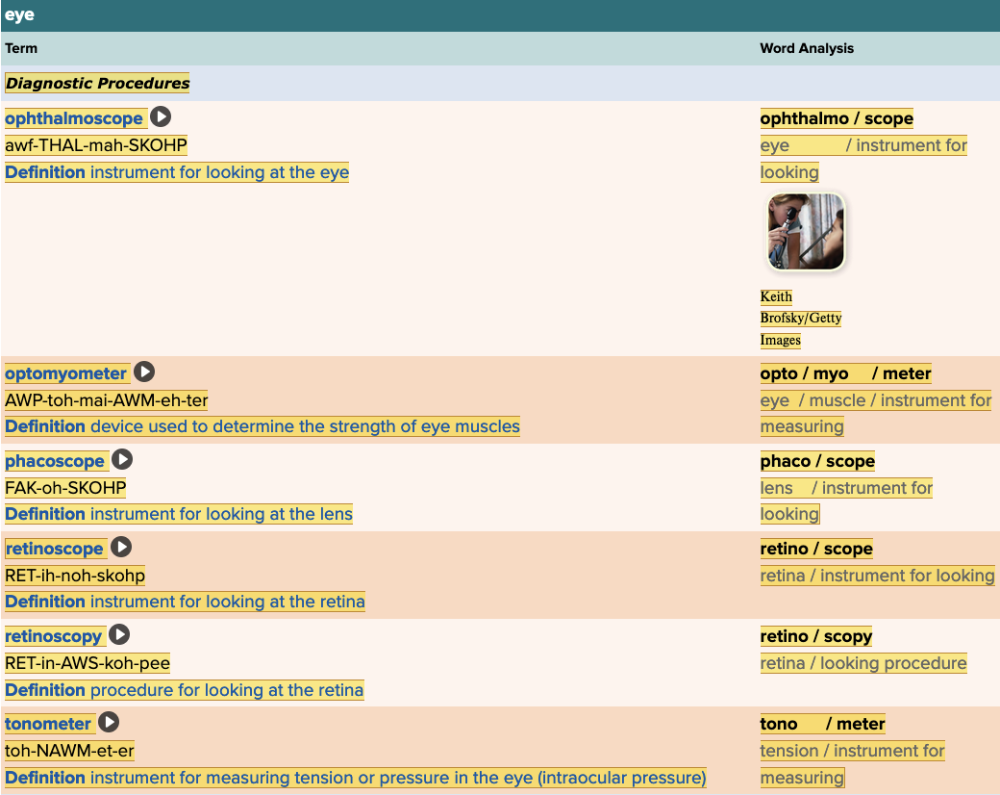
Chapter 6.3 Observation and Discovery
- Objective: The Eye Table - Diagnostic Procedures
...
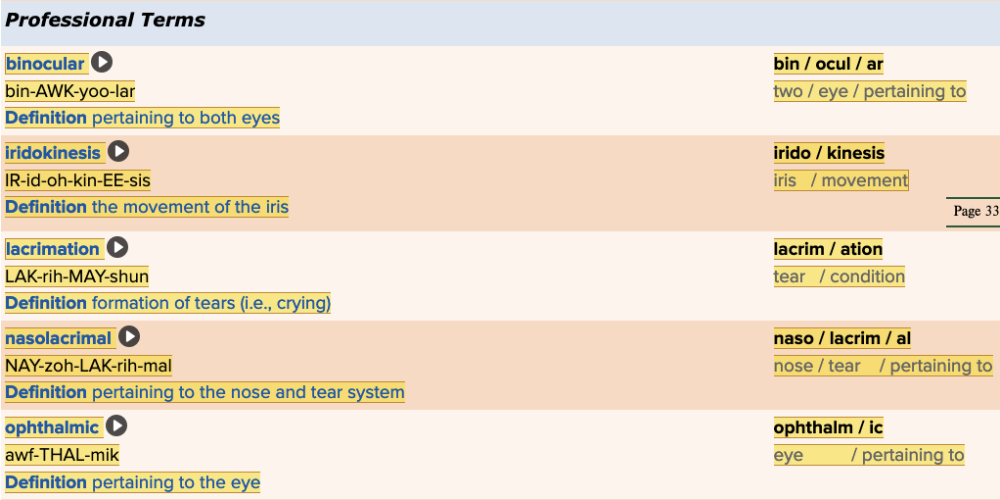
Chapter 6.3 Observation and Discovery
- Objective: The Eye Table - Professional Terms Part 1
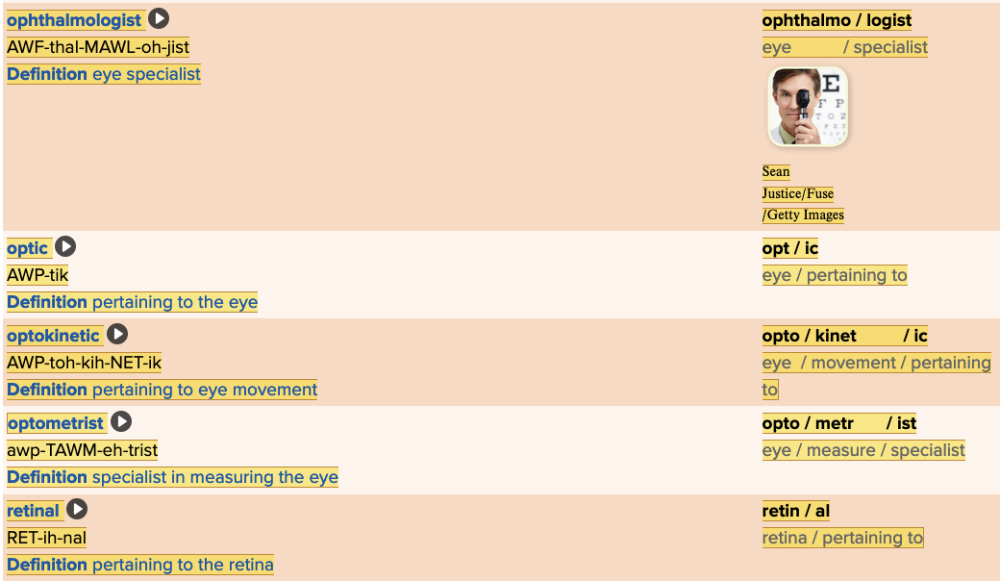
Chapter 6.3 Observation and Discovery
- Objective: The Eye Table - Professional Terms Part 2
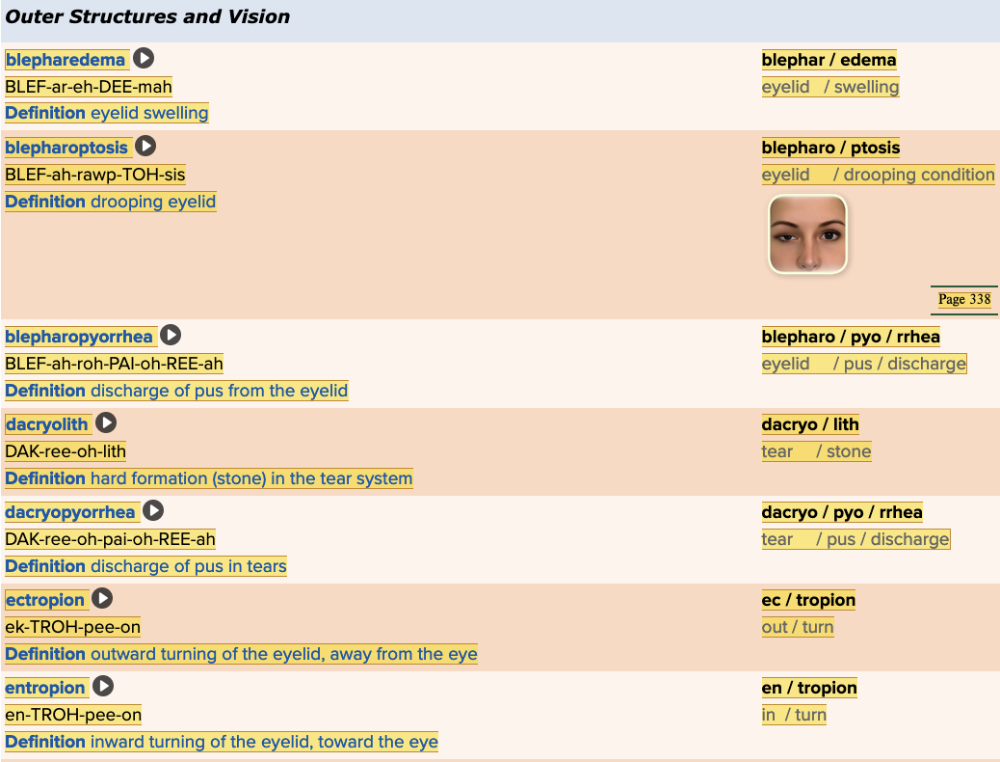
Chapter 6.3 Observation and Discovery
- Objective: The Eye Table - Outer Structures and Vision Part 1
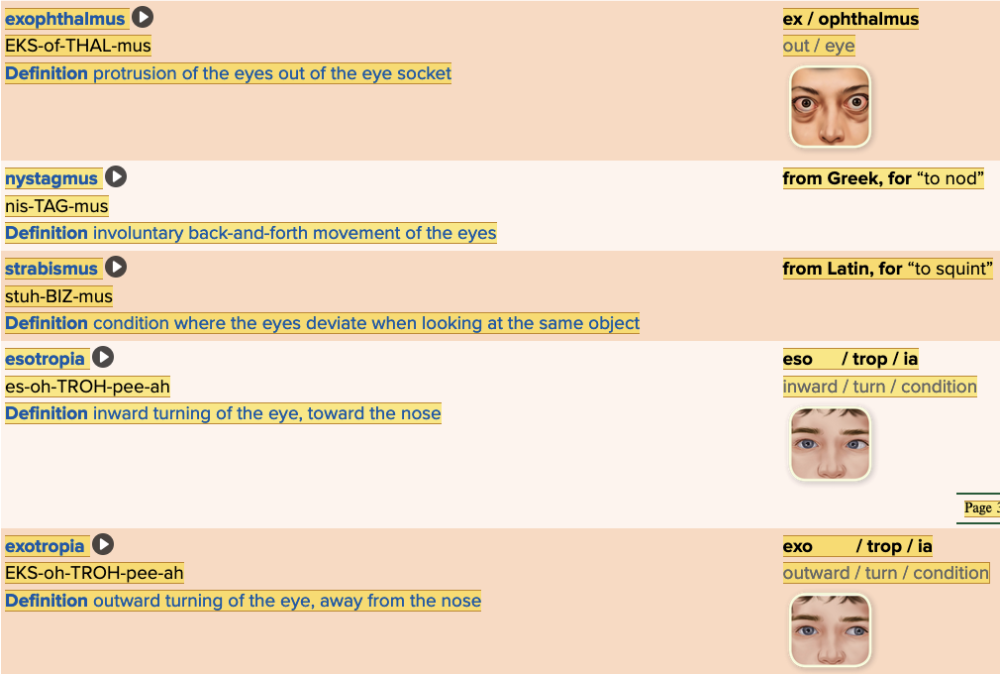
Chapter 6.3 Observation and Discovery
- Objective: The Eye Table - Outer Structures and Vision Part 2
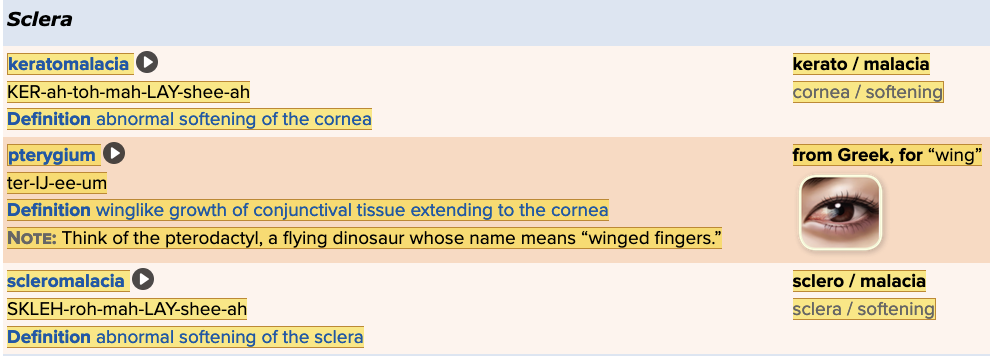
Chapter 6.3 Observation and Discovery
- Objective: The Eye Table - Sclera
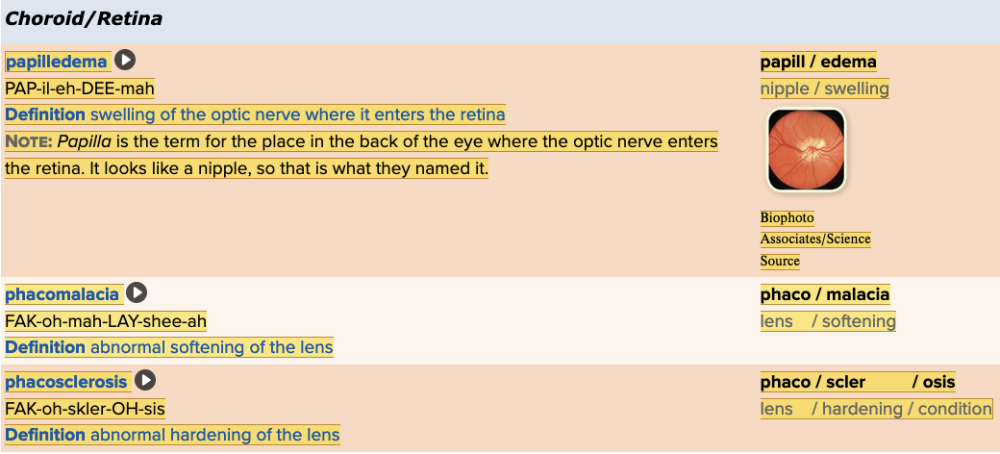
Chapter 6.3 Observation and Discovery
- Objective: The Eye Table - Choroid/Retina
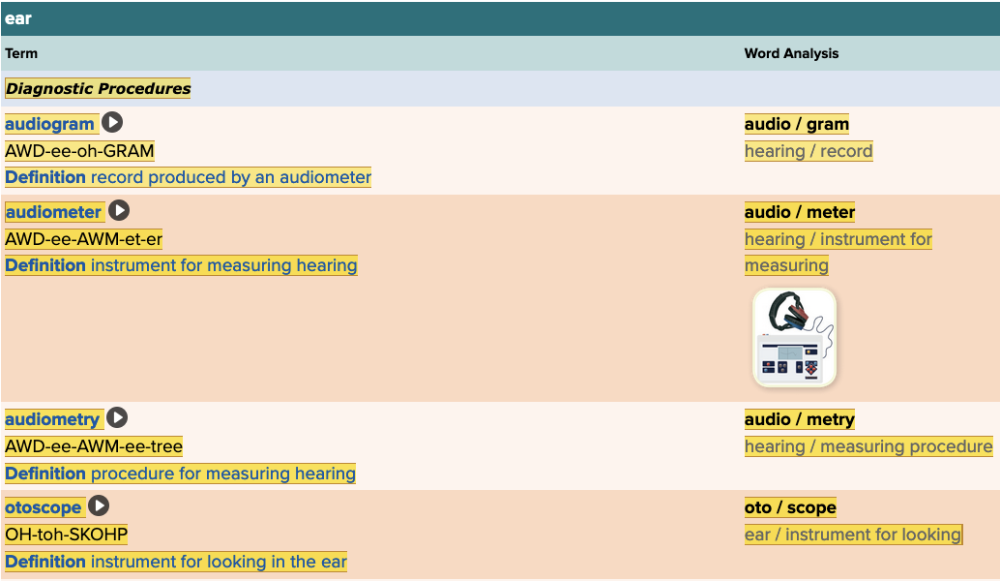
Chapter 6.3 Observation and Discovery
- Objective: The Ear Table - Diagnostic Procedures Part 1
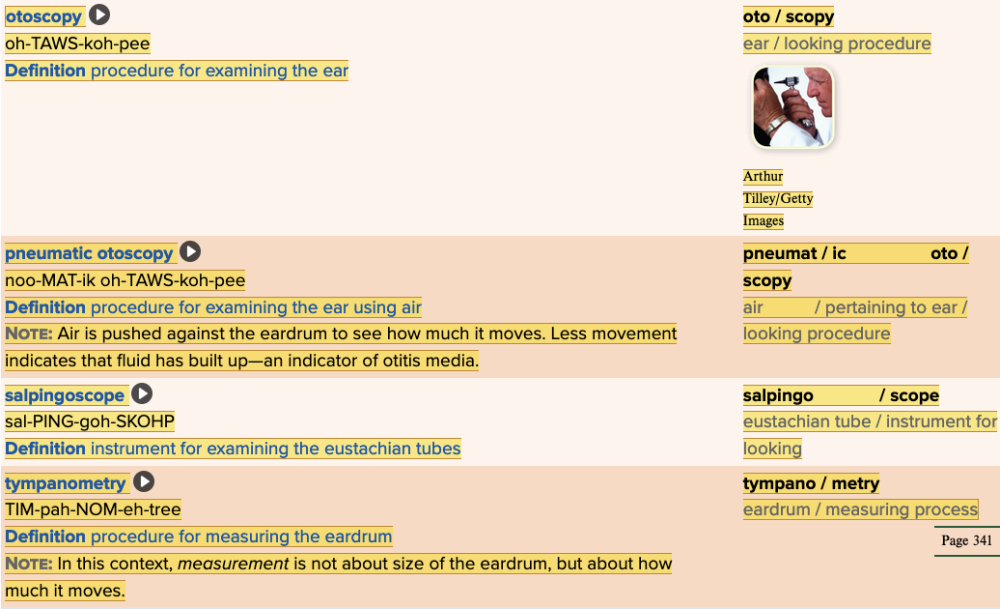
Chapter 6.3 Observation and Discovery
- Objective: The Ear Table - Diagnostic Procedures Part 2
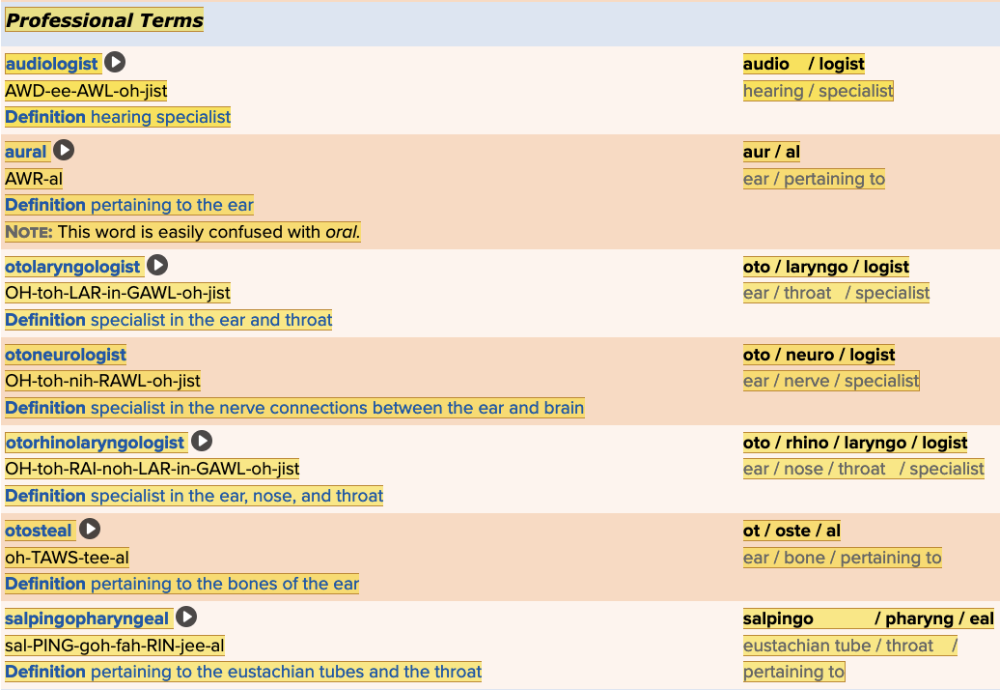
Chapter 6.3 Observation and Discovery
- Objective: The Ear Table - Professional Terms
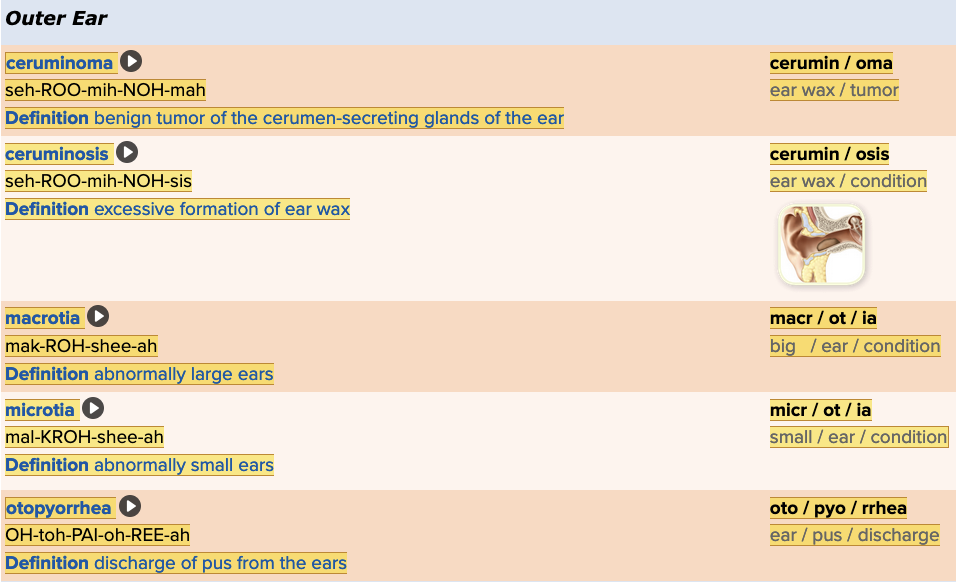
Chapter 6.3 Observation and Discovery
- Objective: The Ear Table - Outer Ear
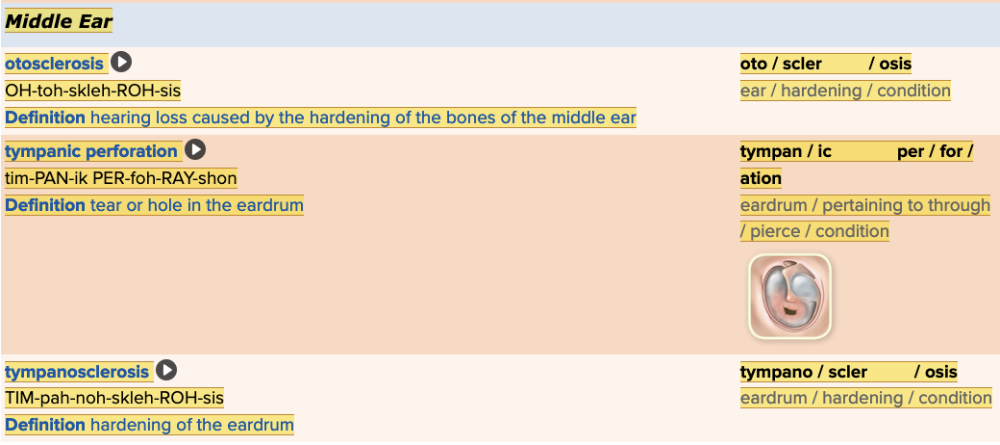
Chapter 6.3 Observation and Discovery
- Objective: The Ear Table - Middle Ear
...
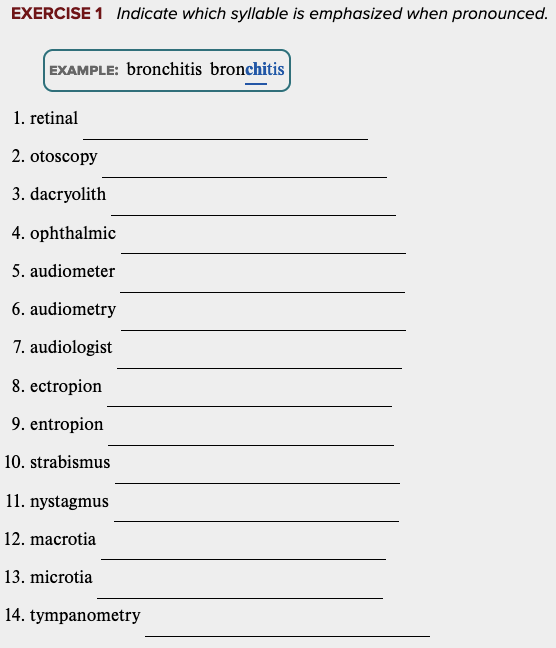
Learning Outcome 6.3 Exercises: Exercise 1.
...
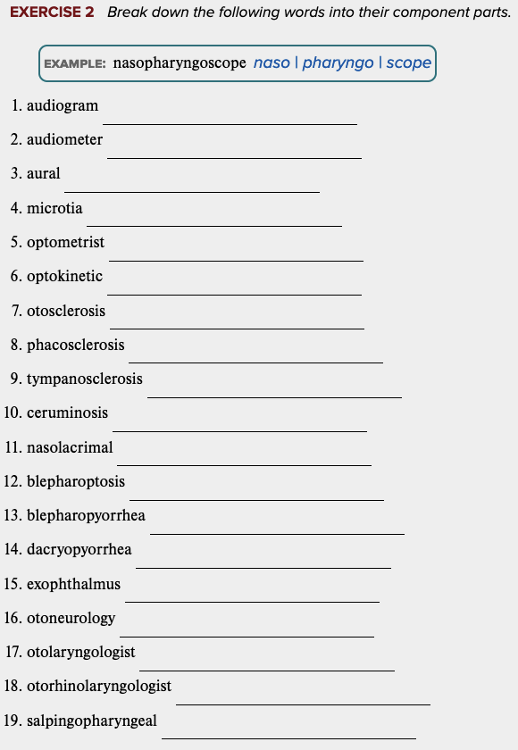
Learning Outcome 6.3 Exercises: Exercise 2.
...
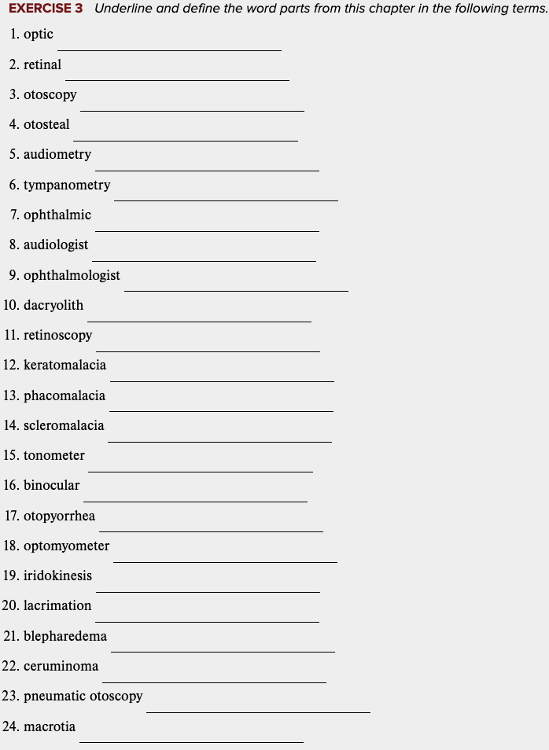
Learning Outcome 6.3 Exercises: Exercise 3.
...
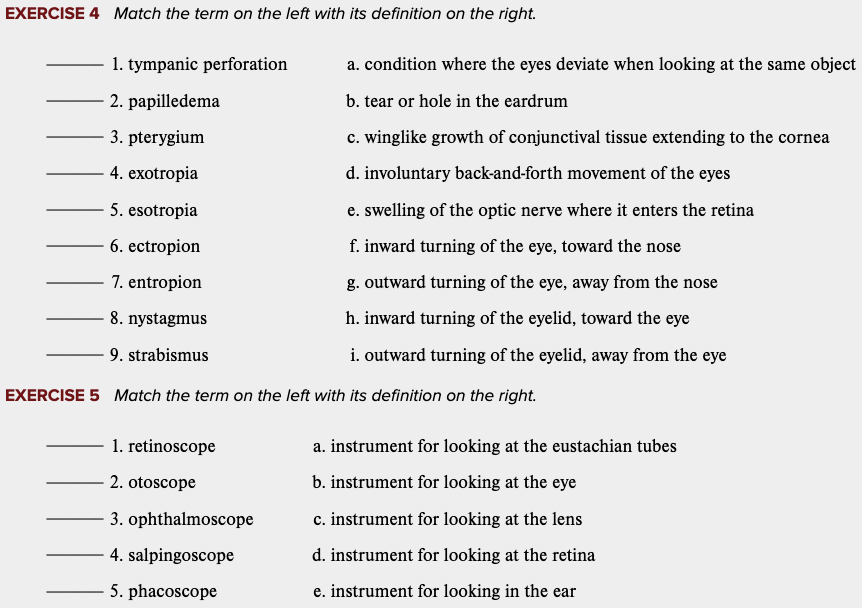
Learning Outcome 6.3 Exercises: Exercise 4, 5.
...
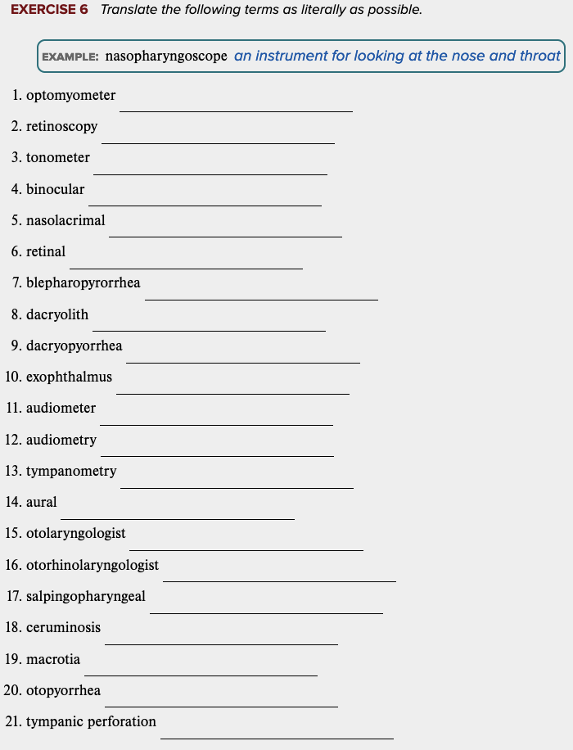
Learning Outcome 6.3 Exercises: Exercise 6.
...
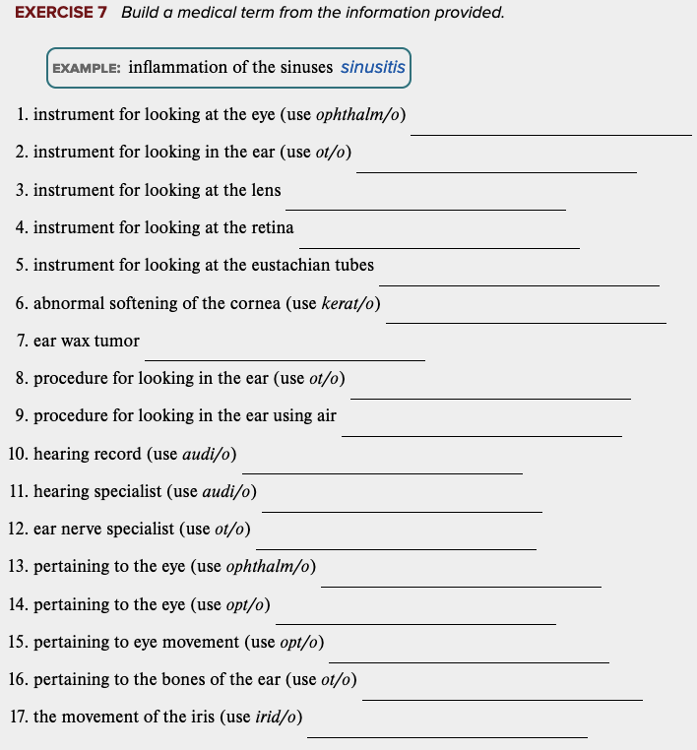
Learning Outcome 6.3 Exercises: Exercise 7.
...
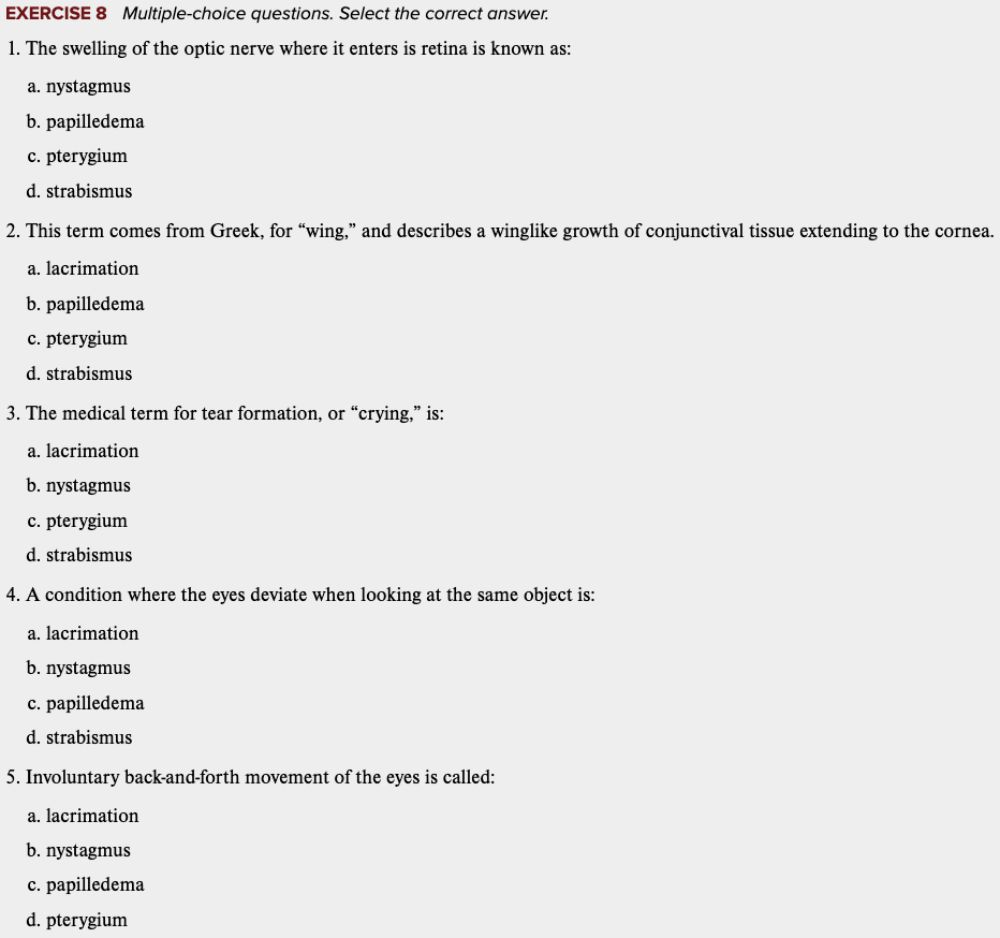
Learning Outcome 6.3 Exercises: Exercise 8.
...
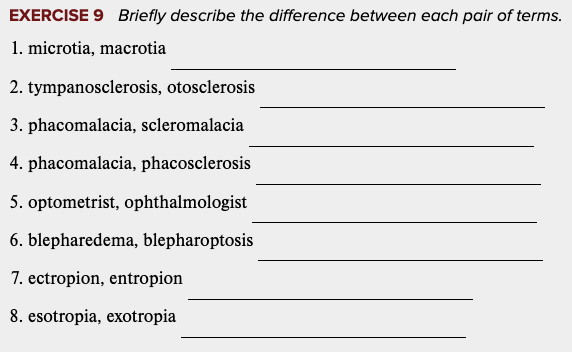
Learning Outcome 6.3 Exercises: Exercise 9.
...
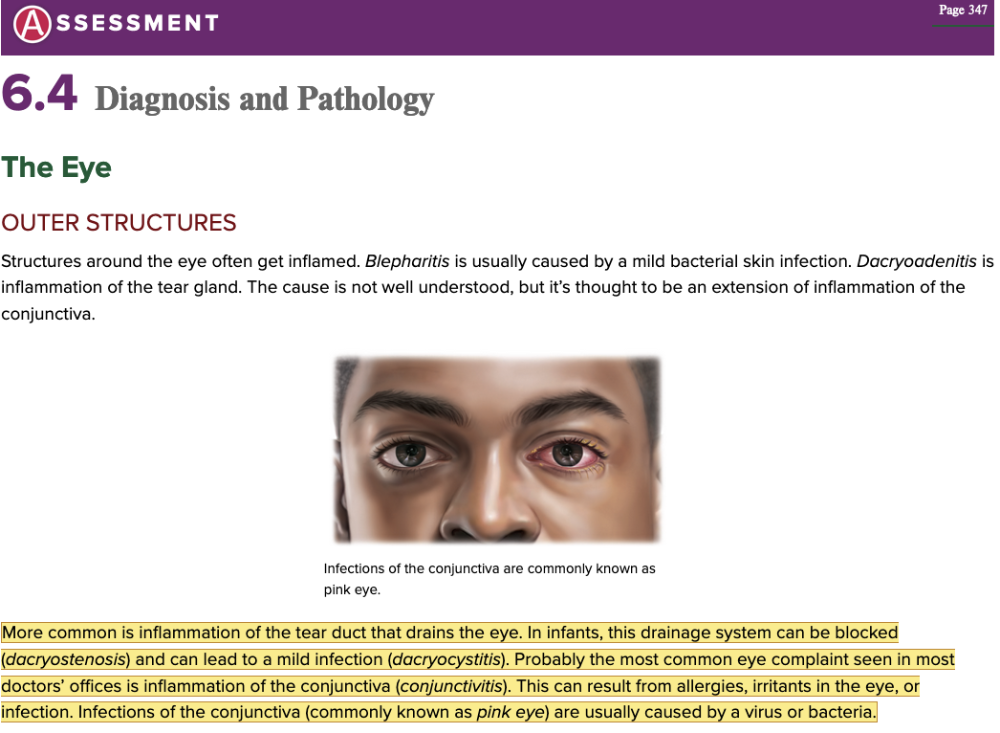
Chapter 6.4 Diagnosis and Pathology
- Assessment: The Eye
- Outer Structures
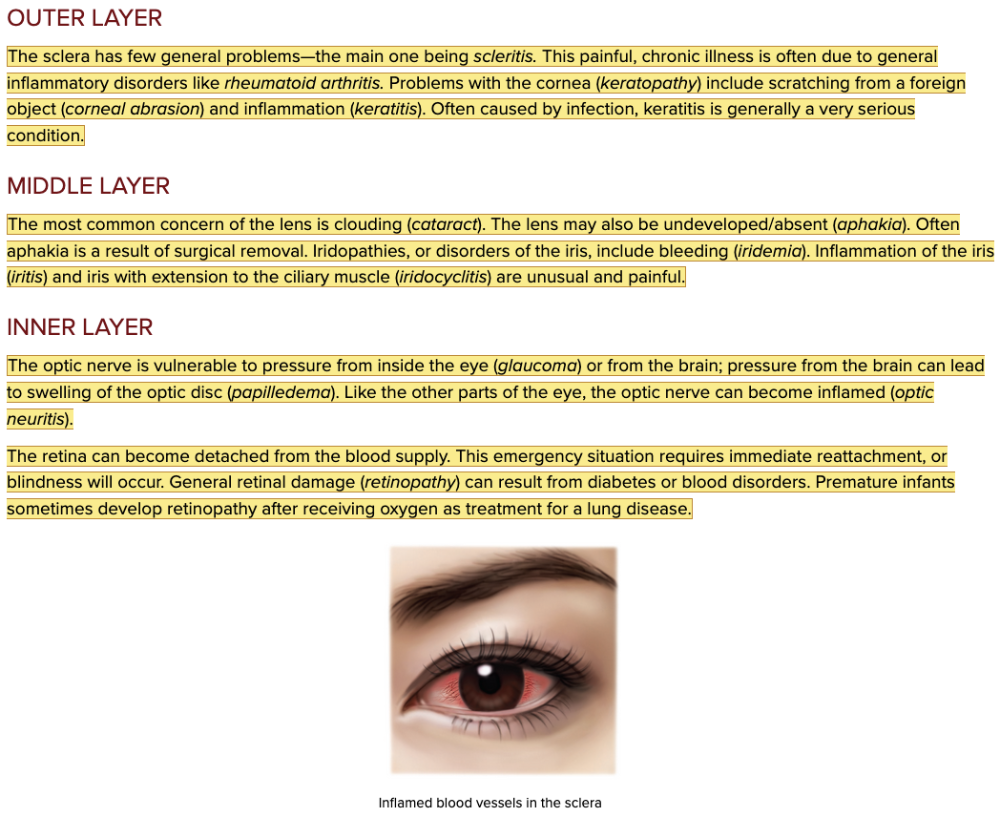
Chapter 6.4 Diagnosis and Pathology
- Assessment: The Eye
- Outer Layer, Middle Layer, Inner Layer

Chapter 6.4 Diagnosis and Pathology
- Assessment: The Ear
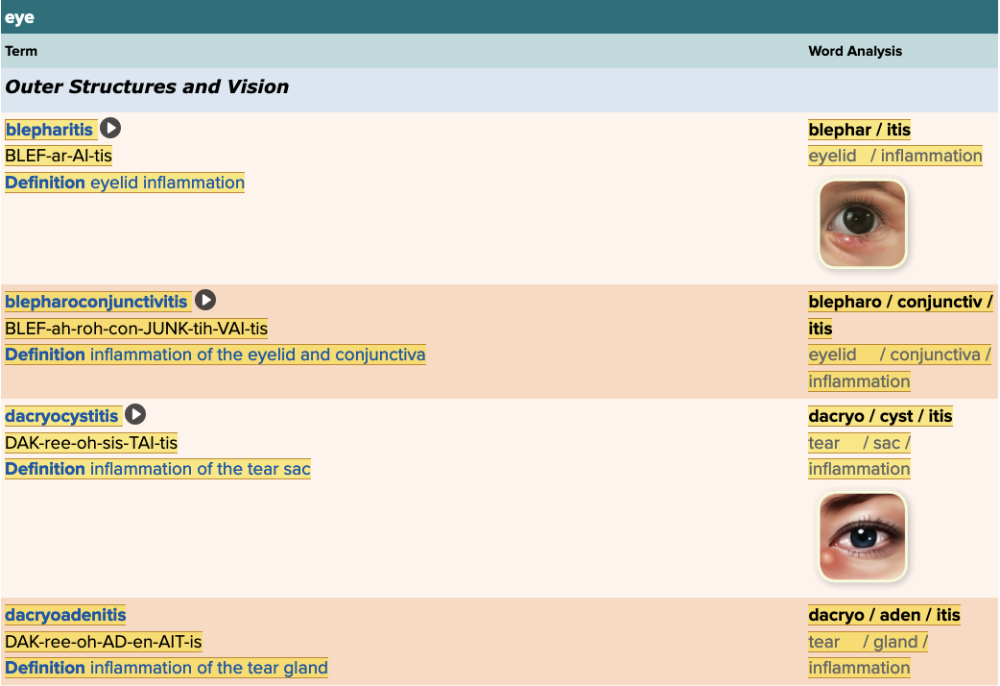
Chapter 6.4 Diagnosis and Pathology
- Assessment: The Ear
- The Eye Table - Outer Structures and Vision Part 1
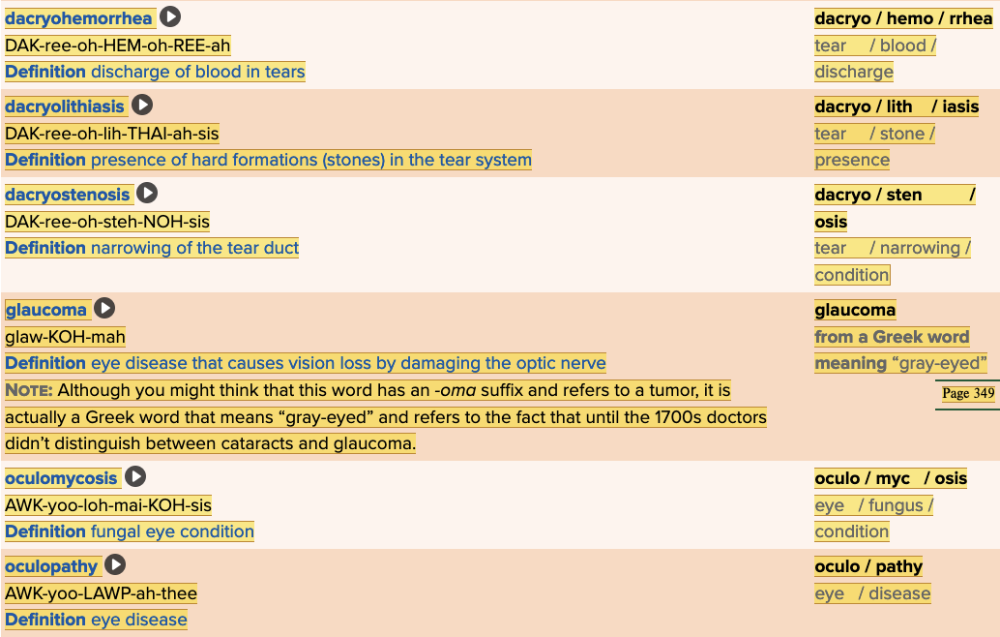
Chapter 6.4 Diagnosis and Pathology
- Assessment: The Ear
- The Eye Table - Outer Structures and Vision Part 2
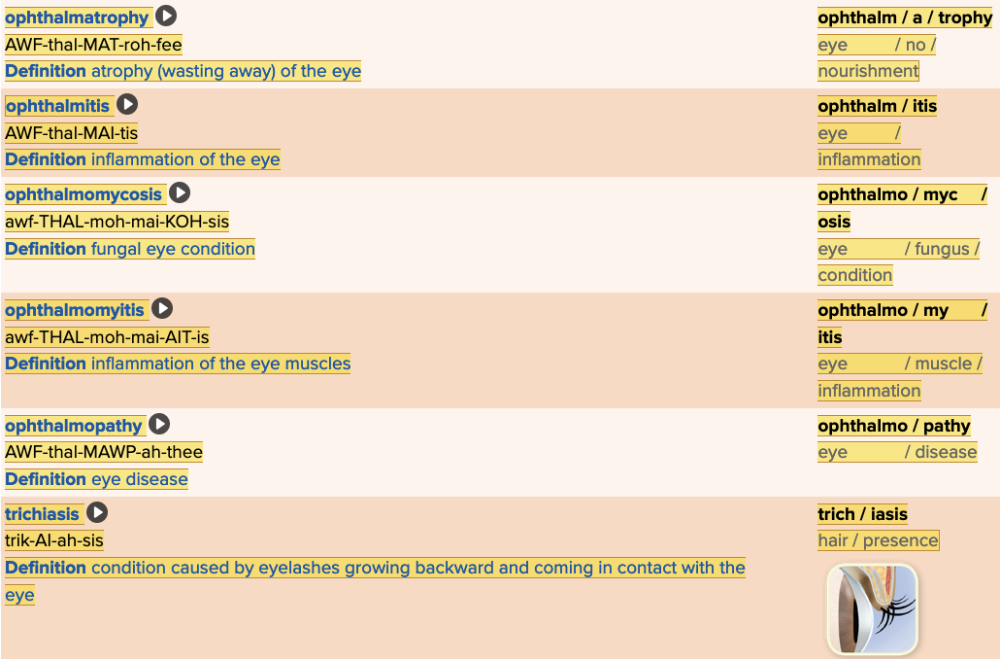
Chapter 6.4 Diagnosis and Pathology
- Assessment: The Ear
- The Eye Table - Outer Structures and Vision Part 3
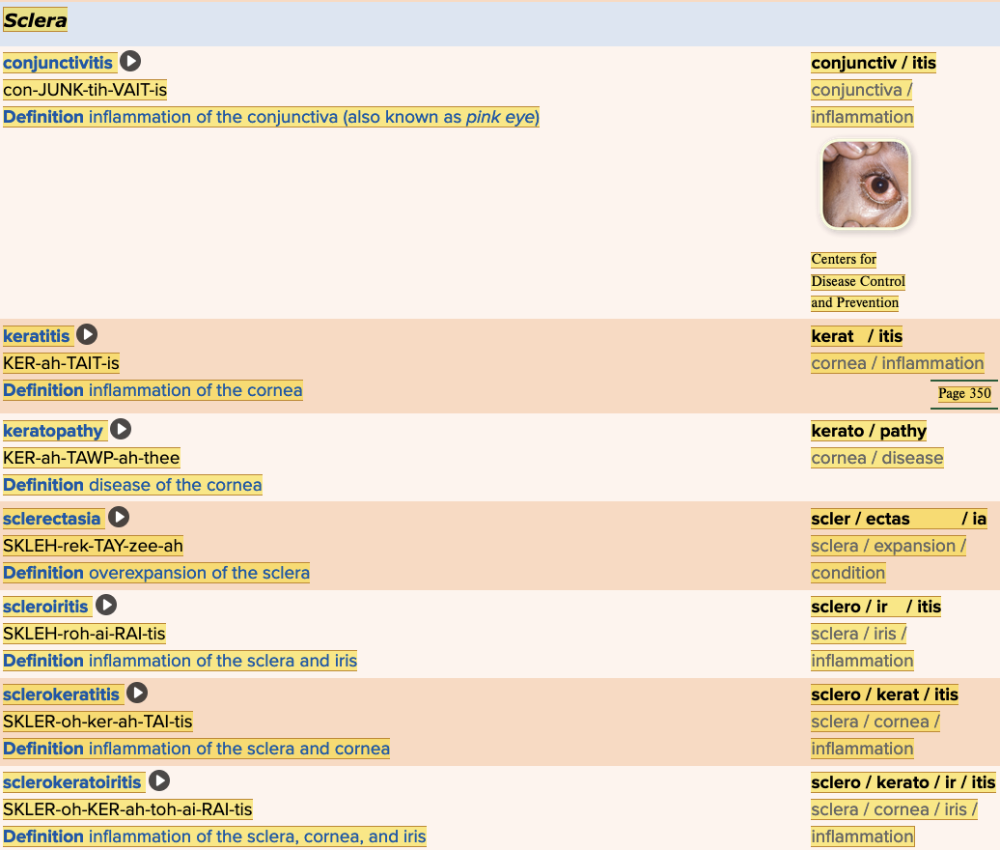
Chapter 6.4 Diagnosis and Pathology
- Assessment: The Ear
- The Eye Table - Sclera
...
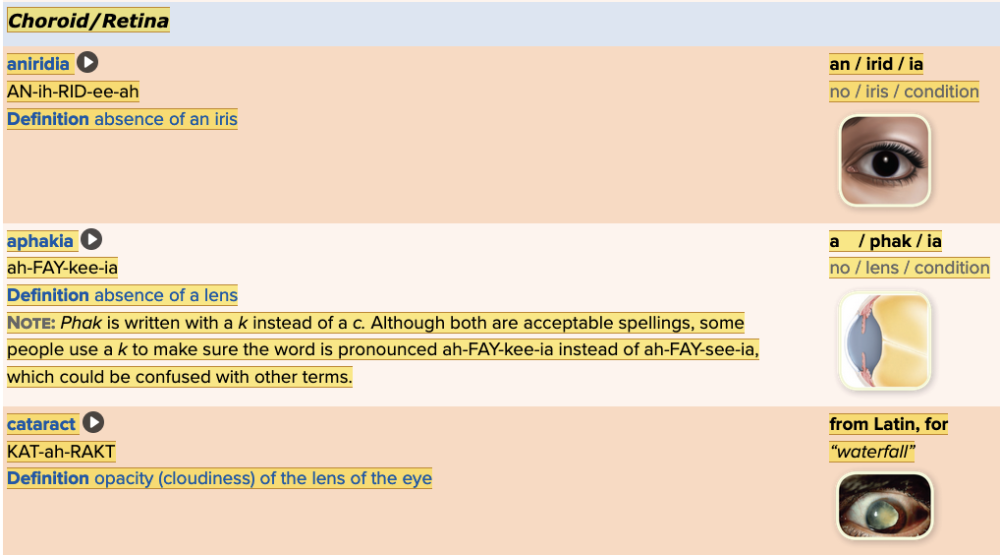
Chapter 6.4 Diagnosis and Pathology
- Assessment: The Ear
- The Eye Table - Choroid/Retina Part 1
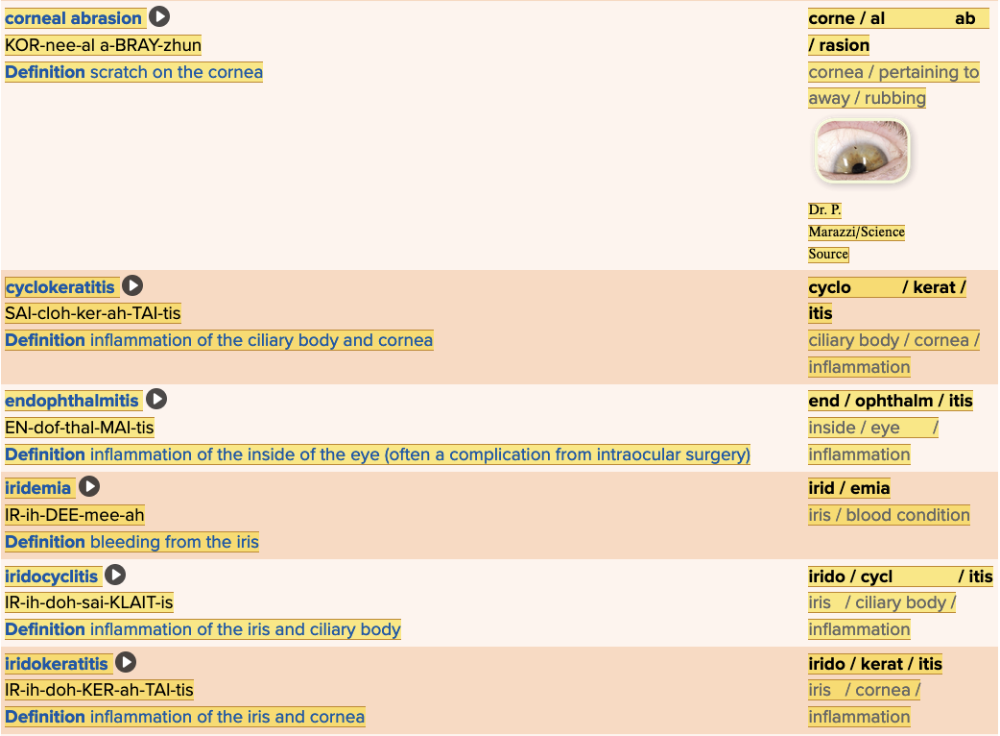
Chapter 6.4 Diagnosis and Pathology
- Assessment: The Ear
- The Eye Table - Choroid/Retina Part 2
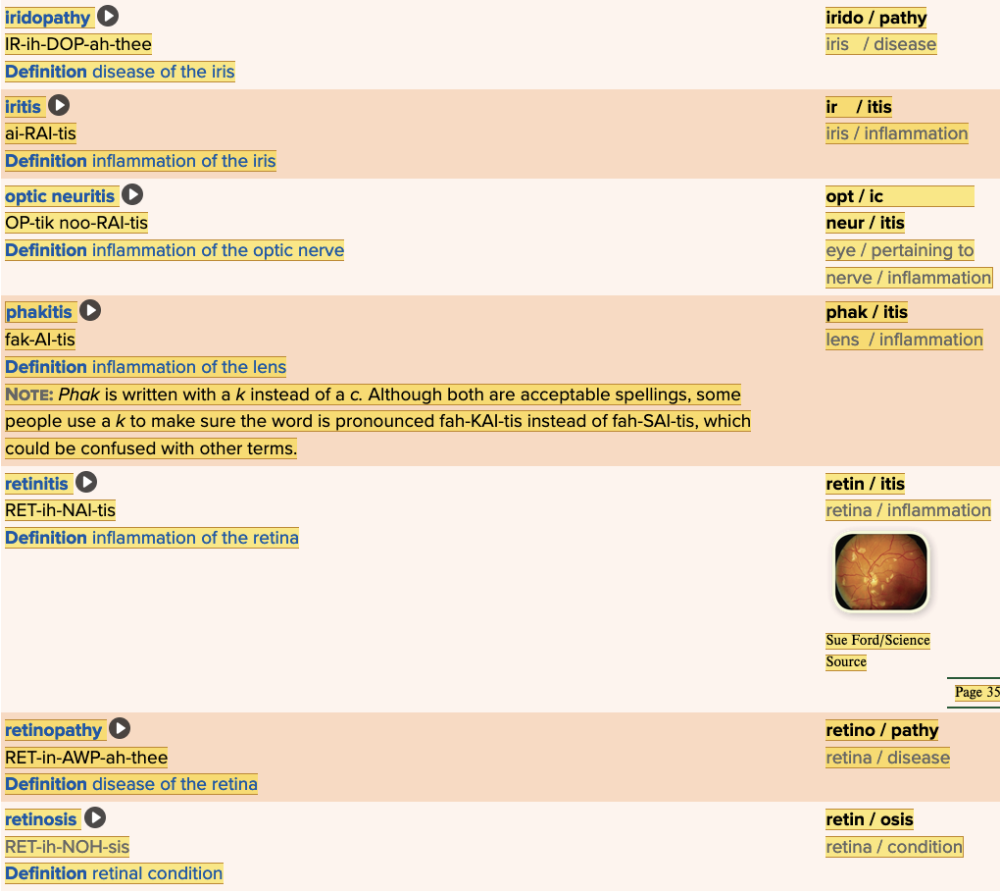
Chapter 6.4 Diagnosis and Pathology
- Assessment: The Ear
- The Eye Table - Choroid/Retina Part 3
...
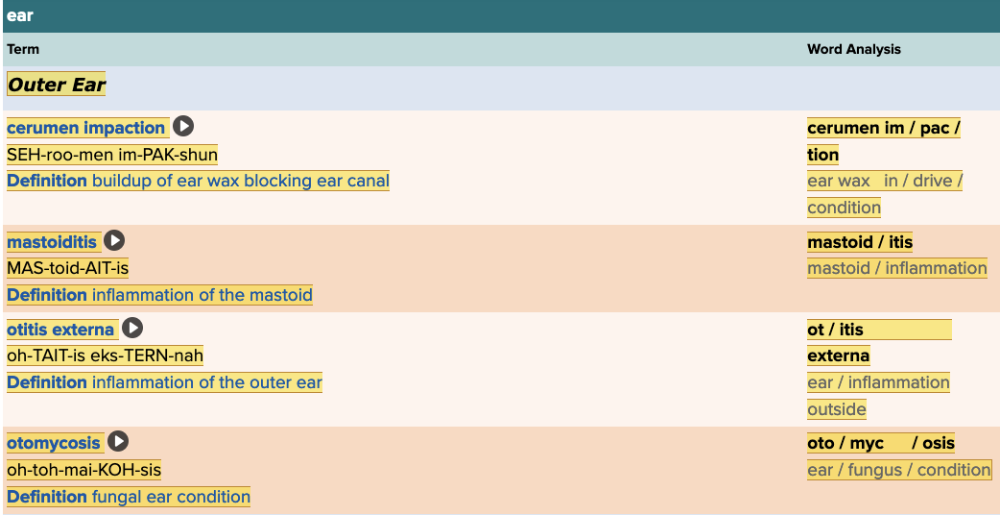
Chapter 6.4 Diagnosis and Pathology
- Assessment: The Ear
- The Ear Table - Outer Ear
...
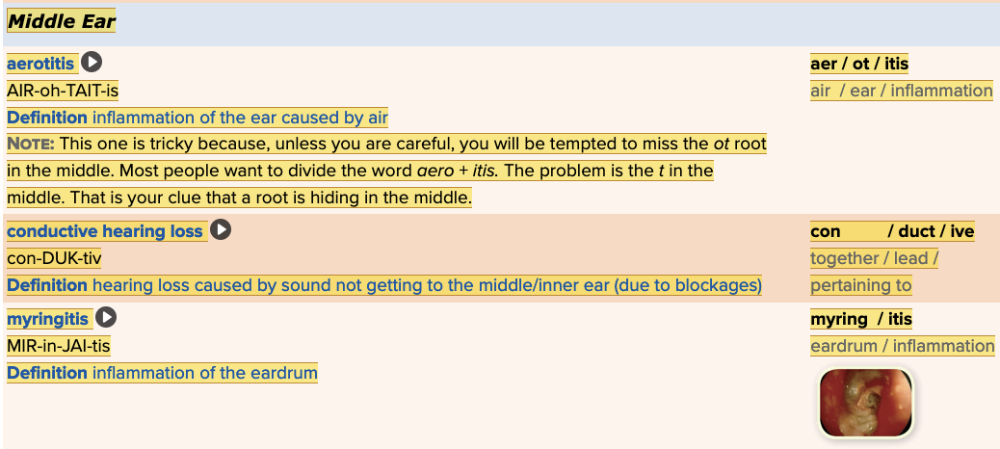
Chapter 6.4 Diagnosis and Pathology
- Assessment: The Ear
- The Ear Table - Middle Ear Part 1
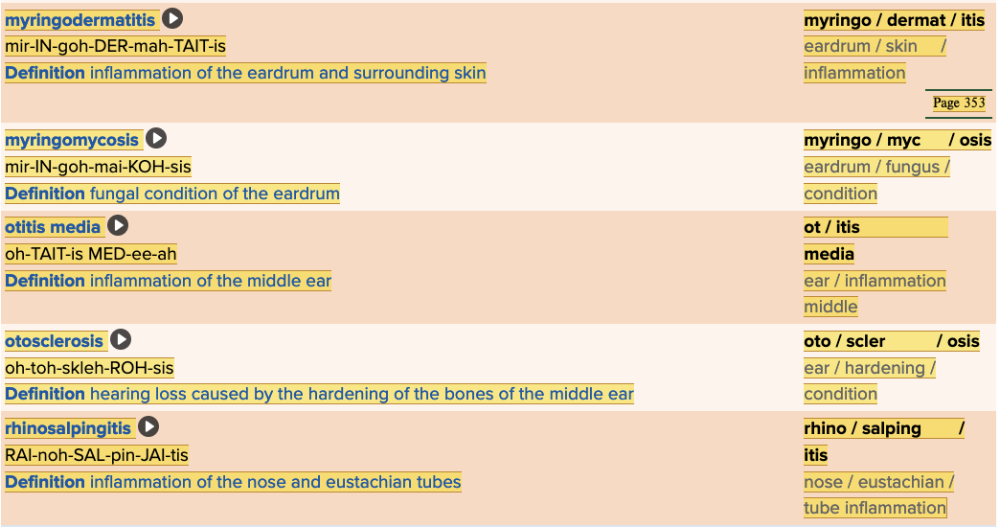
Chapter 6.4 Diagnosis and Pathology
- Assessment: The Ear
- The Ear Table - Middle Ear Part 2
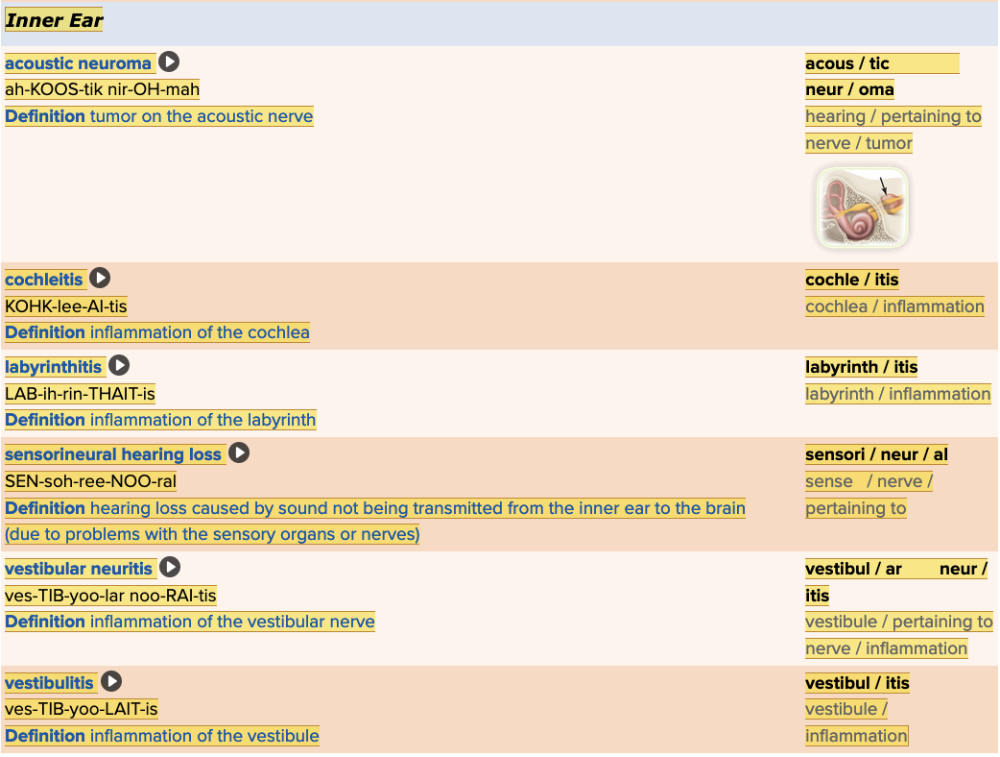
Chapter 6.4 Diagnosis and Pathology
- Assessment: The Ear
- The Ear Table - Inner Ear
...
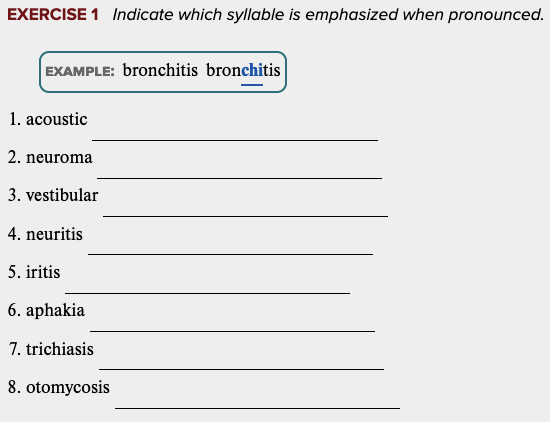
Learning Outcome 6.4 Exercises: Exercise 1.
...
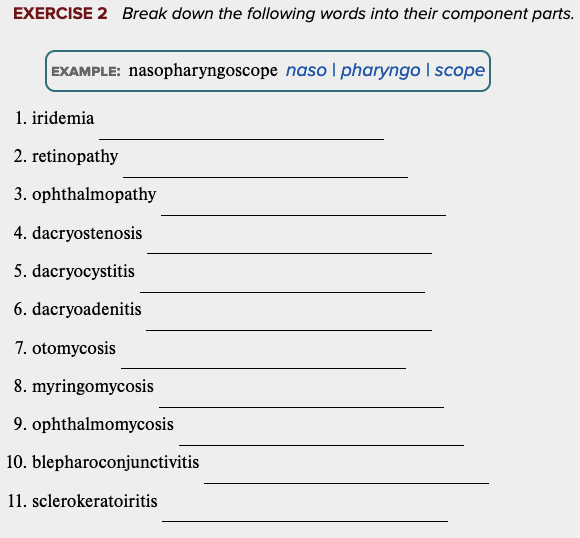
Learning Outcome 6.4 Exercises: Exercise 2.
...
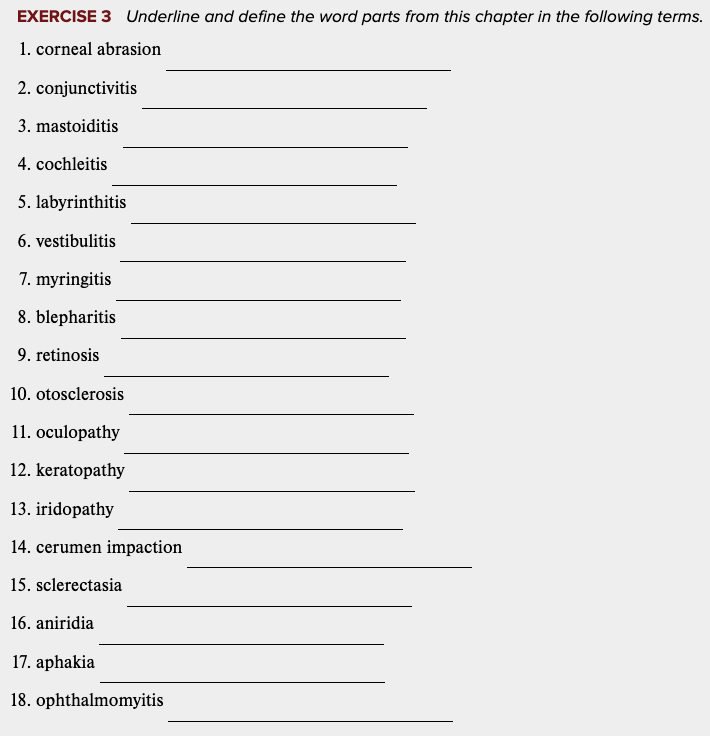
Learning Outcome 6.4 Exercises: Exercise 3.
...
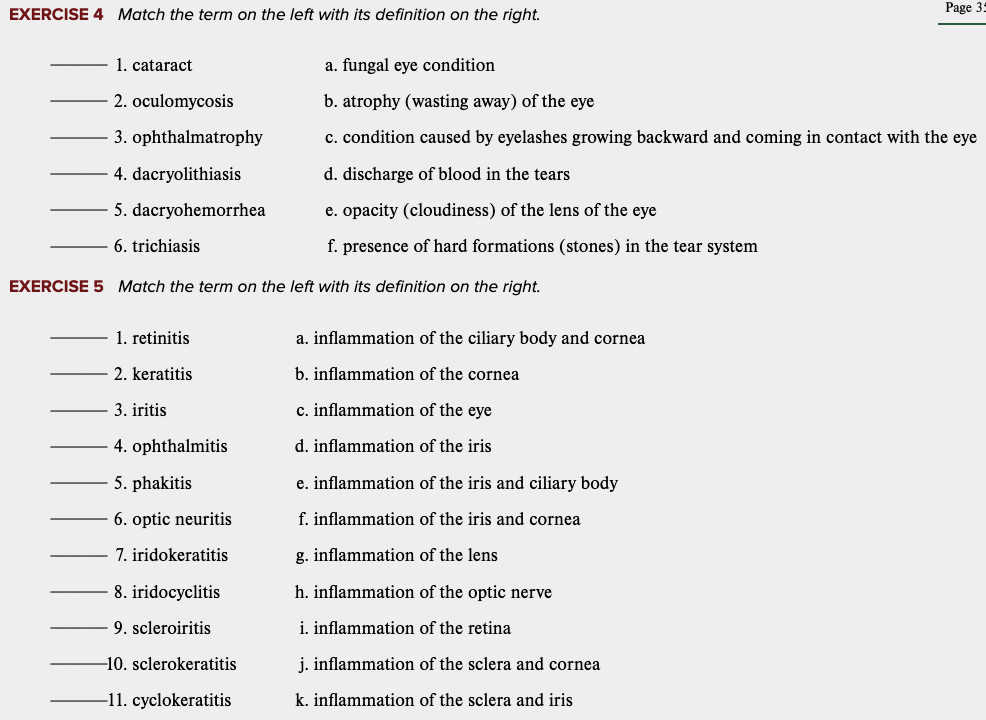
Learning Outcome 6.4 Exercises: Exercise 4, 5.
...
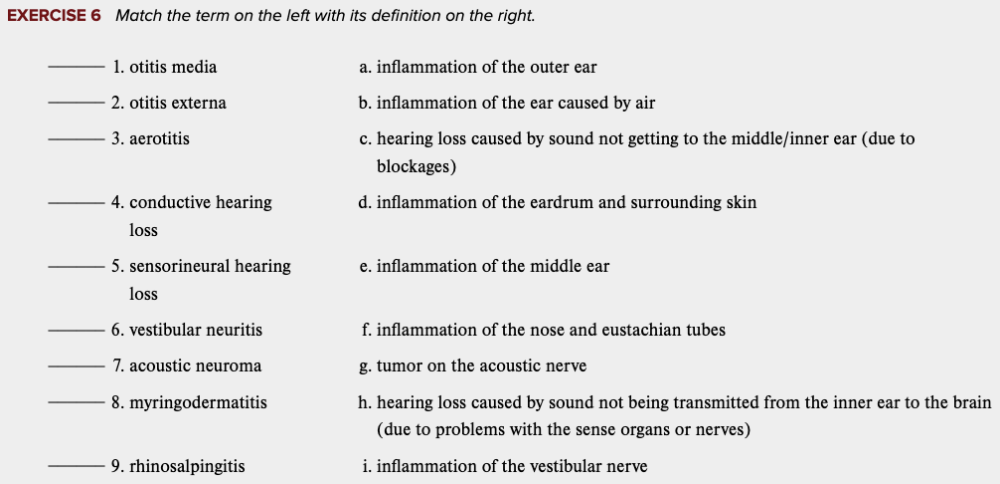
Learning Outcome 6.4 Exercises: Exercise 6.
...
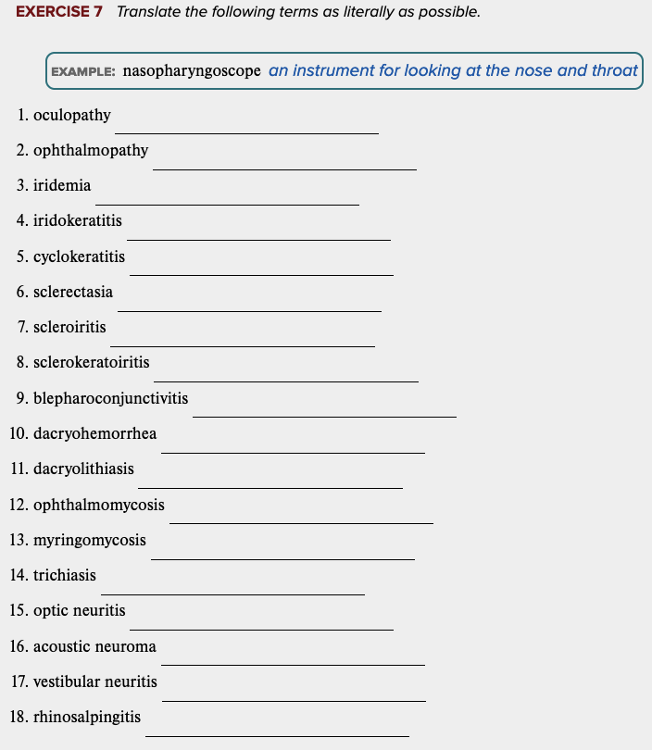
Learning Outcome 6.4 Exercises: Exercise 7.
...
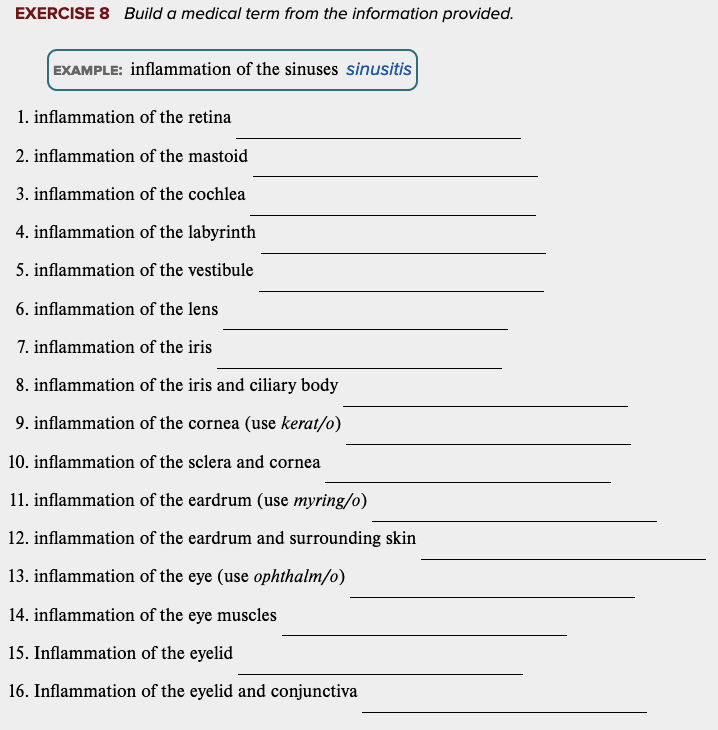
Learning Outcome 6.4 Exercises: Exercise 8.
...
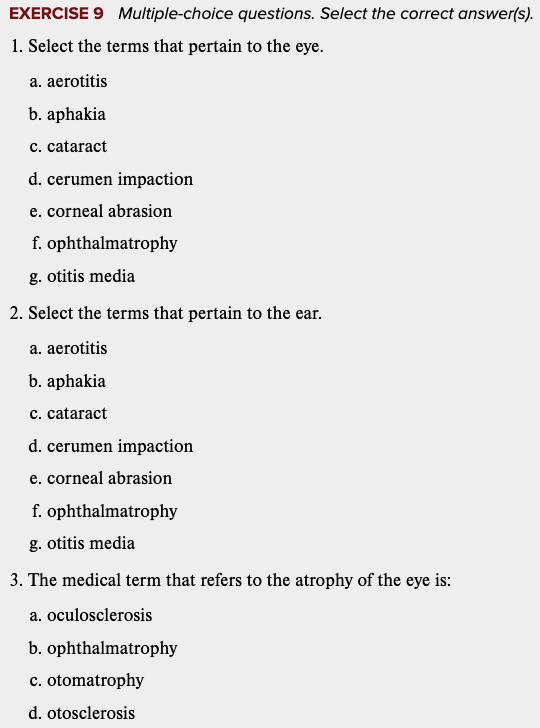
Learning Outcome 6.4 Exercises: Exercise 9.
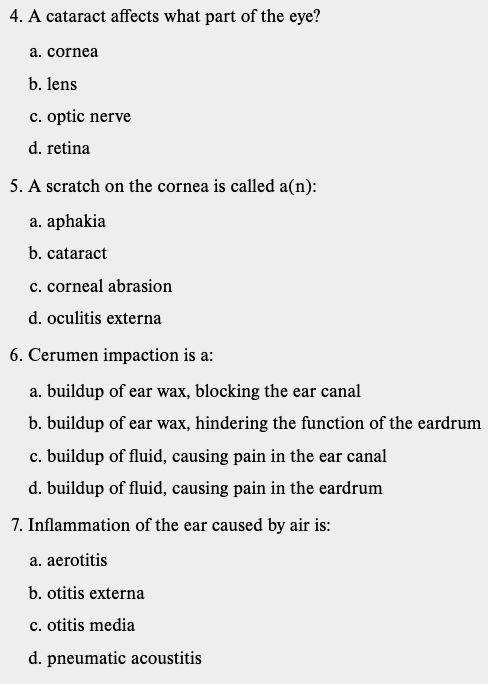
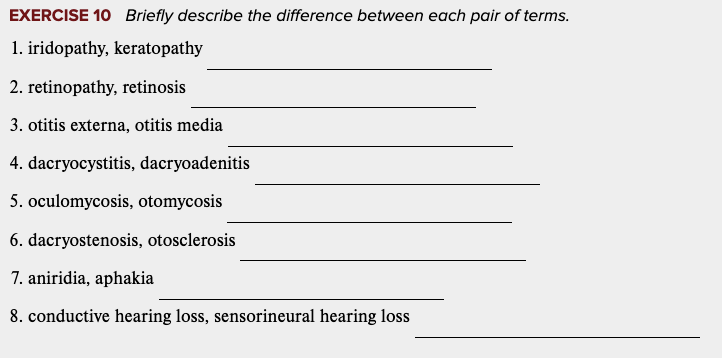
Learning Outcome 6.4 Exercises: Exercise 10.
...
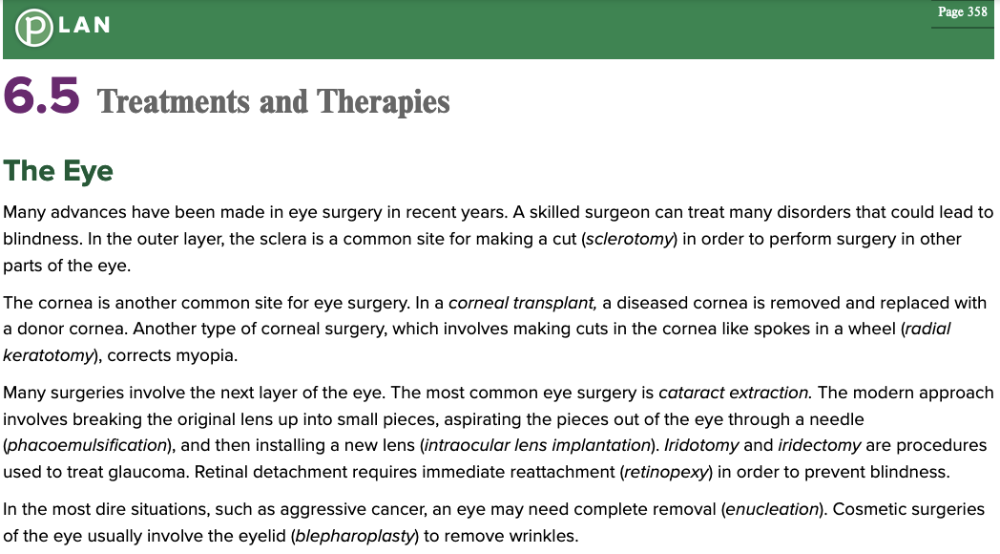
Chapter 6.5 Treatments and Therapies
- Plan: The Eye
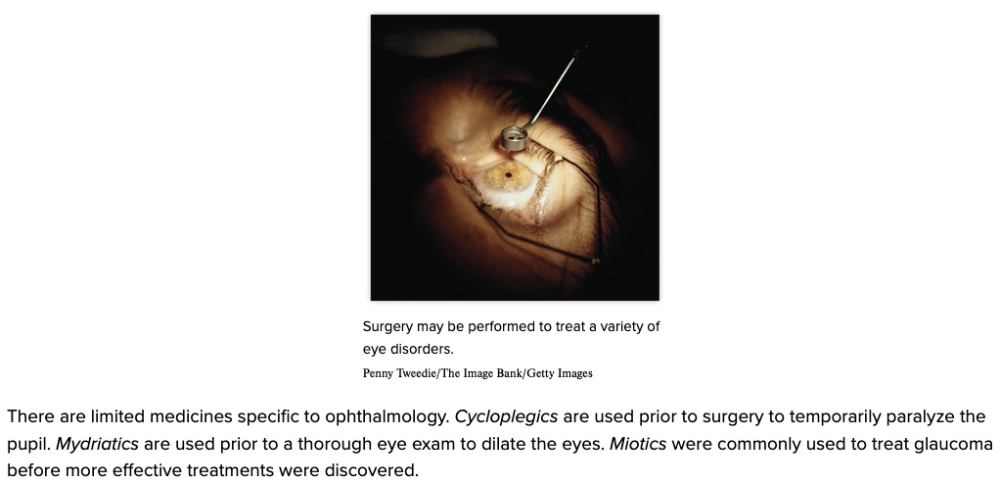
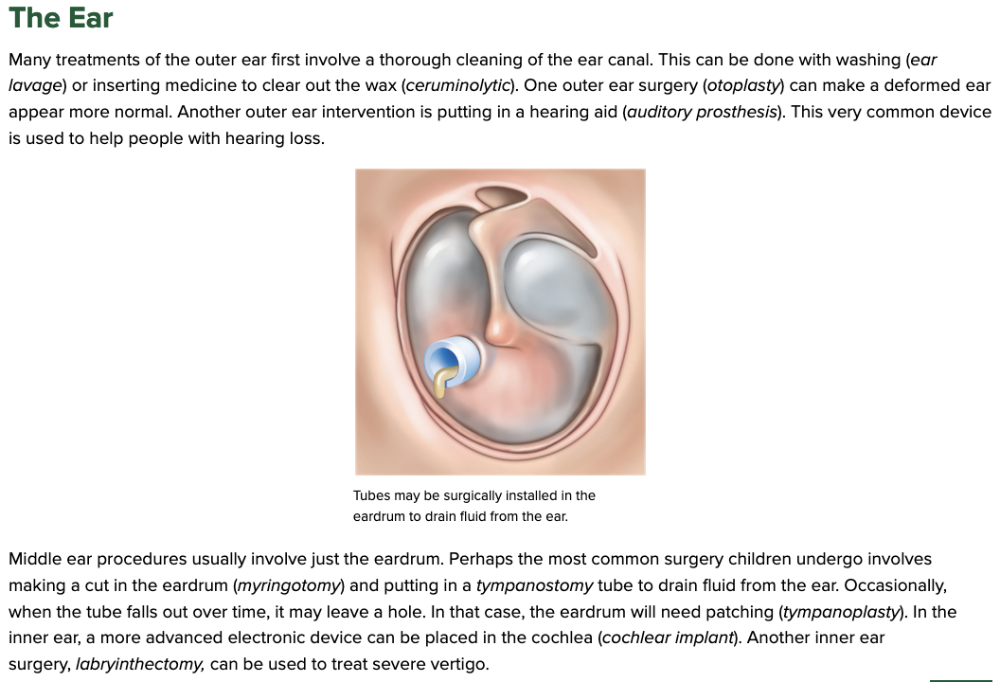
Chapter 6.5 Treatments and Therapies
- Plan: The Ear
...
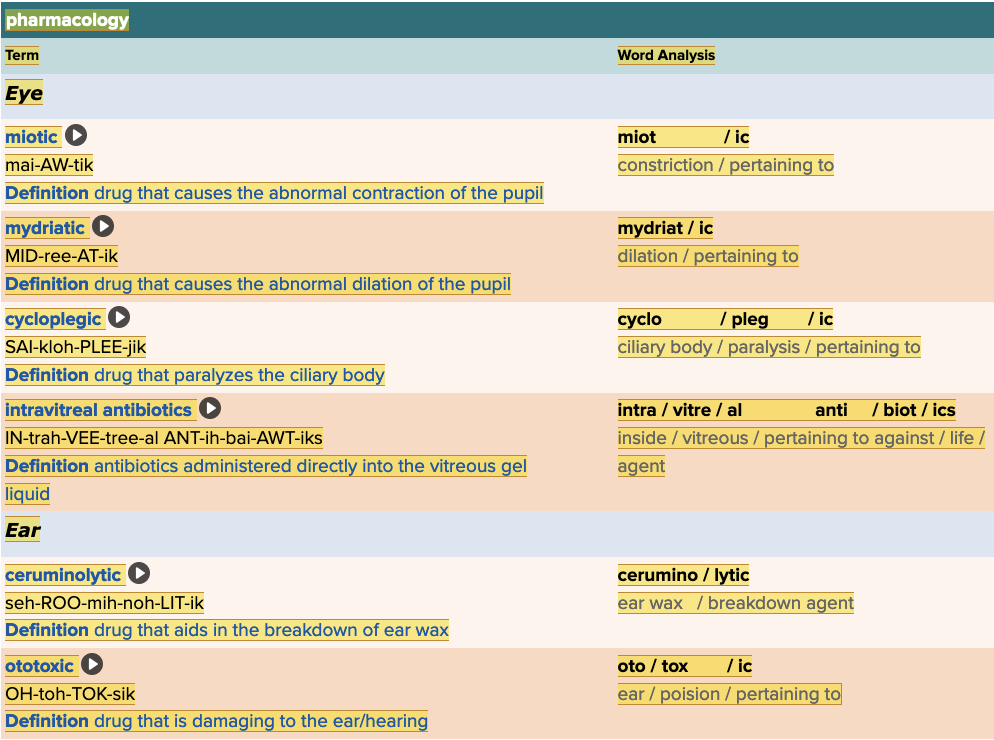
Chapter 6.5 Treatments and Therapies
- Plan: Pharmacology Table - Eye and Ear
...
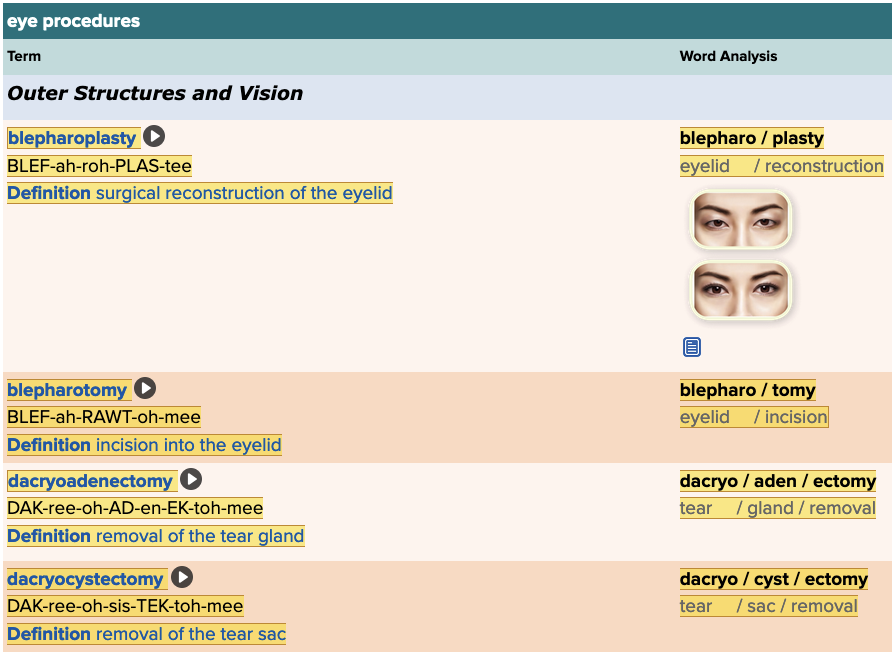
Chapter 6.5 Treatments and Therapies
- Plan: Eye Procedures Table - Outer Structures and Vision Part 1
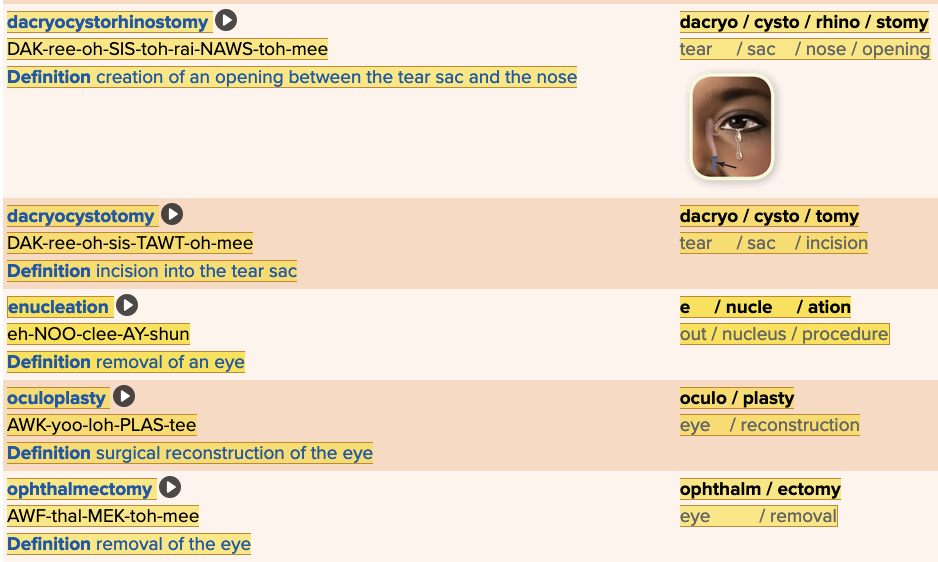
Chapter 6.5 Treatments and Therapies
- Plan: Eye Procedures Table - Outer Structures and Vision Part 2
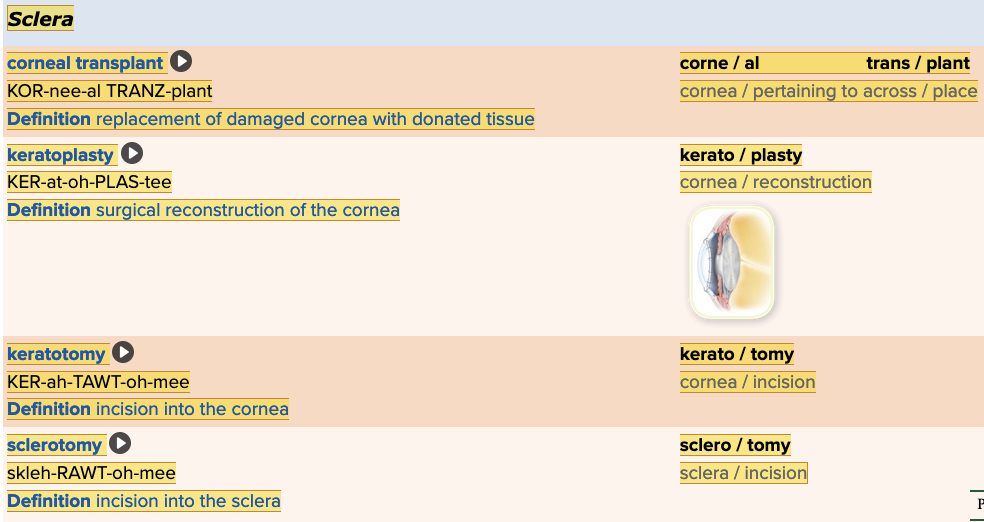
Chapter 6.5 Treatments and Therapies
- Plan: Eye Procedures Table - Sclera
...
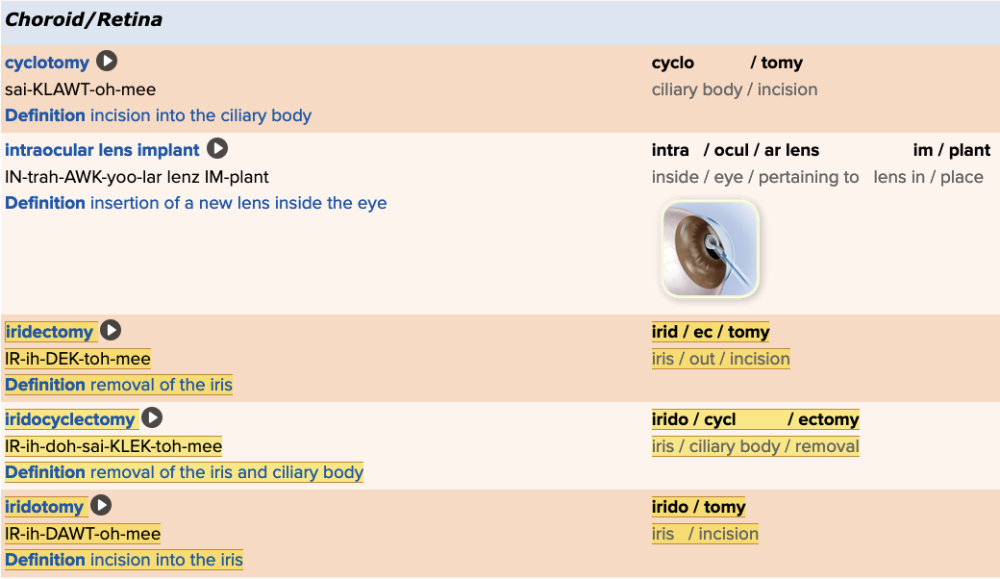
Chapter 6.5 Treatments and Therapies
- Plan: Eye Procedures Table - Choroid/Retina Part 1
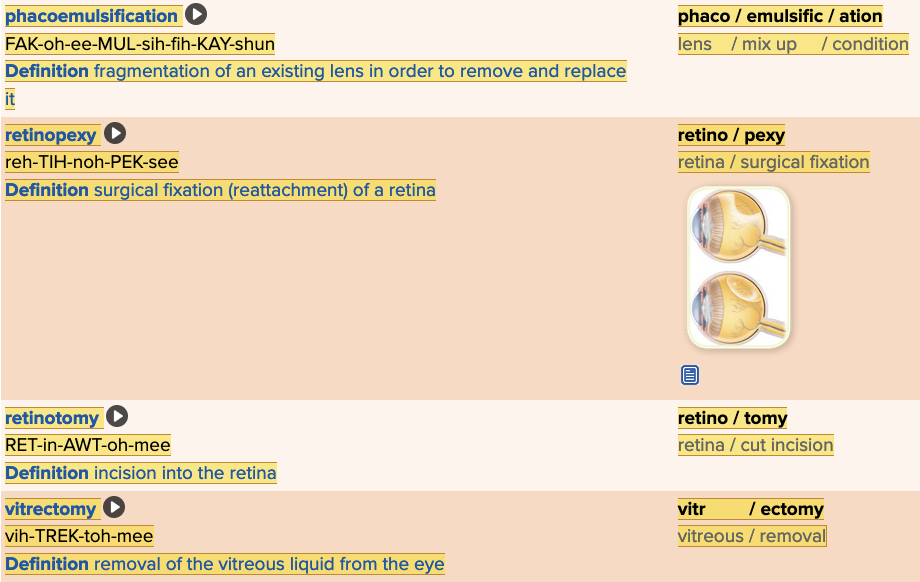
Chapter 6.5 Treatments and Therapies
- Plan: Eye Procedures Table - Choroid/Retina Part 2
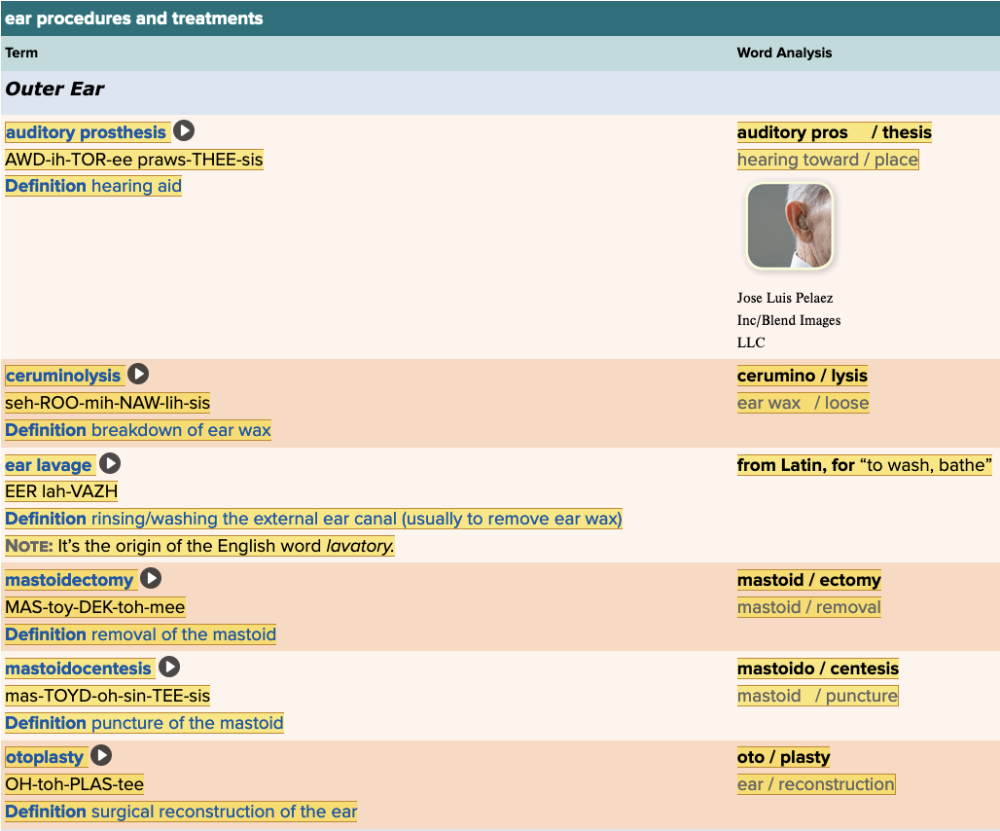
Chapter 6.5 Treatments and Therapies
- Plan: Ear Procedures and Treatments Table - Outer Ear
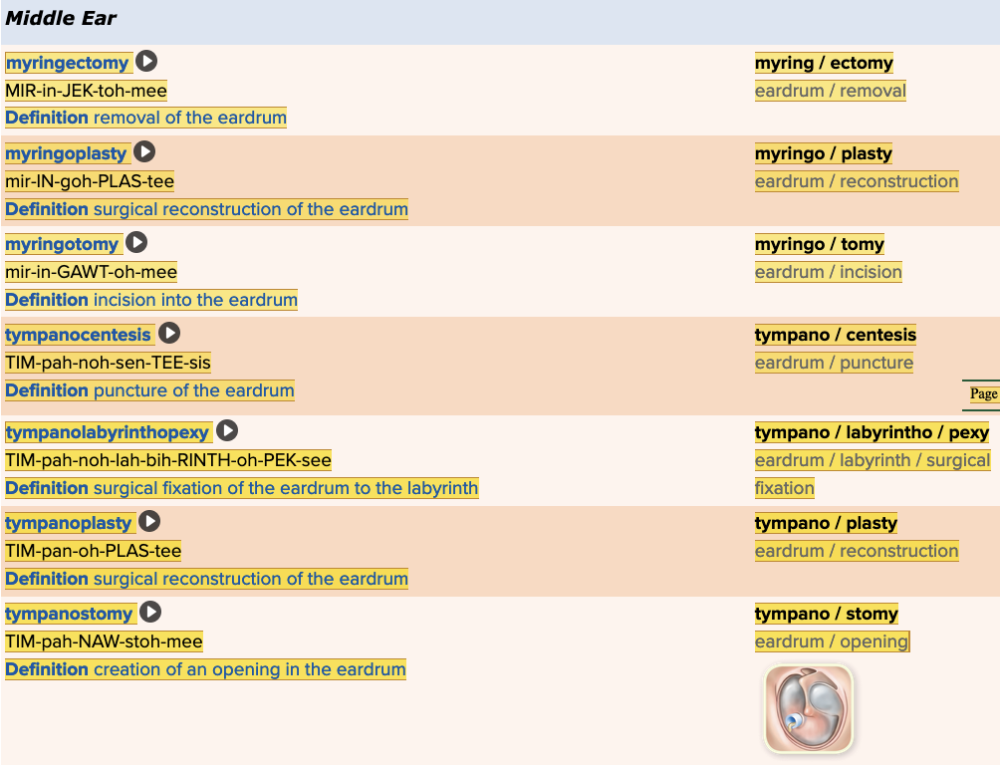
Chapter 6.5 Treatments and Therapies
- Plan: Ear Procedures and Treatments Table - Middle Ear
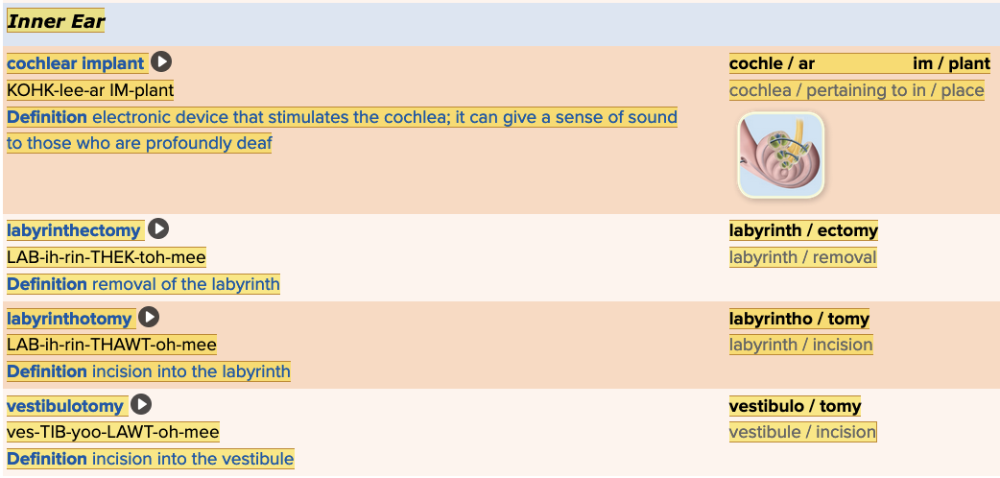
Chapter 6.5 Treatments and Therapies
- Plan: Ear Procedures and Treatments Table - Inner Ear
...
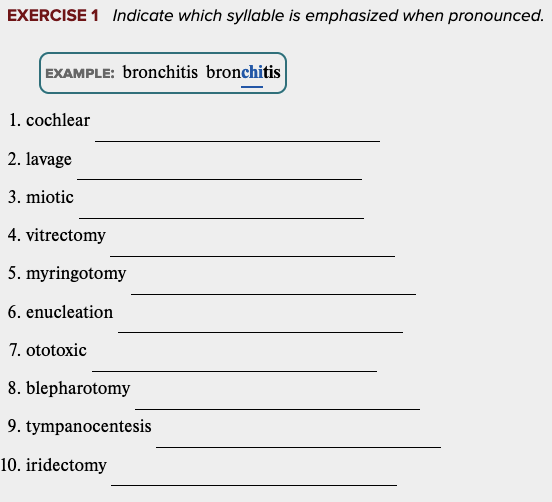
Learning Outcome 6.5 Exercises: Exercise 1.
...
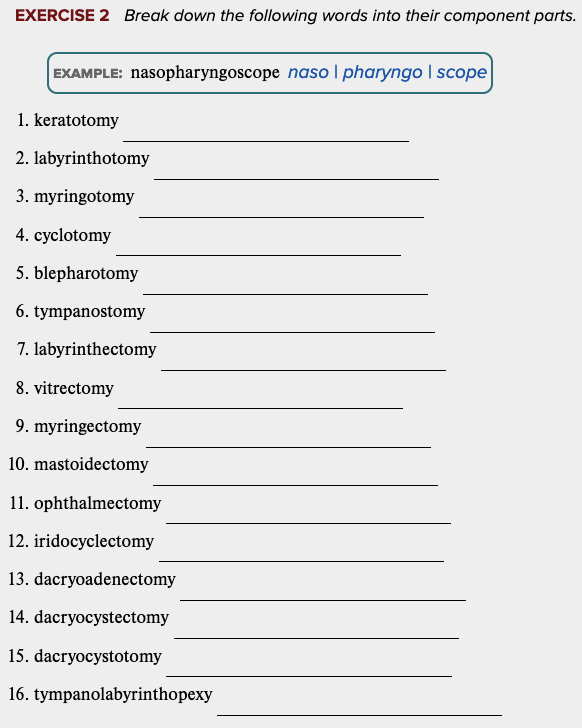
Learning Outcome 6.5 Exercises: Exercise 2.
...
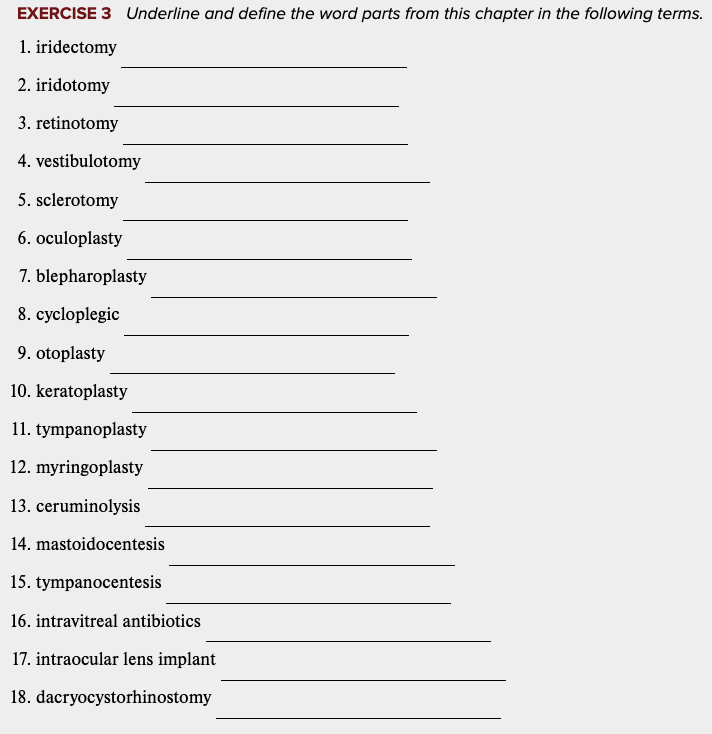
Learning Outcome 6.5 Exercises: Exercise 3.
...
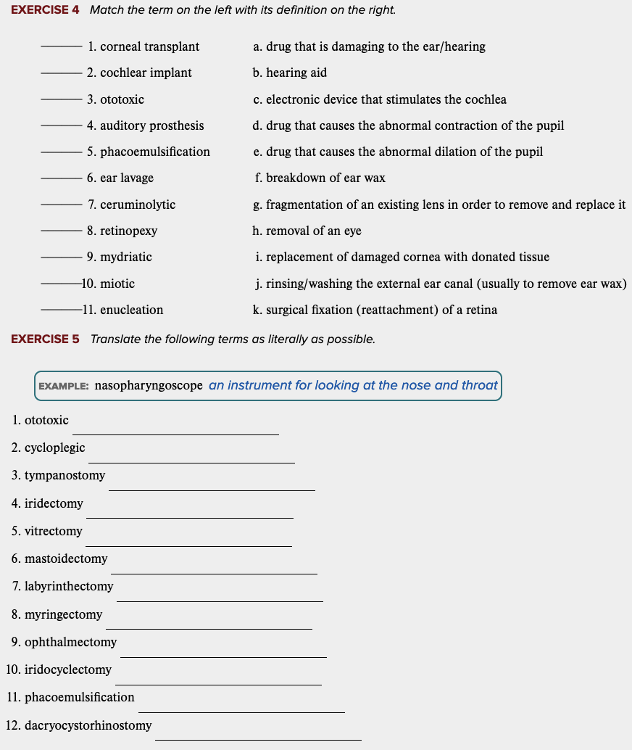
Learning Outcome 6.5 Exercises: Exercise 4, 5.
...
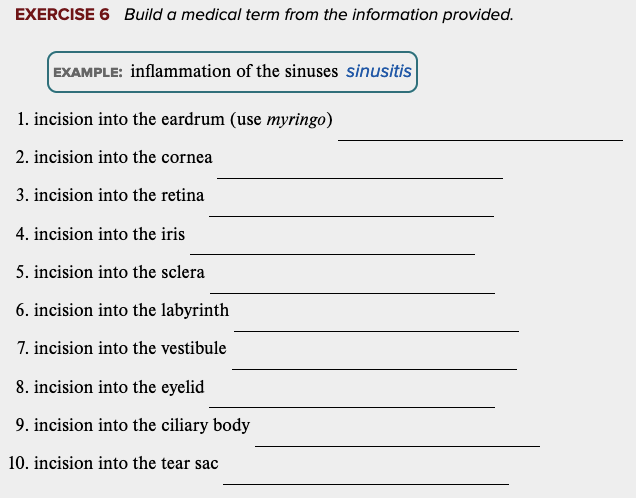
Learning Outcome 6.5 Exercises: Exercise 6.
...
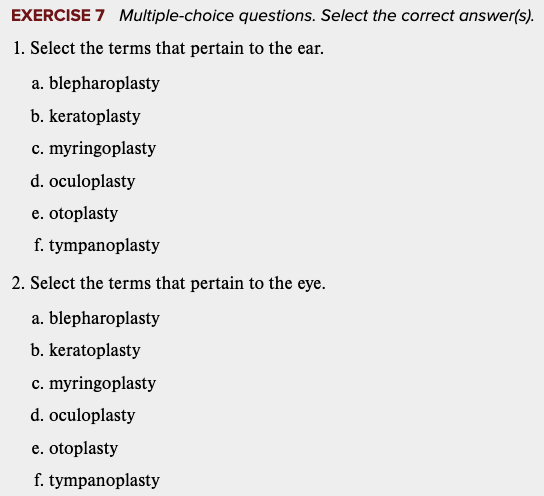
Learning Outcome 6.5 Exercises: Exercise 7.
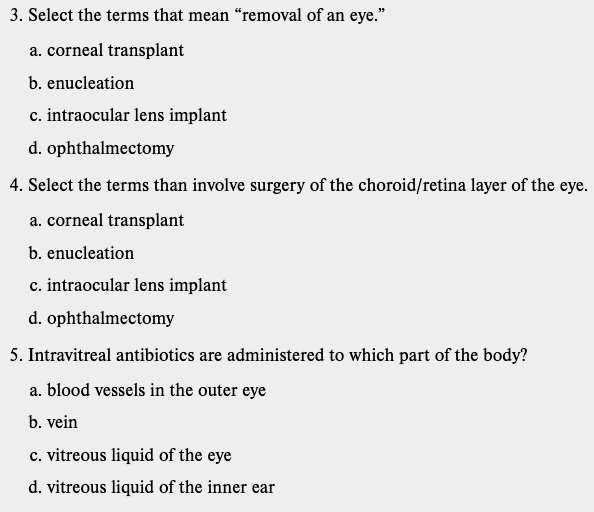
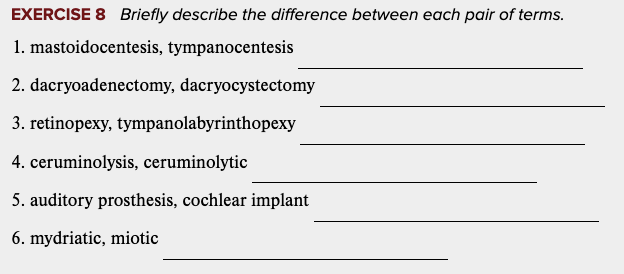
Learning Outcome 6.5 Exercises: Exercise 8.
...

Chapter 6.6 Abbreviations
...
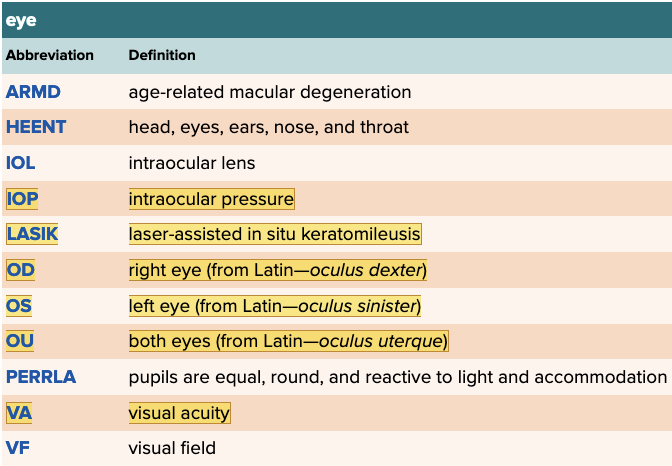
Chapter 6.6 Abbreviations
- Eye Abbreviations Table
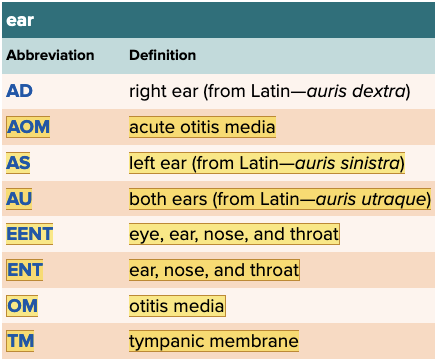
Chapter 6.6 Abbreviations
- Ear Abbreviations Table
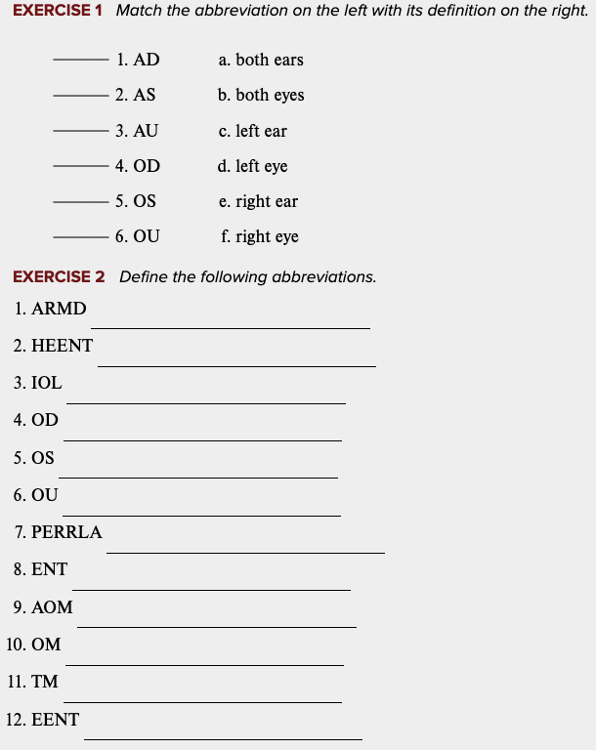
Learning Outcome 6.6 Exercises: Exercise 1, 2.
...
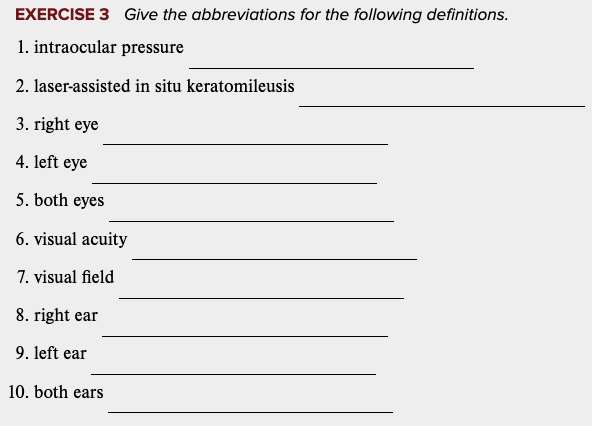
Learning Outcome 6.6 Exercises: Exercise 3.
...
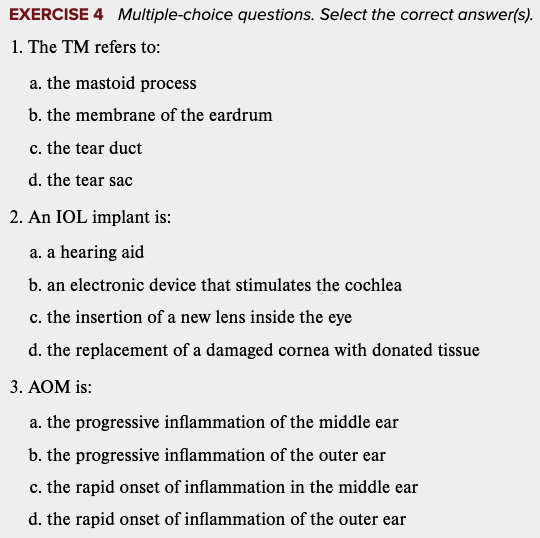
Learning Outcome 6.6 Exercises: Exercise 4.
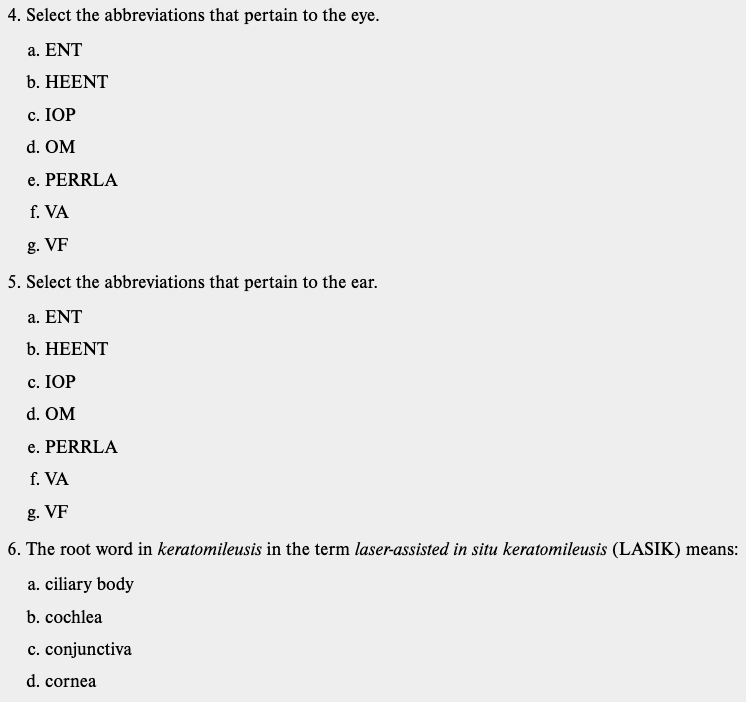
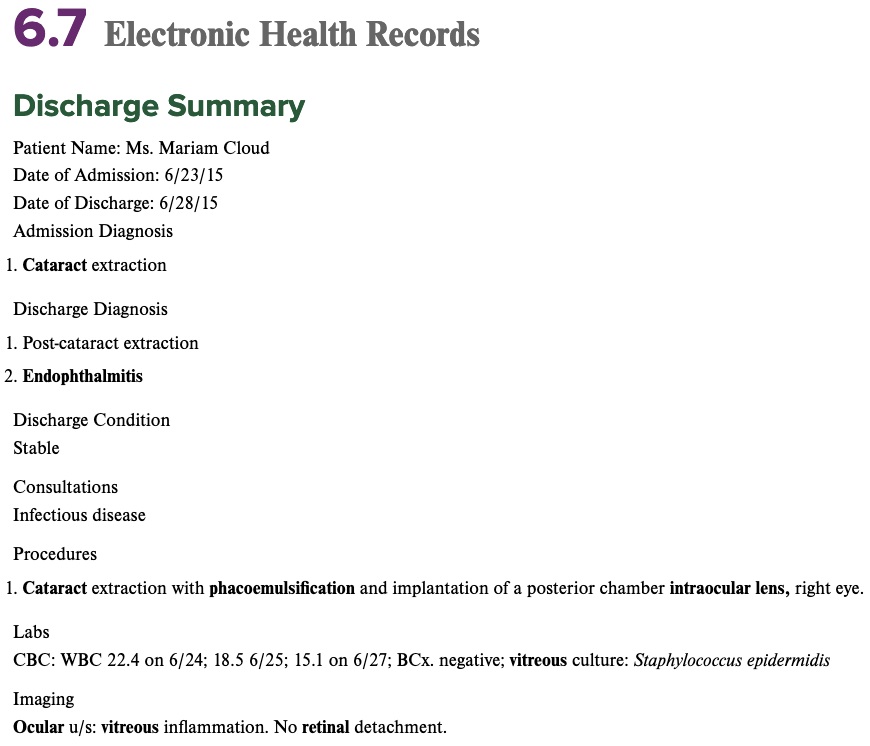
Chapter 6.7 Electronic Health Records
Discharge Summary Part 1
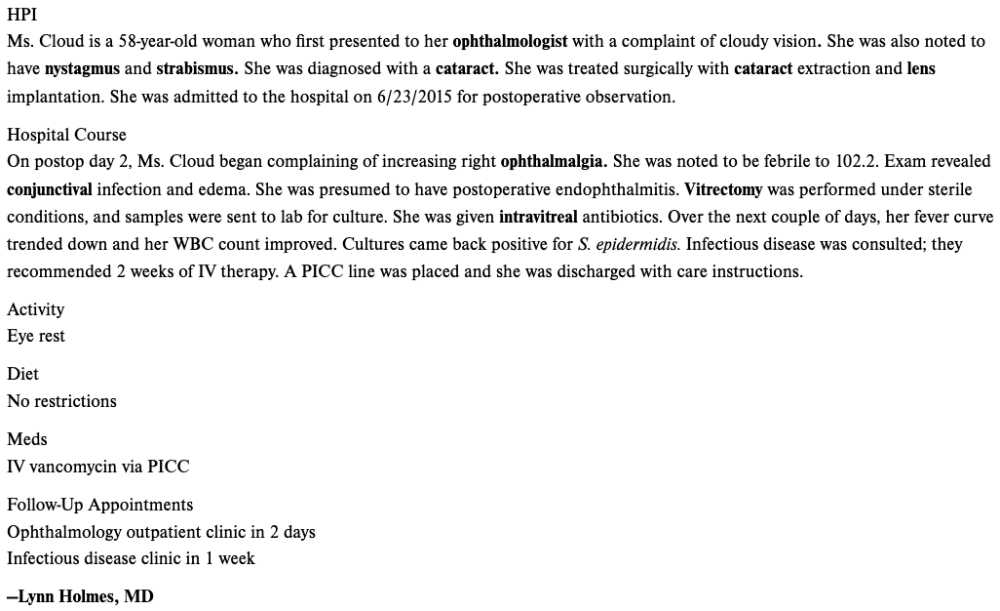
Chapter 6.7 Electronic Health Records
Discharge Summary Part 2
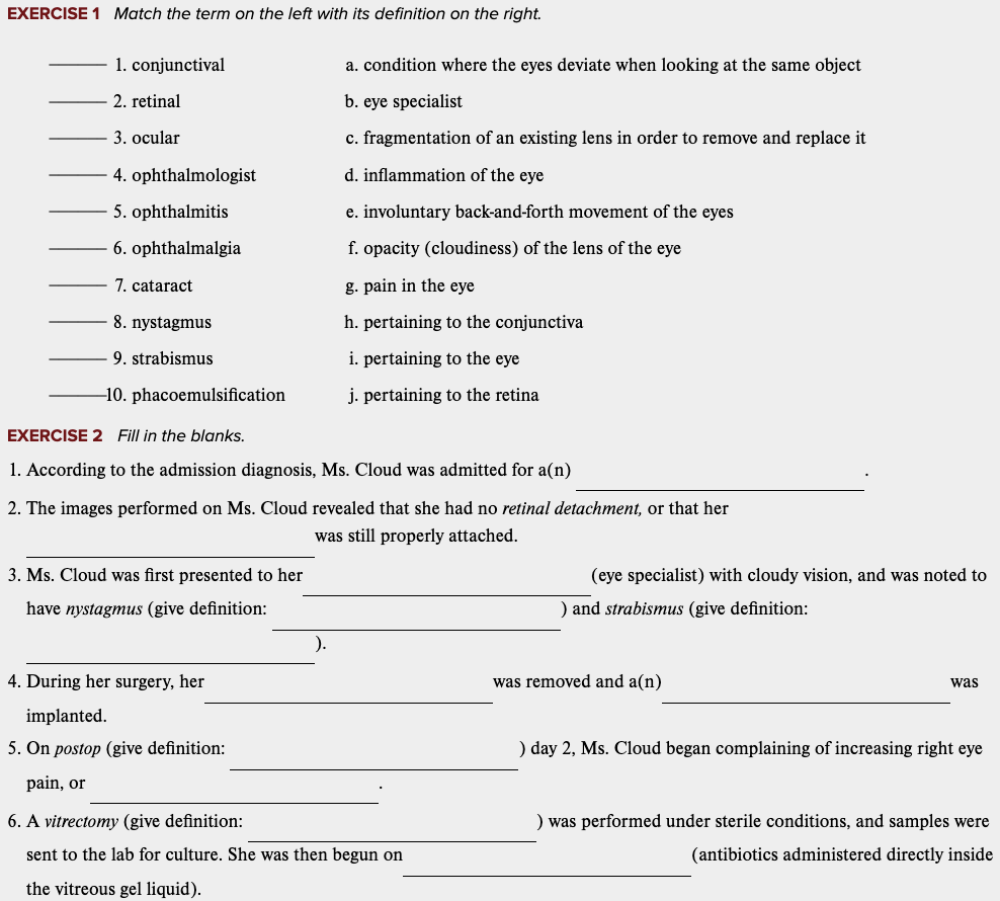
Learning Outcome 6.7 Exercises: Exercise 1, 2.
...

Learning Outcome 6.7 Exercises: Exercise 3.
...
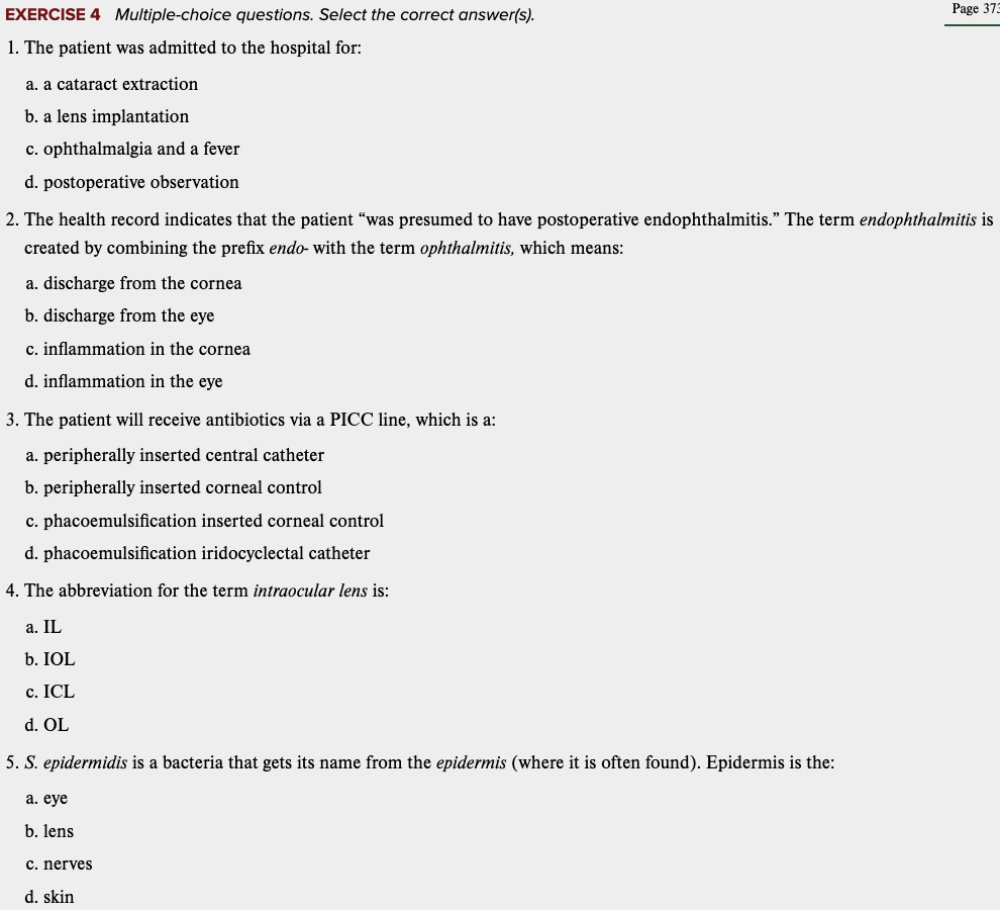
Learning Outcome 6.7 Exercises: Exercise 4.
...
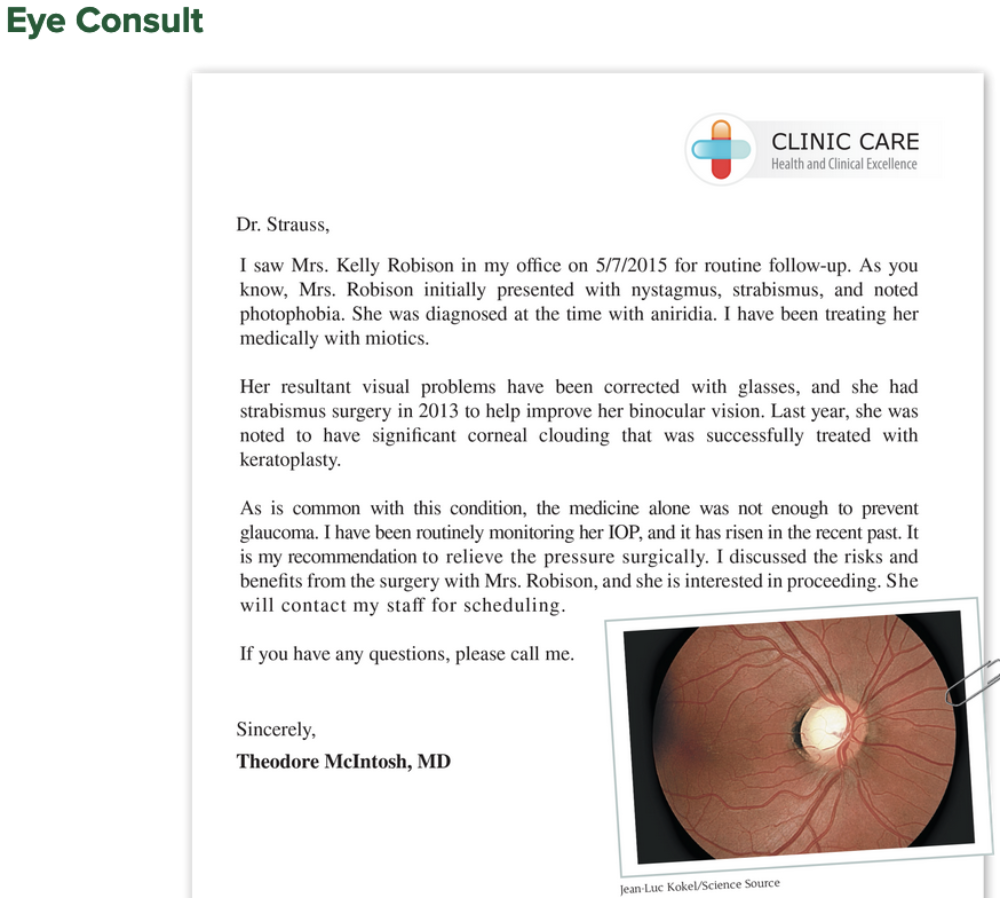
Chapter 6.7 Electronic Health Records
Eye Consult
...
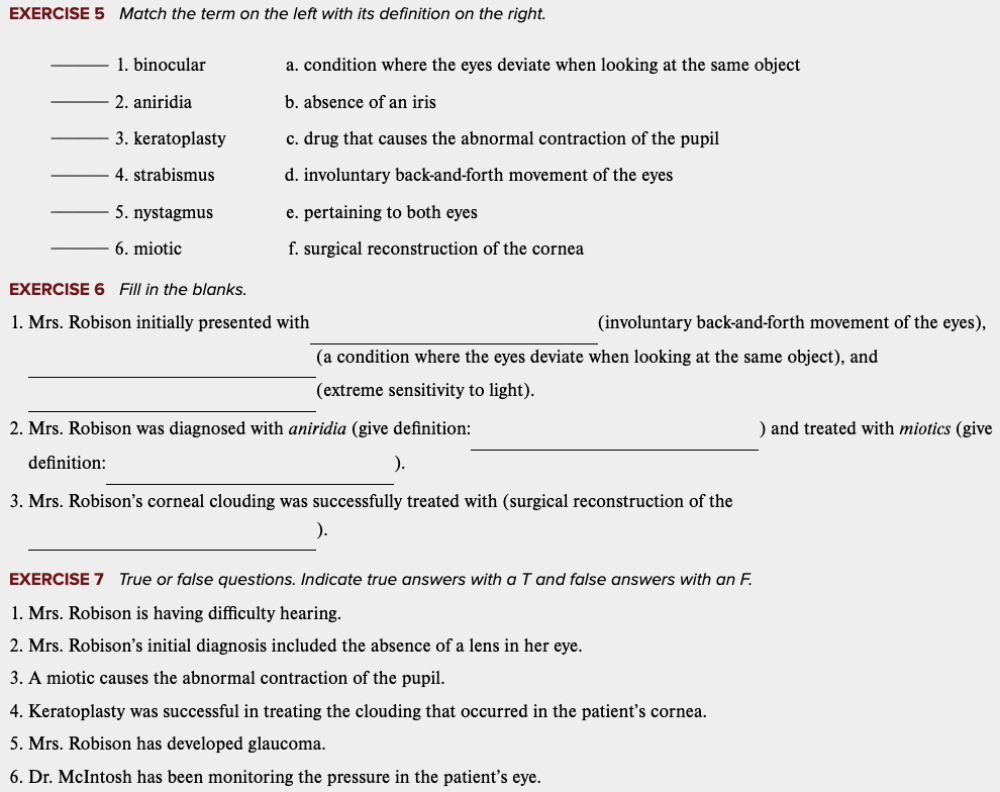
Learning Outcome 6.7 Exercises: Exercise 5, 6, 7.
...
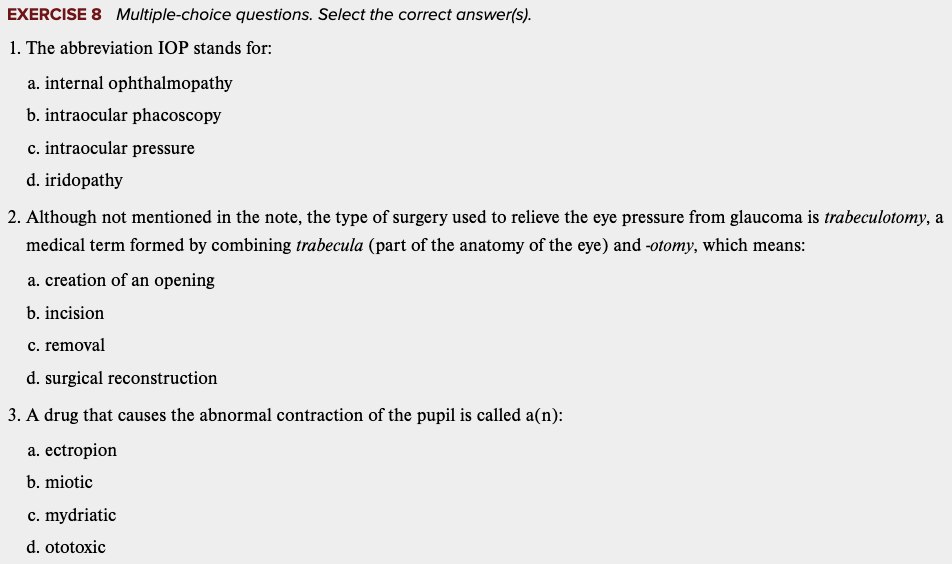
Learning Outcome 6.7 Exercises: Exercise 8.
...
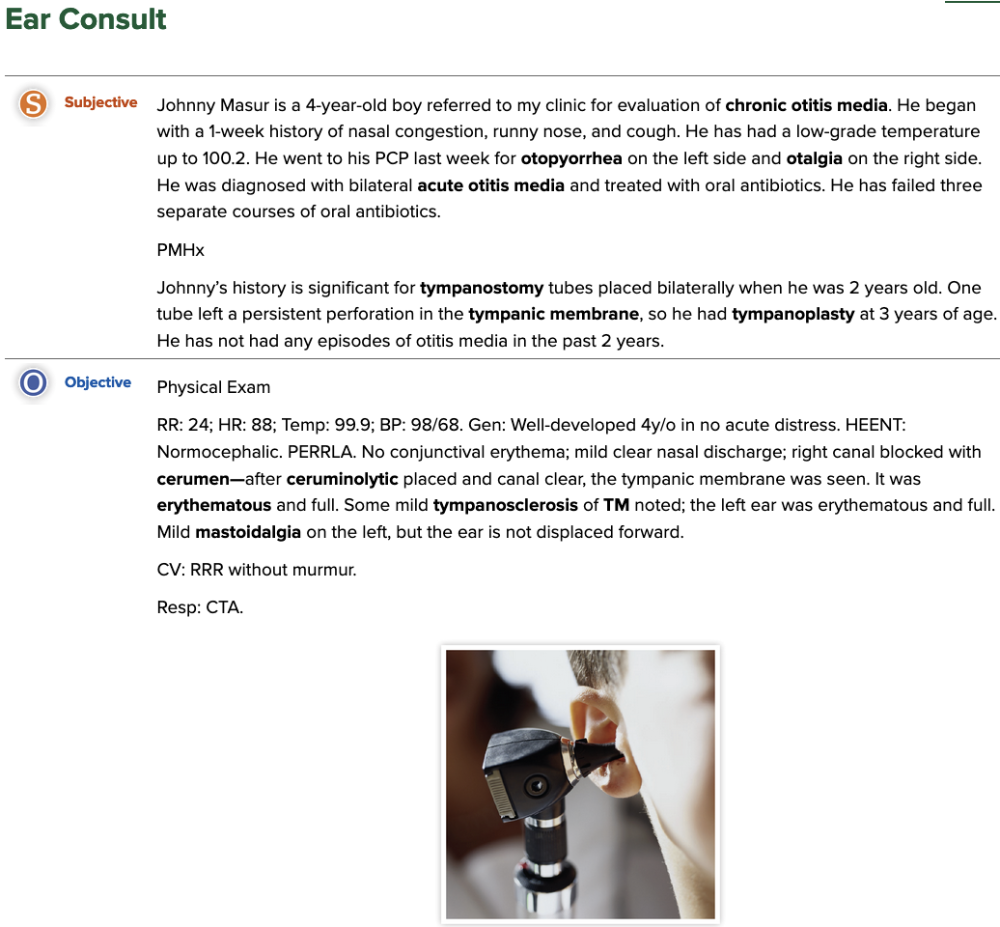
Chapter 6.7 Electronic Health Records
Ear Consult Part 1

Chapter 6.7 Electronic Health Records
Ear Consult Part 2
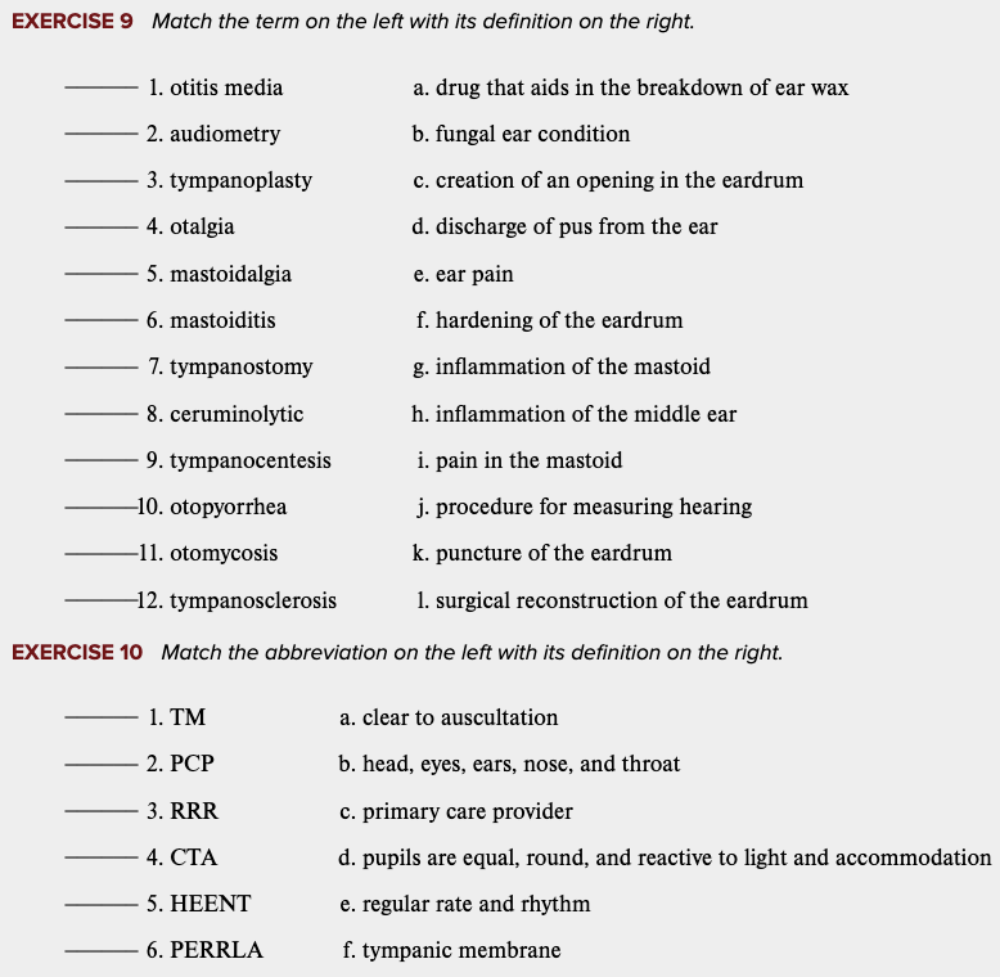
Learning Outcome 6.7 Exercises: Exercise 9, 10.
...
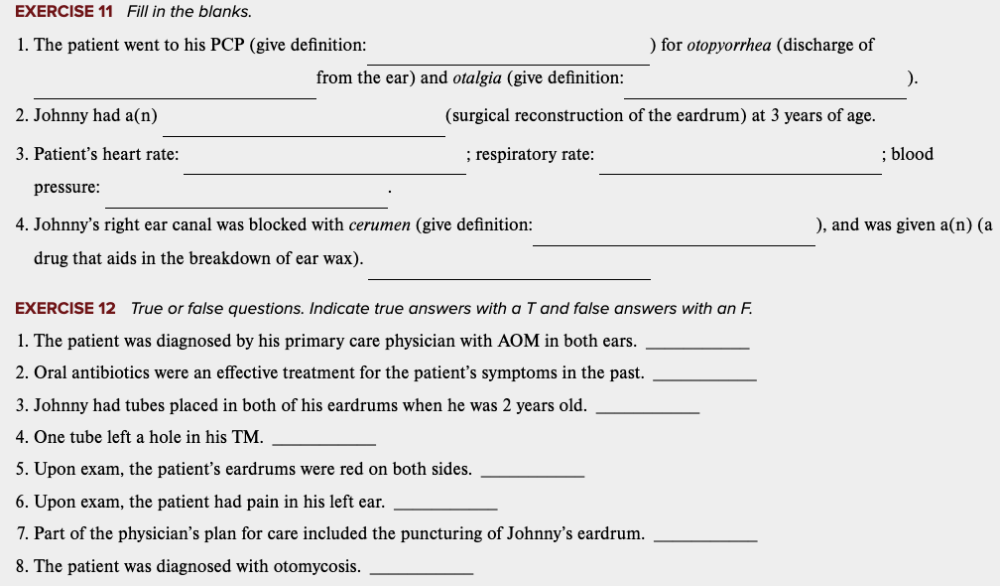
Learning Outcome 6.7 Exercises: Exercise 11, 12.
...
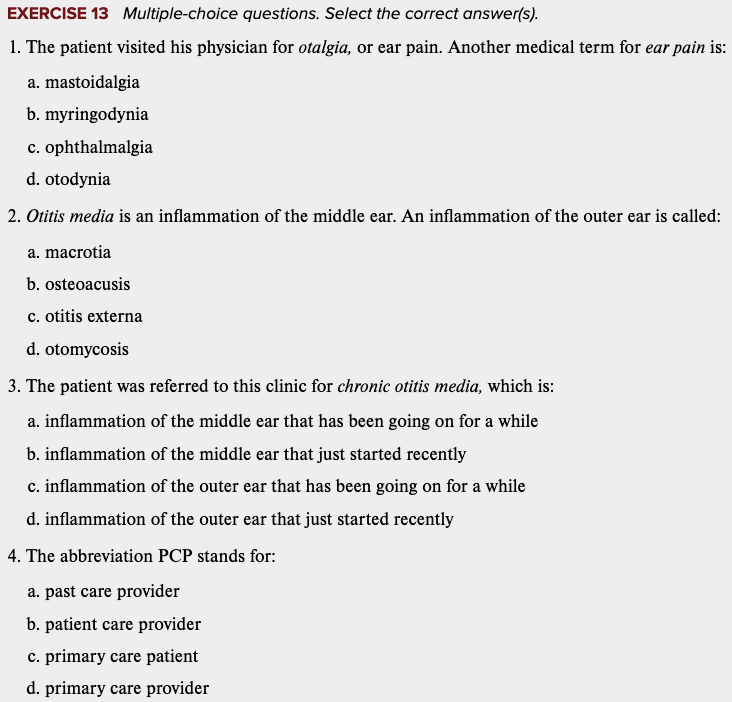
Learning Outcome 6.7 Exercises: Exercise 13.
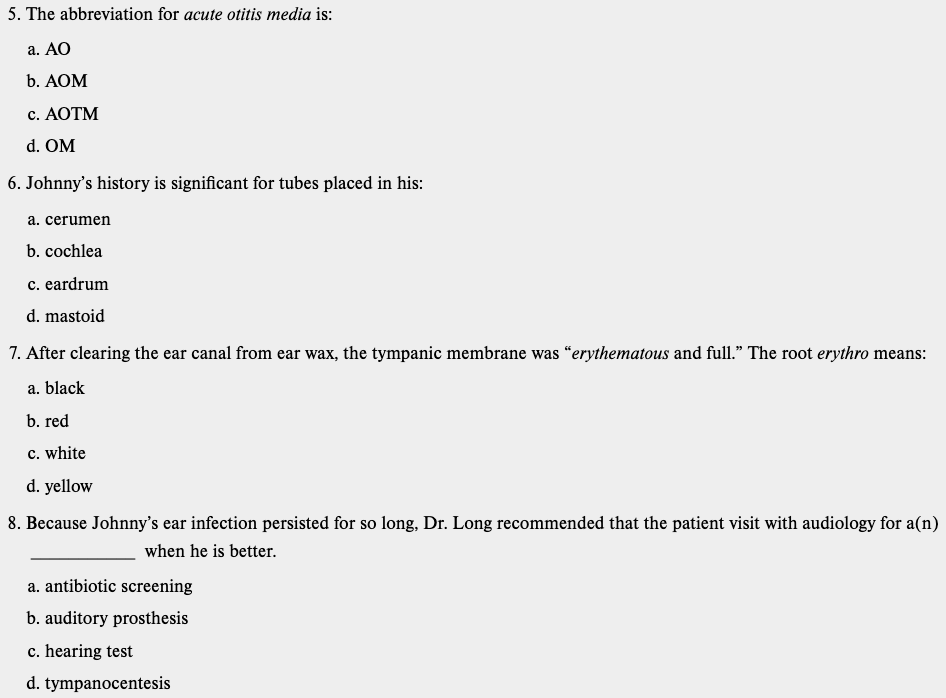
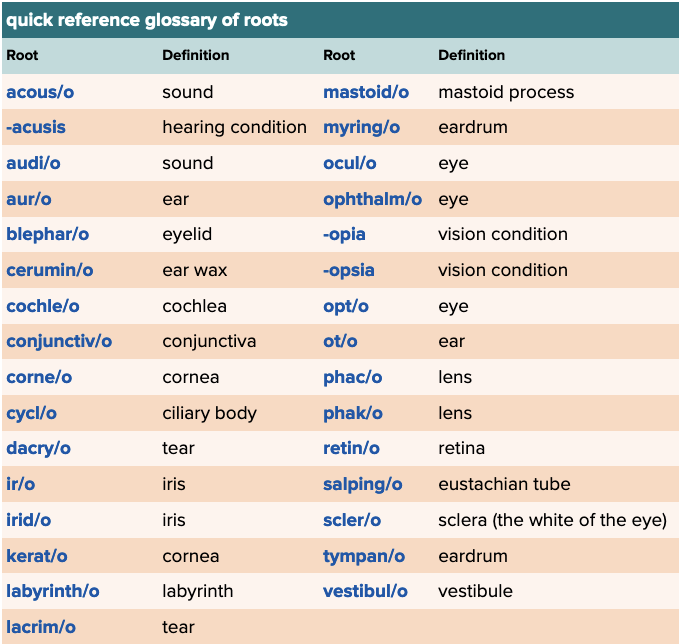
Chapter 6 Quick Reference
- Quick Reference Glossary of Roots Table
...
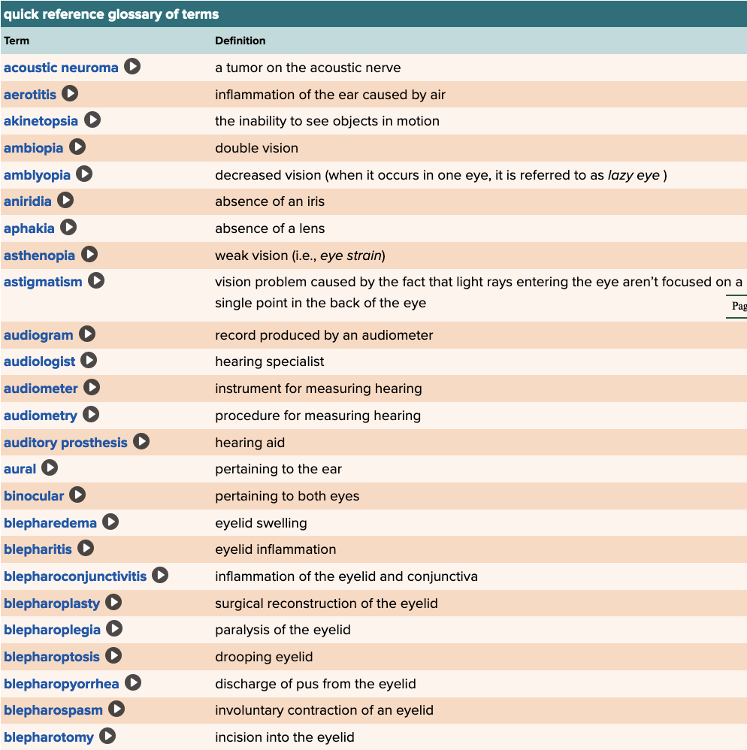
Chapter 6 Quick Reference
- Quick Reference Glossary of Terms Table Part 1
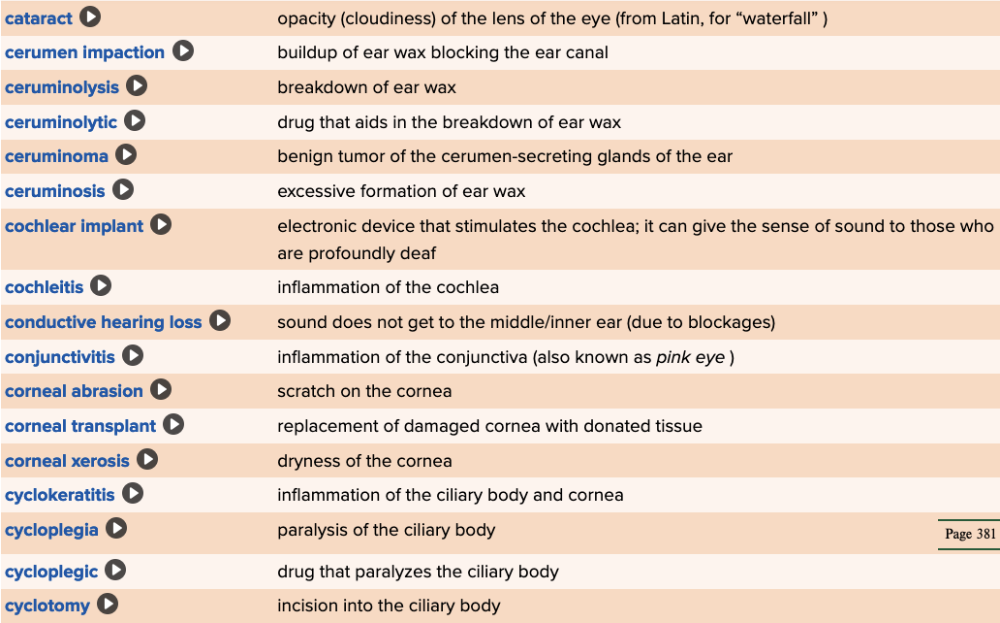
Chapter 6 Quick Reference
- Quick Reference Glossary of Terms Table Part 2
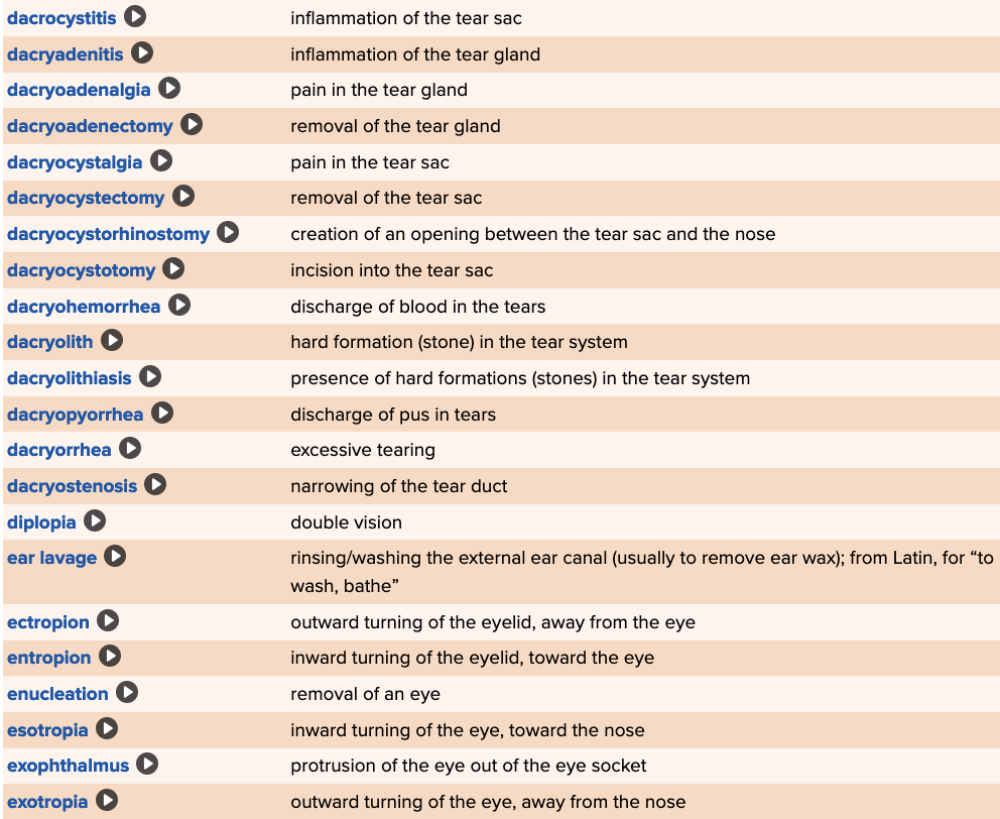
Chapter 6 Quick Reference
- Quick Reference Glossary of Terms Table Part 3
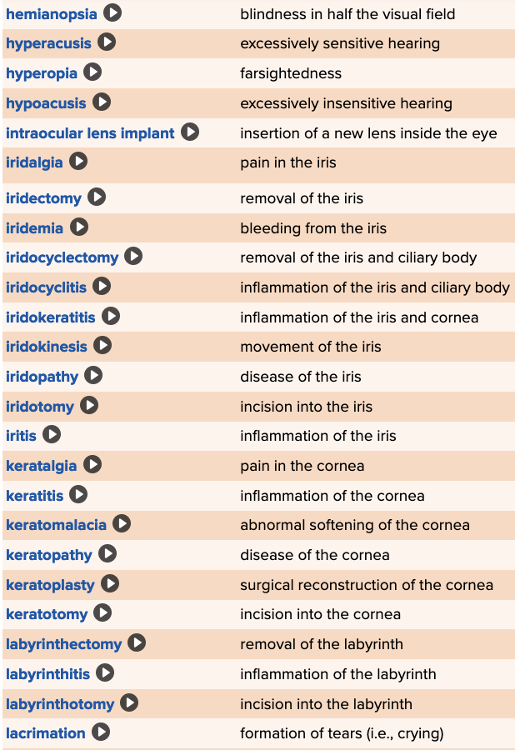
Chapter 6 Quick Reference
- Quick Reference Glossary of Terms Table Part 4
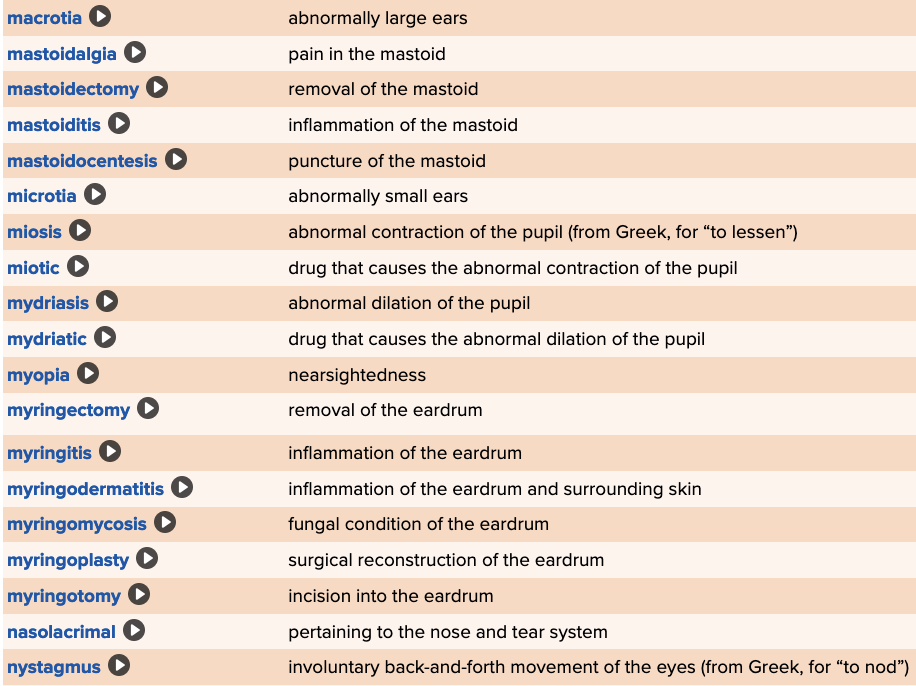
Chapter 6 Quick Reference
- Quick Reference Glossary of Terms Table Part 5
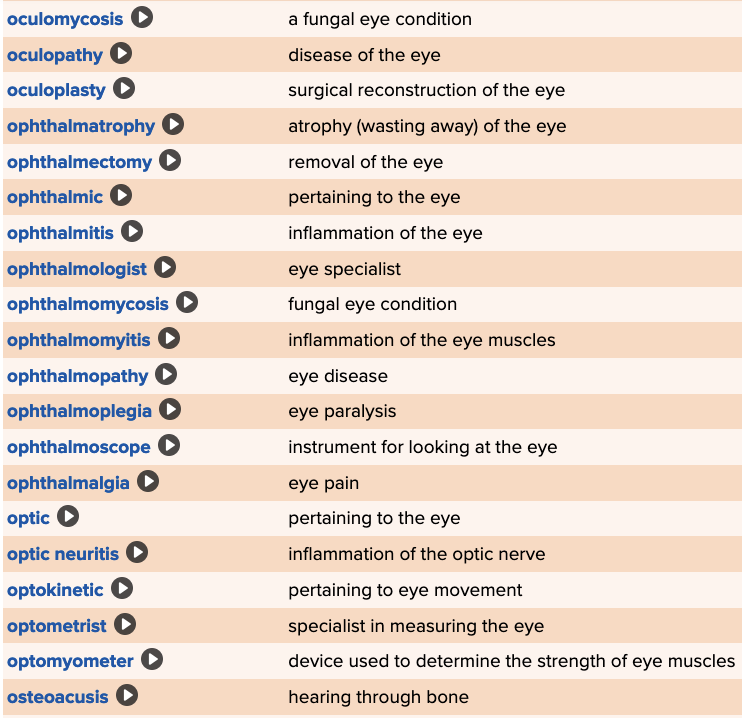
Chapter 6 Quick Reference
- Quick Reference Glossary of Terms Table Part 6
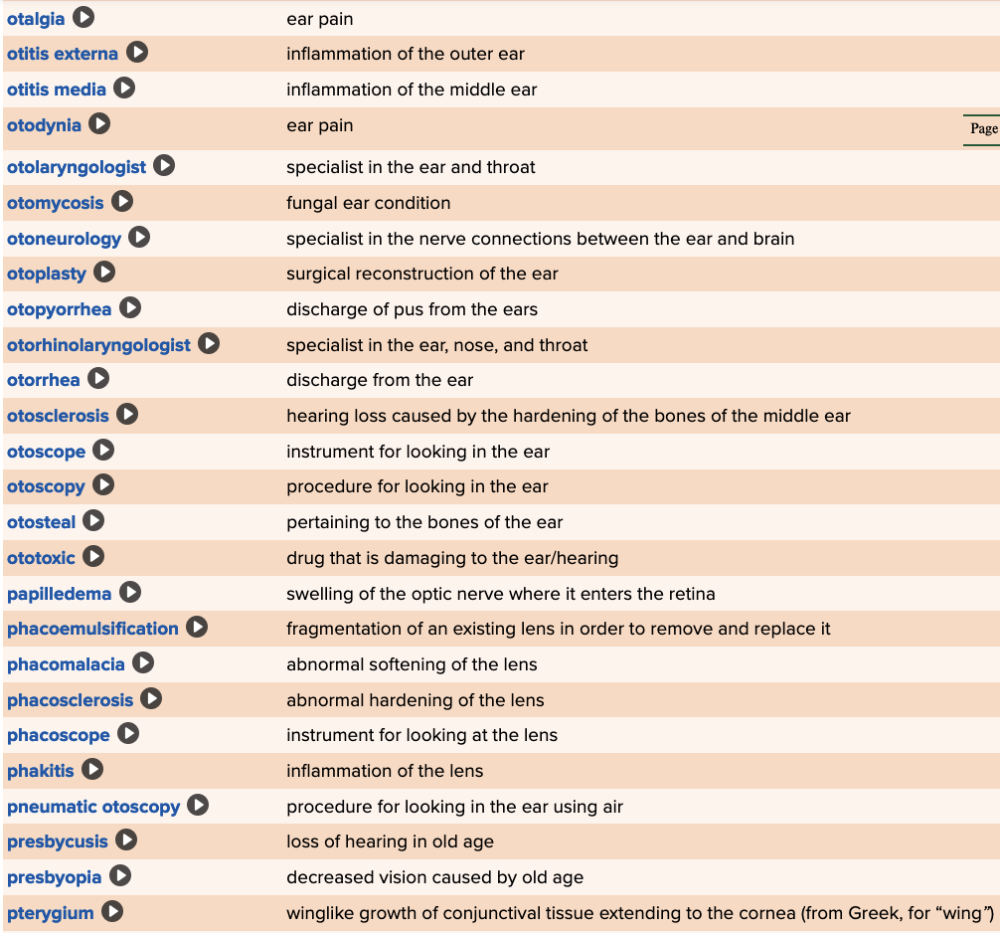
Chapter 6 Quick Reference
- Quick Reference Glossary of Terms Table Part 7
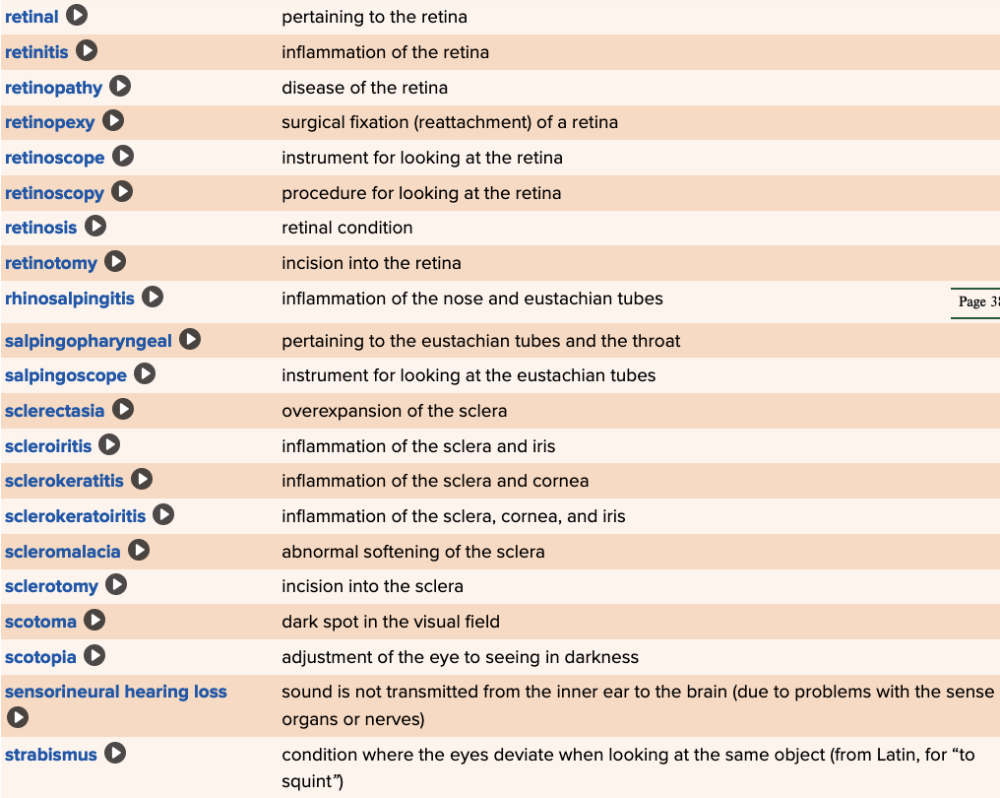
Chapter 6 Quick Reference
- Quick Reference Glossary of Terms Table Part 8
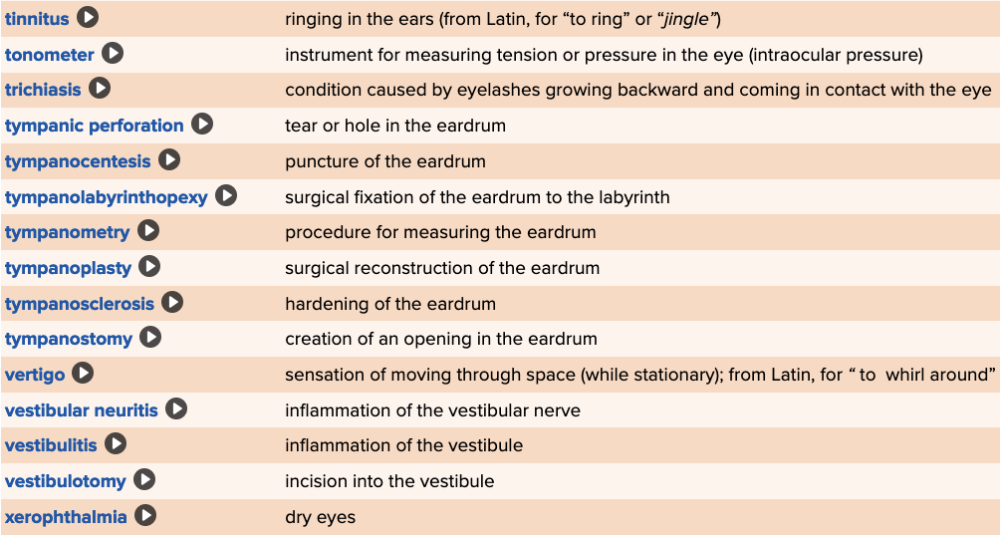
Chapter 6 Quick Reference
- Quick Reference Glossary of Terms Table Part 9
...
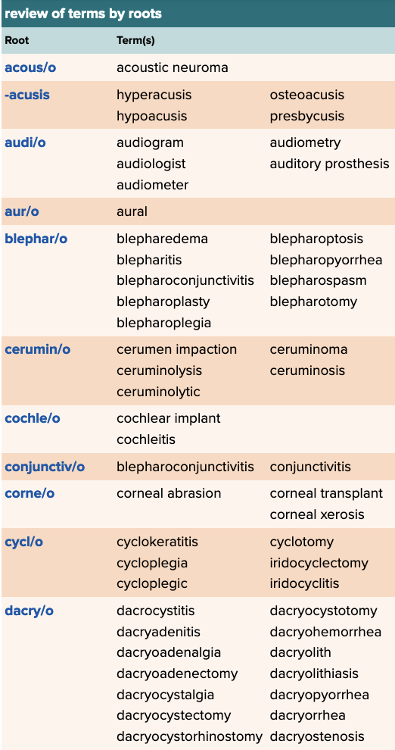
Chapter 6 Quick Reference
- Review of Terms by Roots Table Part 1
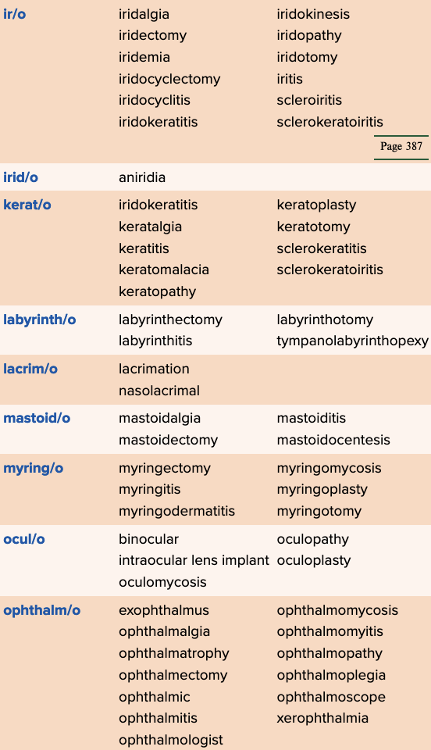
Chapter 6 Quick Reference
- Review of Terms by Roots Table Part 2
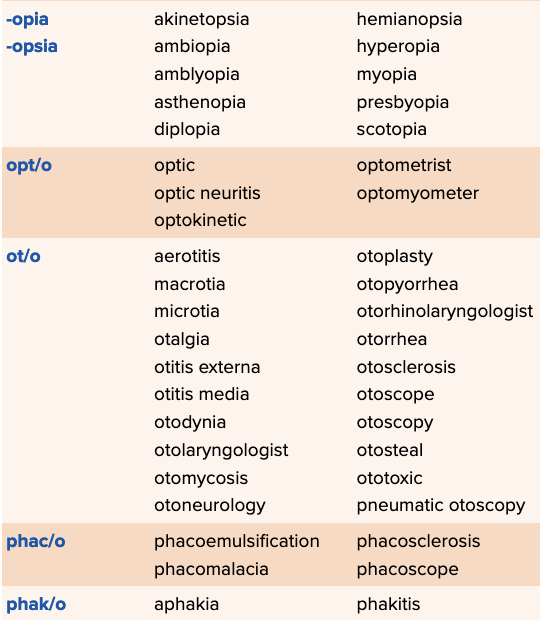
Chapter 6 Quick Reference
- Review of Terms by Roots Table Part 3
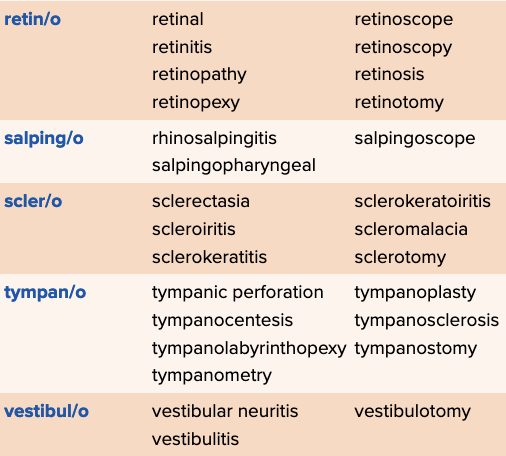
Chapter 6 Quick Reference
- Review of Terms by Roots Table Part 4
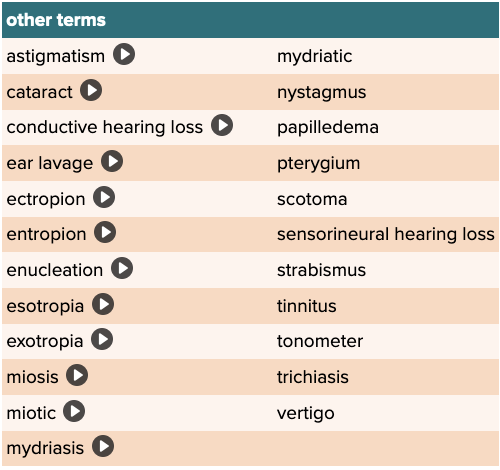
Chapter 6 Quick Reference
- Other Terms Table
...
How many bones make up the bony socket that holds the eye?
- Multiple choice question.
- 7
- 5
- 10
- 3
7
Select all that apply
Which of the following roots refer to the eye?
Multiple select question.
- ocul/o
- ot/o
- ophthalm/o
- opt/o
- ocul/o
- ophthalm/o
- opt/o
Select all that apply
Select the root(s) for the term tear.
Multiple select question.
- opt/o
- dacry/o
- lacrim/o
- ocul/o
- dacry/o
- lacrim/o
Select the suffix for the term vision condition.
Multiple choice question.
- blephar/o
- dacry/o
- ocul/o
- -opia
-opia
Which of the following root(s) is for the term eyelid?
Multiple choice question.
- -opia
- dacry/o
- blephar/o
- lacrim/o
blephar/o
The bony socket that holds the eye is the ______.
Multiple choice question.
- sclera
- iris
- orbit
- choroid
orbit
Select all that apply
Which of the following are the root(s) for the term cornea?
Multiple select question.
- scler/o
- corne/o
- kerat/o
- vitre/o
- corne/o
- kerat/o
What is the root for the term optometrist?
Multiple choice question.
- metrist
- optom/o
- ist
- opt/o
opt/o
Which of the following is the root for conjunctiva?
Multiple choice question.
- conjun/o
- scler/o
- conjunc/o
- conjunctiv/o
conjunctiv/o
Which of the following is the term used for lacrim/o?
Multiple choice question.
- Tear
- Eye
- Eyelid
- Vision
Tear
Which of the following is the root for the term sclera?
Multiple choice question.
- sclero
- scler/o
- cycl/o
- retin/o
scler/o
Which of the following is the is a condition where patients are unable to see objects in motion?
Multiple choice question.
- Oculopathy
- Blepharo
- Akinetopsia
- Blepharedema
Akinetopsia
The term that means liquid in the eye that helps focus light on the back of the retina is called ______ liquid.
vitreous
The root for eyelid is ______.
Multiple choice question.
- lacrimo
- blepharo
- audio
- oculo
blepharo
A circle of tissue surrounding the lens of the eye is called the ______ body.
ciliary
Select the term that is associated with the roots kerat/o and corne/o.
Multiple choice question.
- Cornea
- Eye
- Tear
- Eyelid
Cornea
Select all that apply
Which of the following are true regarding the retina?
Multiple select question.
- It bends light and aims it to the back of the eyeball.
- It is located on the inside surface of the eye.
- It changes the shape of the lens.
- It is a netlike pattern of light-sensitive tissue.
- It is located on the inside surface of the eye.
- It is a netlike pattern of light-sensitive tissue.
A clear membrane that covers the sclera and line the eyelids is called ______.
conjunctiva

Match the following roots associated with eye structure with their meaning.

The white, tough, and fibrous protective covering of the eye is call ______.
sclera
Which of the following is the correct pronunciation of otoscope?
Multiple choice question.
- AWTO-skohp
- AW-toh-skohp
- AWT-os-cope
- OH-toh-skohp
OH-toh-skohp
Which of the following is the root for vitreous liquid in the eye?
Multiple choice question.
- vitro
- vitreo
- vitre/o
- vitre
vitre/o
Which of the following is the root for the term ciliary body?
Multiple choice question.
- ir/o
- cil/o
- cyc/o
- cycl/o
cycl/o
The netlike pattern of light-sensitive tissue on the inside surface of the eye is the ______.
Multiple choice question.
- lens
- ciliary body
- retina
- vitreous humor
retina
Audi/o and acous/o are roots that refer to ______.
Multiple choice question.
- sound or hearing
- vision
- the inner ear
- the eardrum
sound or hearing
The colored part of the eye is the ______.
Multiple choice question.
- iris
- lens
- cornea
- retina
iris
Select all that apply
Which of the following conditions are a hearing condition?
Multiple select question.
- Osteoacusis
- Fibromyalgia
- Hyperacusis
- Osteomyelitis
Osteoacusis
Hyperacusis
Select all that apply
Which of the following roots refer to the ear?
Multiple select question.
- aur/o
- phak/o
- ot/o
- vitre/o
aur/o
ot/o
Select all that apply
Which of the following are bones of the middle ear?
Multiple select question.
- Stapes
- Incus
- Malleus
- Salpinx
- Stapes
- Incus
- Malleus
Which if the following is the root for ear wax?
Multiple choice question.
- tympan/o
- cerum/o
- cerumn/o
- cerumin/o
cerumin/o
The root in the term acoustic means ______.
sound or hearing
Select all that apply
Which of the following roots refer to the eardrum?
Multiple select question.
- tympan/o
- salping/o
- myring/o
- mastoid/o
- tympan/o
- myring/o
Which of the following is a bone hearing condition?
Multiple choice question.
- Ceruminolysis
- Myringotomy
- Rhinosalpingitis
- Osteoacusis
Osteoacusis
The bones of the middle ear are connected to the ______ in the inner ear.
Multiple choice question.
- cochlea
- labyrinth
- vestibule
- eardrum
cochlea
If people are aural learners they learn best by ______.
Multiple choice question.
- hearing
- writing
- seeing
- doing
hearing
Select the root for the term Vestibule.
Multiple choice question.
- vestibul/o
- vest/o
- vestibu/o
- cochle/o
vestibul/o
Select all that apply
Which of the following are true of cerumen?
Multiple select question.
- It contains a natural antibiotic.
- It helps keep the ear canal moist.
- It is more commonly known as ear wax.
- It normally drains into the inner ear.
- It contains a natural antibiotic.
- It helps keep the ear canal moist.
- It is more commonly known as ear wax.
The term cochlea is pronounced
Multiple choice question.
- KO-kee-lea.
- cock-lay-AH.
- KOH-klee-ah.
- COUGH-lee-a.
KOH-klee-ah.
Select the term used in both the female reproductive and sensory systems that have tube-like shapes.
Multiple choice question.
- Fallopian tube
- Eustachian tube
- Salpingitis tube
- Uterine tube
Eustachian tube
The root tympan/o refers to the
Multiple choice question.
- lens.
- ossicles.
- cochlea.
- eardrum.
eardrum.
The medical term for ringing in the ear is ______.
Multiple choice question.
- tinnitus
- otorrhea
- hypoacusis
- vertigo
tinnitus
Select all that apply
Which of the following are true of the vestibular system of the ear?
Multiple select question.
- It helps maintain balance.
- It produces and discharges cerumen to the outer ear.
- It is made up of small canals filled with fluid and hair.
- It sends information to the brain.
It helps maintain balance.
It is made up of small canals filled with fluid and hair.
It sends information to the brain.
An inability to see objects in motion is called ______.
akinetopsia
The term that refers to the area in front of the semicircular canals and contains structures that regulate balance is called ______.
vestibule
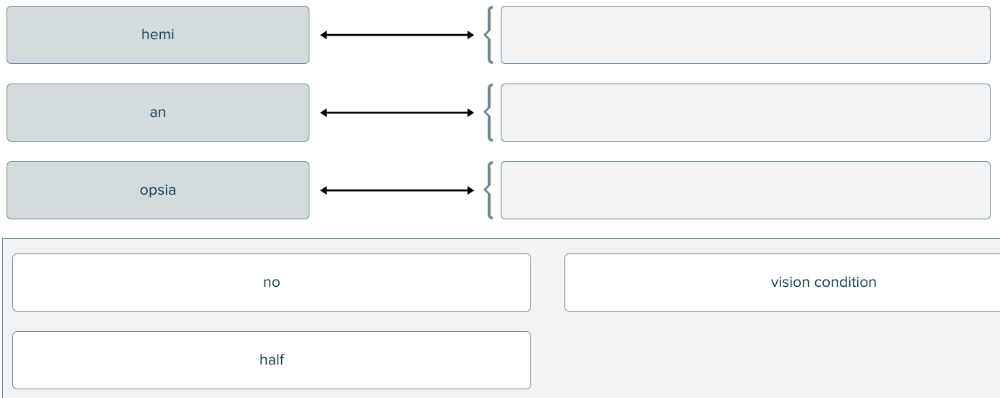
The term hemianopsia refers to blindness in half the visual field. Match each word parts of this term with its meaning.

The spiral, snail shell-shaped tube in the inner ear that contains hearing receptors is the ______.
Multiple choice question.
- cochlea
- vestibule
- incus
- labyrinth
cochlea
Which of the following is a an adjustment of the eye seeing in the darkness?
Multiple choice question.
- Scotopia
- Presbyopia
- Hyperopia
- Myopia
Scotopia
Which if the following is the root for ear wax?
Multiple choice question.
- cerumin/o
- cerumn/o
- cerum/o
- tympan/o
cerumin/o
Which of the following conditions is a paralysis of the eyelid?
Multiple choice question.
- Dacryocstalgia
- Blepharoplegia
- Blepharospasm
- Myopia
Blepharoplegia
The medical term for dizziness is ______.
Multiple choice question.
- vertigo
- otalgia
- hyperocusis
- tinnitus
vertigo
The root xer in the term xerophthalmia means ______.
dry
Select the condition that is defined as seeing double vision.
Multiple choice question.
- Akintopsia
- Amblyopia
- Asthenopia
- Ambiopia
Ambiopia
Ex.
Also, diplopia is defined as seeing double vision as well.
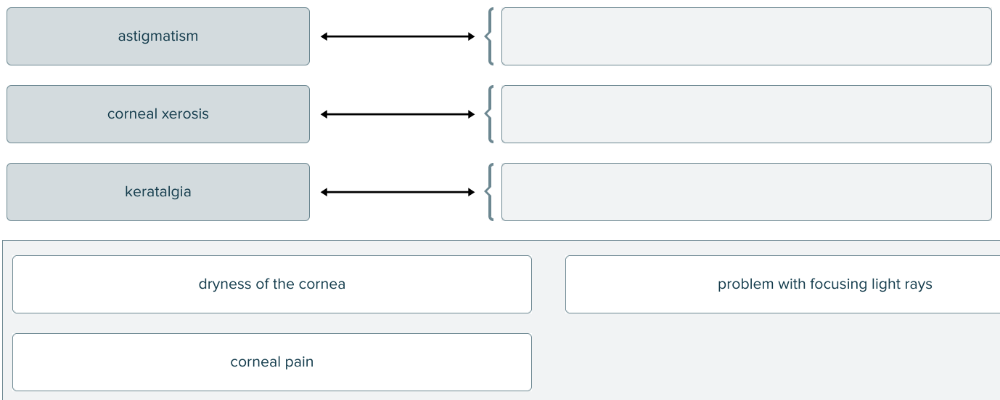
Match the terms related to the cornea and sclera with their meaning.

Deconstruct the term diplopia by separating the root from the suffix with a hyphen.
dipl-opia
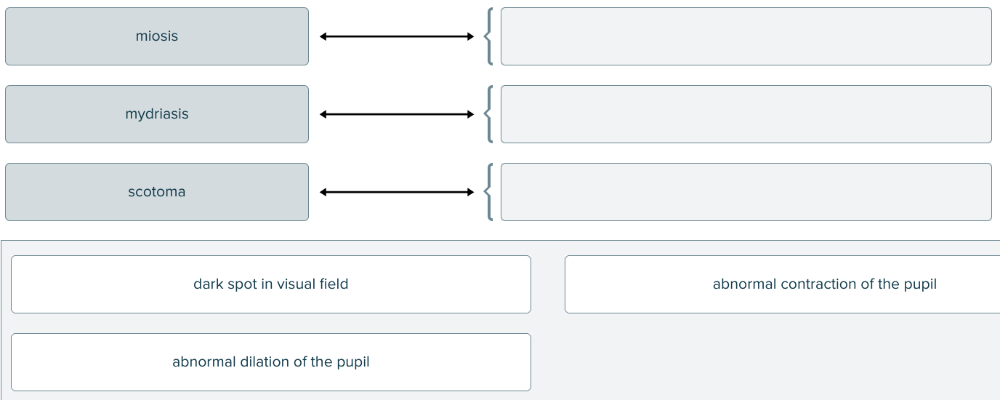
Match the terms related to the iris and pupil with their meaning.

The medical term that refers to decreased vision caused by old age is ______.
Multiple choice question.
- scotopia
- hyperopia
- presbyopia
- amblyopia
presbyopia
Which of the following terms refers to a loss of hearing in old age?
- Multiple choice question.
- Presbyopia
- Osteoacusis
- Hyperacusis
- Presbycusis
Presbycusis
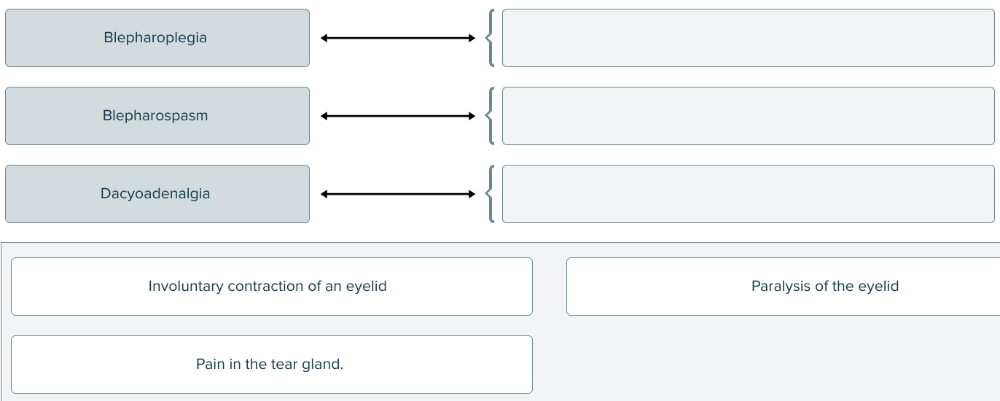
Match the conditions of the eye to the correct definition.

Otodynia refers to ______.
Multiple choice question.
- ringing in the ears
- excessively sensitive hearing
- discharge of pus from the ear
- ear pain
ear pain
Which of the following terms refer to dry eyes?
Multiple choice question.
- Xerophthalmia
- Ophthalmoplegia
- Mydriasis
- Ophthalmalgia
Xerophthalmia
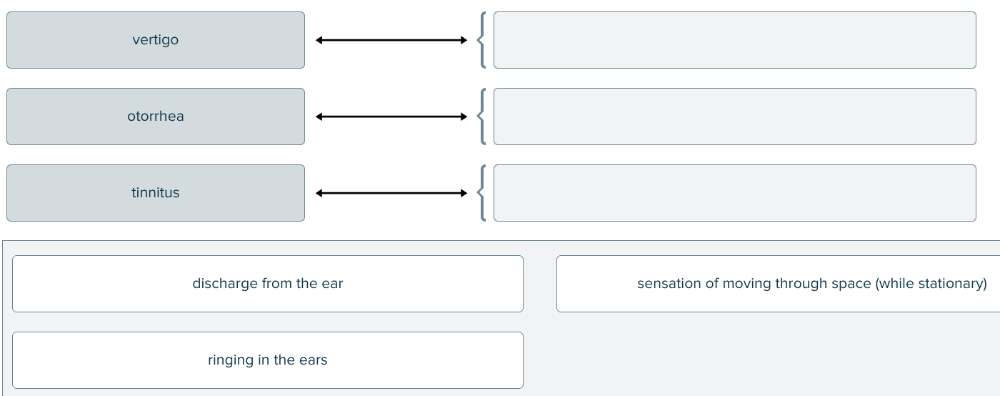
Match each condition of the outer/inner ear to its description.

A vision problem that is caused by the fact that light rays entering the eye aren't focused on a single point in the back of the eye is ______.
Multiple choice question.
- myopia
- hyperopia
- corneal xerosis
- astigmatism
astigmatism
Which of the following is an instrument used for looking at the eye?
Multiple choice question.
- Binocular
- Opthalmoscope
- Phacoscope
- Optomyomter
Opthalmoscope
Deconstruct the term iridalgia by separating the root from the suffix with a hyphen. Enter hyphens in the appropriate blanks.
______ ______ ______
Blank 1: irid
Blank 2: -
Blank 3: algia
The procedure for looking at the retina is called ______.
retinoscopy
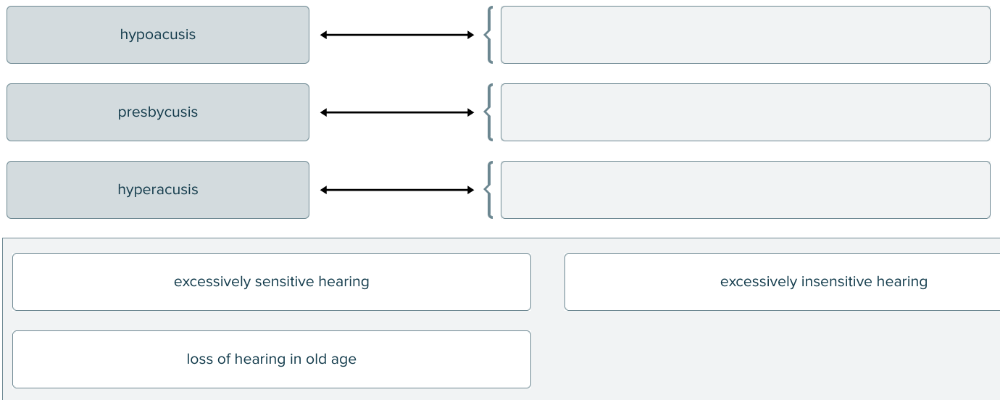
Match each hearing condition with its description.

The term used for movement of the iris is ______.
Iridokinesis
Select all that apply
Which of the following terms refer to ear pain?
Multiple select question.
- Otodynia
- Mastoidalgia
- Iridalgia
- Otalgia
- Otodynia
- Otalgia
Ophthalmic means pertaining to the ______.
Multiple choice question.
- ear
- eyelashes
- eyelid
- eye
eye
The medical term for the sensation of moving through space (while stationary) is ______.
Multiple choice question.
- otodynia
- tinnitus
- vertigo
- otopyorrhea
vertigo
The term used for pertaining to the retina is ______.
retinal
An instrument used for looking at the lens is a ______.
phacoscope
The term blepharedema refers to ______.
Multiple choice question.
- drooping eyelid
- eyelid swelling
- inward turning of the eyelid
- discharge of pus from the eyelid
eyelid swelling
Which of the following is an instrument used for looking at the retina?
Multiple choice question.
- Retinoscope
- Retinoscopy
- Tonometer
- Binocular
Retinoscope
The term that means discharge of pus in tears is ______.
dacryopyorrhea
Which of the following is the professional term meaning pertaining to both eyes?
Multiple choice question.
- Nasolacrimal
- Lacrimation
- Binocular
- Iridokinesis
Binocular
Protrusion of eyes out of the eye socket is ______.
Multiple choice question.
- nystagmus
- strabismus
- exophthalmus
- esotropia
exophthalmus
Select all that apply
Which of the following terms mean pertaining to the eye?
Multiple select question.
- otic
- optometrist
- ophthalmic
- optic
- ophthalmic
- optic
The medical term for softening of the cornea is ______.
Multiple choice question.
- scleromalacia
- phacomalacia
- keratomalacia
- tracheomalacia
keratomalacia
Which of the following is a specialist in measuring the eye?
Multiple choice question.
- Endocrinologist
- Optometrist
- Cardiologist
- Oncologist
Optometrist
Which of the following is the abnormal softening of the cornea?
Multiple choice question.
- Scleromalacia
- Pterygium
- Phacomalacia
- Keratomalacia
Keratomalacia
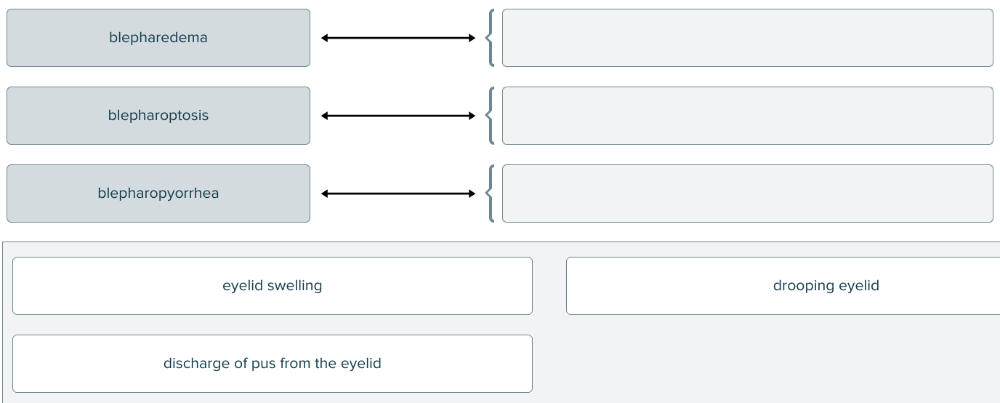
Drag and drop the definition against the corresponding eyelid condition.

Which of the following is the term used for swelling of the optic nerve where it enters the retina?
Multiple choice question.
- Audiogram
- Papilledema
- Phacomalacia
- Phacosclerosis
Papilledema
Which of the following is a hard formation in the tear system?
- Multiple choice question.
- Dacryopyrrhea
- Ectropion
- Dacryolith
- Bleparopyorrhea
Dacryolith
The procedure for measuring hearing is ______.
Multiple choice question.
- audiometry
- audiogram
- audiometer
- audiologist
audiometry
The condition in which the eyes deviate when looking at the same object is ______.
Multiple choice question.
- entropion
- scleromalacia
- nystagmus
- strabismus
strabismus
An instrument used for examining the eustachian tube is a(n) ______.
Multiple choice question.
- salpingoscope
- otoscope
- audiometer
- tympanometer
salpingoscope
Keratomalacia is a medical term for softening of the ______.
Multiple choice question.
- lens
- iris
- cornea
- sclera
cornea
Otoscopy is a procedure for ______.
Multiple choice question.
- measuring the eardrum
- examining the eye
- measuring hearing
- examining the ear
examining the ear
The term for abnormal softening of the sclera is ______.
scleromalacia
An audiologist is a specialist in ______.
Multiple choice question.
- nose and throat
- eyes
- hearing
- sinuses
hearing
The term used for abnormal softening of the lens is ______.
phacomalacia
Deconstruct the term audiologist by separating the root from the suffix with a hyphen. ______
audio-logist
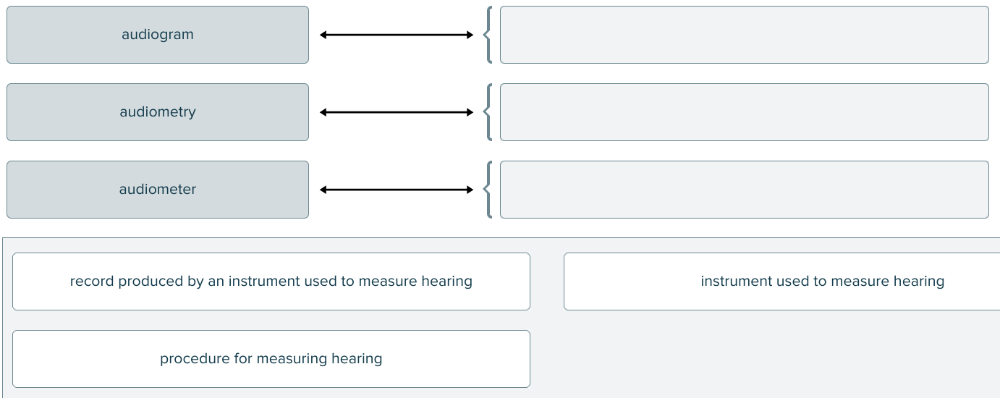
Drag and drop the descriptions against the corresponding terms that relate to the measurement of hearing.

The term used for pertaining to the bones of the ear is ______.
otosteal
Match the terms related to examination of the ear with their definitions.
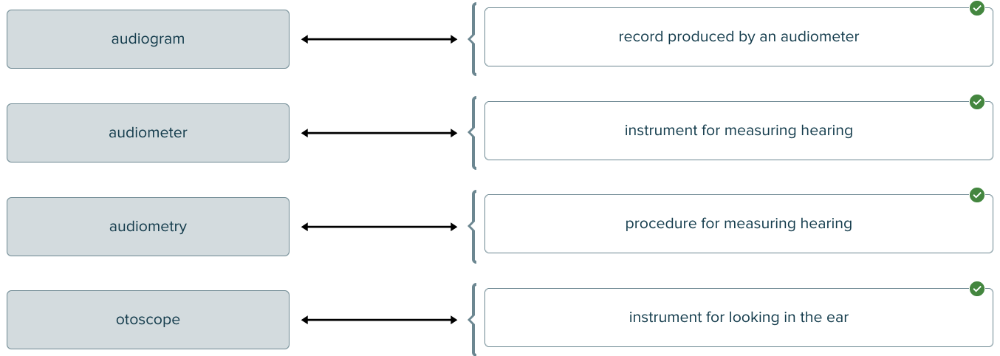
The term for abnormally small ears is ______.
microtia
Deconstruct the term salpingoscope by separating the root from the suffix with a hyphen. ______
salpingo-scope
The discharge of pus from the ears is termed ______.
Multiple choice question.
- ceruminosis
- macrotia
- otosclerosis
- otopyorrhea
otopyorrhea
The medical term for a specialist of the ear and throat is an ______.
Multiple choice question.
- otologist
- ophthalmologist
- otolaryngologist
- audiologist
otolaryngologist
Select all that apply
Conjunctivitis, or "pink eye," is usually caused by what types of infection?
Multiple select question.
- Fungal
- Bacterial
- Viral
- Protozoan
- Bacterial
- Viral
The medical term for a hearing specialist is an ______.
Multiple choice question.
- audiologist
- optician
- otolaryngologist
- opthalmologist
audiologist
Select all that apply
Which of the following are true of scleritis?
Multiple select question.
- It is typically chronic
- It is often due to inflammatory disorders
- It is limited to the tear ducts
- It is painful
- It is typically chronic
- It is often due to inflammatory disorders
- It is painful
Name the term used to describe pertaining to the eustachian tubes and the throat.
Multiple choice question.
- Otosteal
- Ceruminosis
- Salpingopharyngeal
- Microtia
Salpingopharyngeal
Select the definition for the term Macrotia.
Multiple choice question.
- Abnormally small ears
- Discharge of pus from the ear
- Abnormally large ears
- Tear in the eardrum
Abnormally large ears
Clouding of the lens of the eye is ______.
Multiple choice question.
- iritis
- aphakia
- corneal abrasion
- cataract
cataract
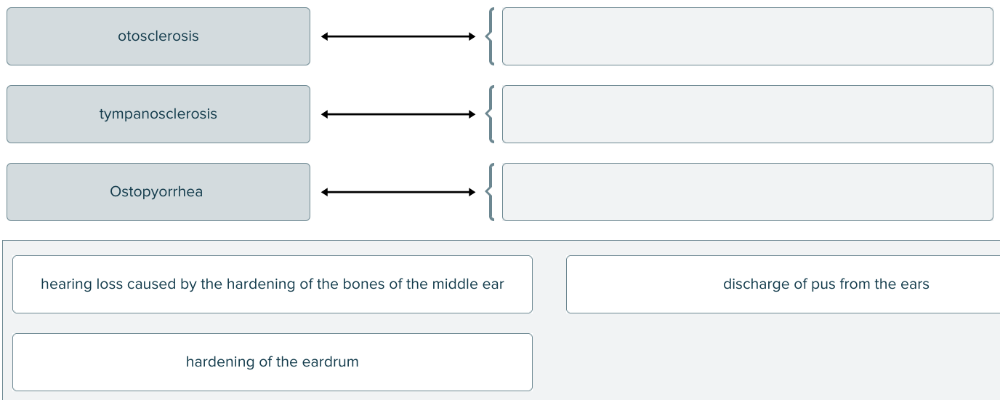
Match each term associated with the outer ear with its description.

The condition caused by pressure on the optic nerve from the inside of the eye is ______.
Multiple choice question.
- myopia
- glaucoma
- iritis
- cataract
glaucoma
The medical term for the condition commonly known as "pink eye" is ______.
Multiple choice question.
- conjunctivitis
- blepharitis
- keratomalacia
- myopia
conjunctivitis
Select all that apply
Otitis externa can be the result of ______.
Multiple select question.
- water trapped in the ear canal
- Meniere's disease
- hardening of the bones of the middle ear
- cerumen impaction
- water trapped in the ear canal
- cerumen impaction
Inflammation of the cornea is ______.
Multiple choice question.
- glaucoma
- conjunctivitis
- keratitis
- scleritis
keratitis
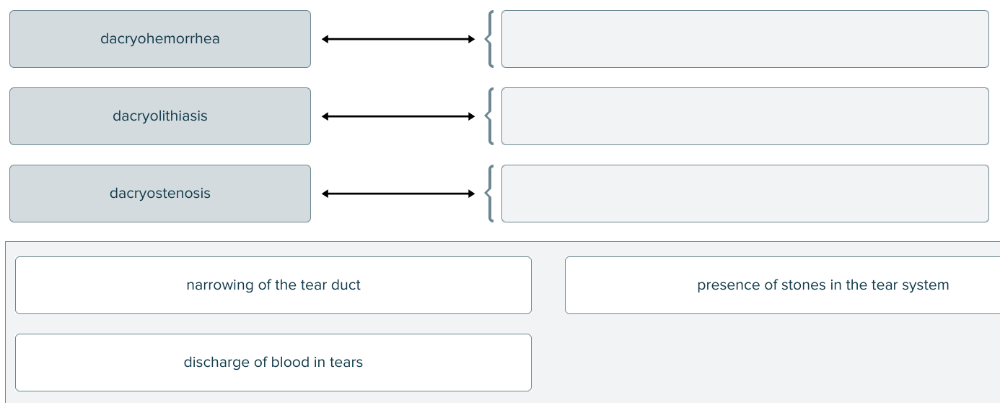
Match each term of the eye with its description.

The term used for pertaining to the bones of the ear is ______.
otosteal
Which of the following terms means atrophy of the eye?
Multiple choice question.
- Ophthamitis
- Trichiasis
- Conjunctivitis
- Ophthalmatrophy
Ophthalmatrophy
The medical term for the absence of a lens of the eye is ______.
Multiple choice question.
- glaucoma
- cataract
- aphakia
- iritis
aphakia
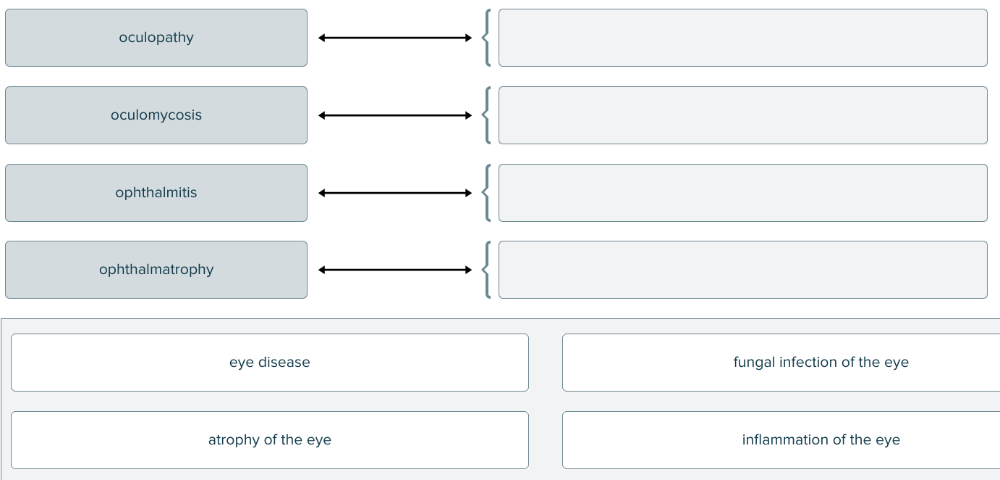
Match the following diseases of the eye and diagnostic terms with their meanings.
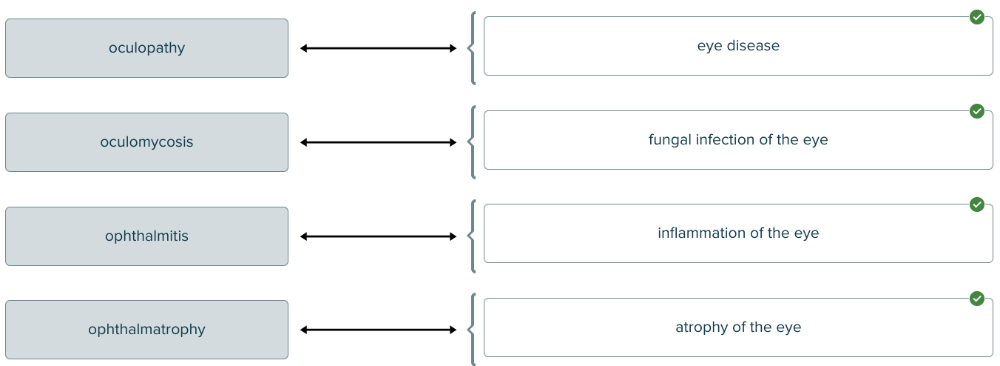
Select all that apply
Which of the following is true of a retinal detachment?
Multiple select question.
- It can be treated with over-the-counter eye drops.
- It requires immediate reattachment.
- Blindness can occur if not treated.
- It is an emergency situation.
- It requires immediate reattachment.
- Blindness can occur if not treated.
- It is an emergency situation.
Inflammation of the sclera, cornea, and iris is termed ______.
Multiple choice question.
- scleroiritis
- sclerectasia
- sclerokeratoiritis
- scleritis
sclerokeratoiritis
Otitis externa is infection of the ______.
Multiple choice question.
- inner ear
- eustachian tube
- outer ear
- middle ear
outer ear
Which of the following is the absence of an iris?
Multiple choice question.
- Aniridia
- Corneal abrasion
- Aphakia
- Cataract
Aniridia
The medical term for inflammation of the tear sac is ______.
Multiple choice question.
- dacryocystitis
- dacryolithiasis
- dacryohemorrhea
- dacryoadenitis
dacryocystitis
Select the definition for iridemia.
Multiple choice question.
- Disease of the iris
- Inflammation of the iris and ciliary body
- Inflammation of the iris.
- Bleeding from the iris
Bleeding from the iris
The term that is a fungal eye condition is called ______.
oculomycosis
Oculomycosis describes a condition of the eye that is ______.
Multiple choice question.
- viral
- allergic
- bacterial
- fungal
fungal
Select the definition for mastoiditis.
Multiple choice question.
- Fungal ear infection
- Disease of the mastoid
- Inflammation of the mastoid
- Retinal condition
Inflammation of the mastoid
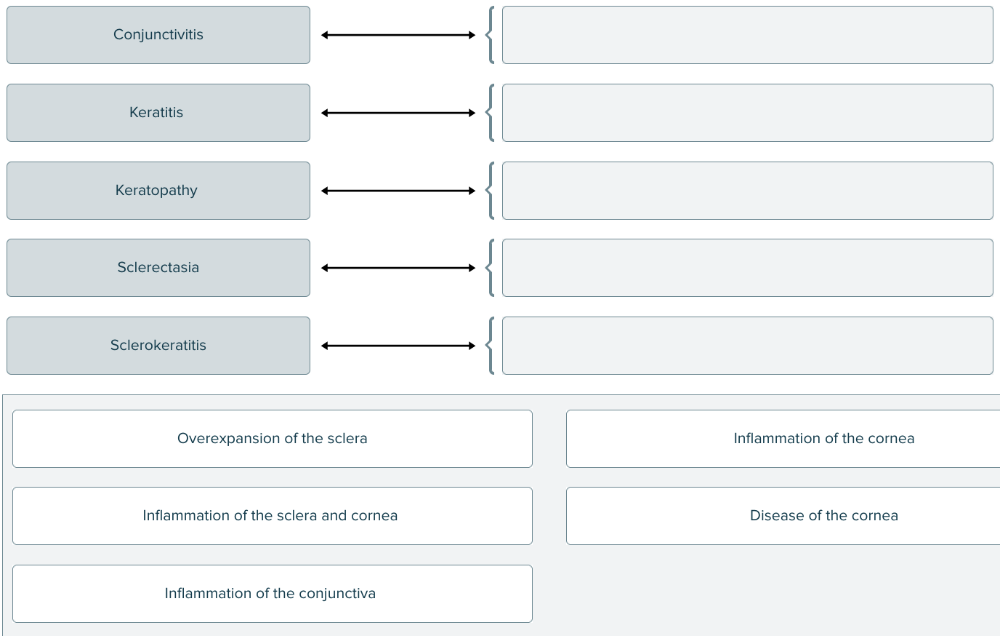
Match the term associated with sclera to the definition.
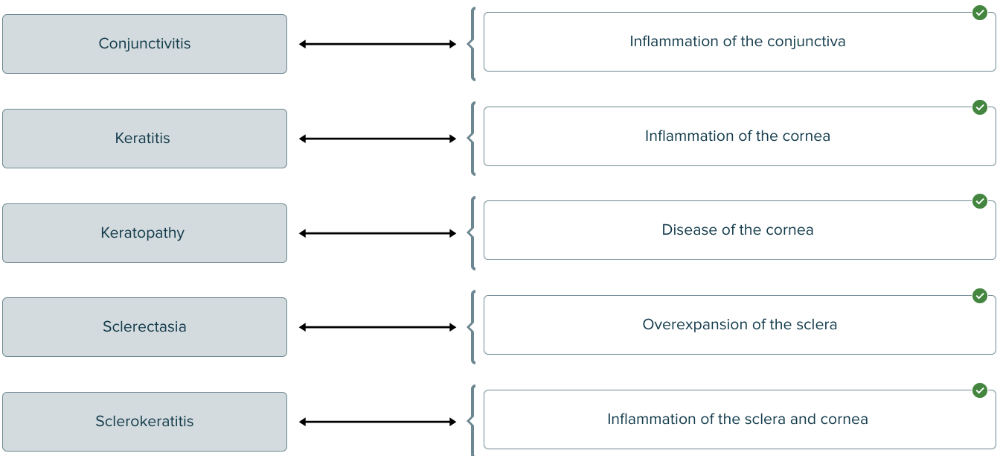
Which of the following is a buildup of ear wax blocking the ear canal?
Multiple choice question.
- Otitis externa
- Mastoiditis
- Otomycosis
- Cerumen impaction
Cerumen impaction
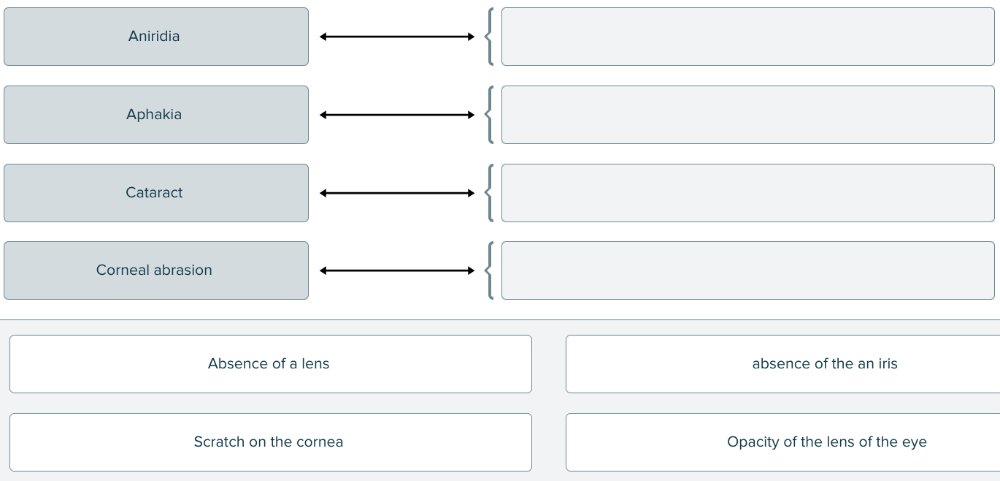
Drag and drop the definition against the corresponding the term related to choriod/retina.
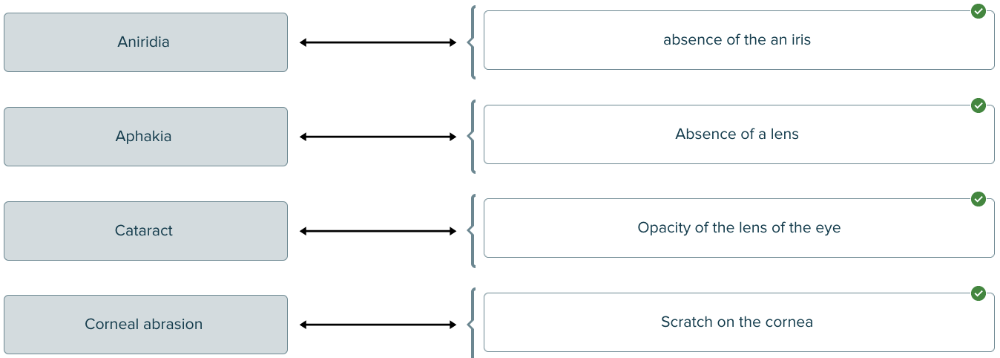
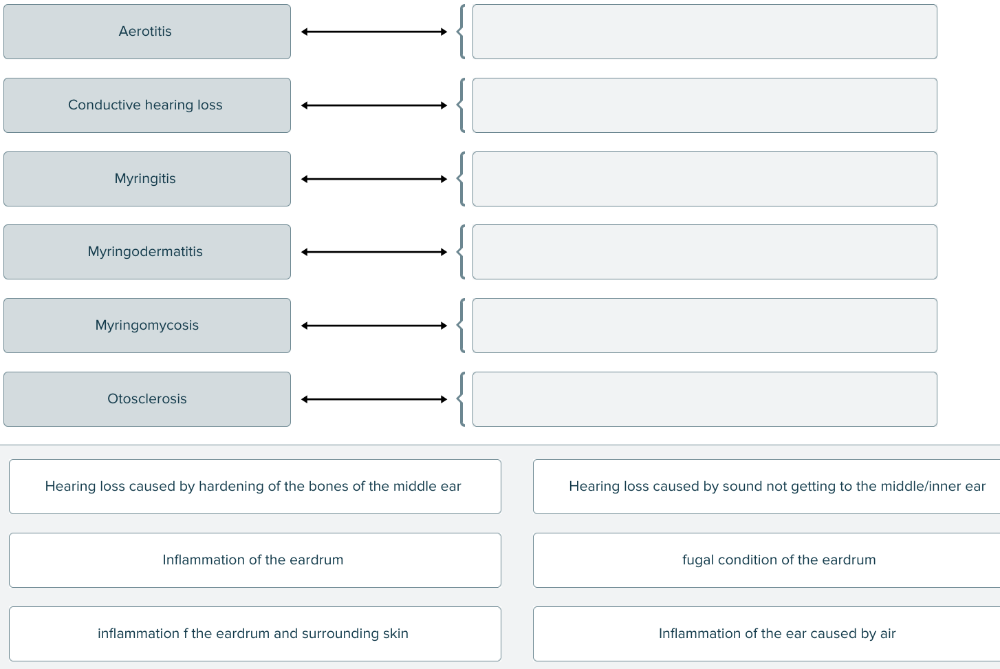
Select the definition that matches the conditions of the eye.
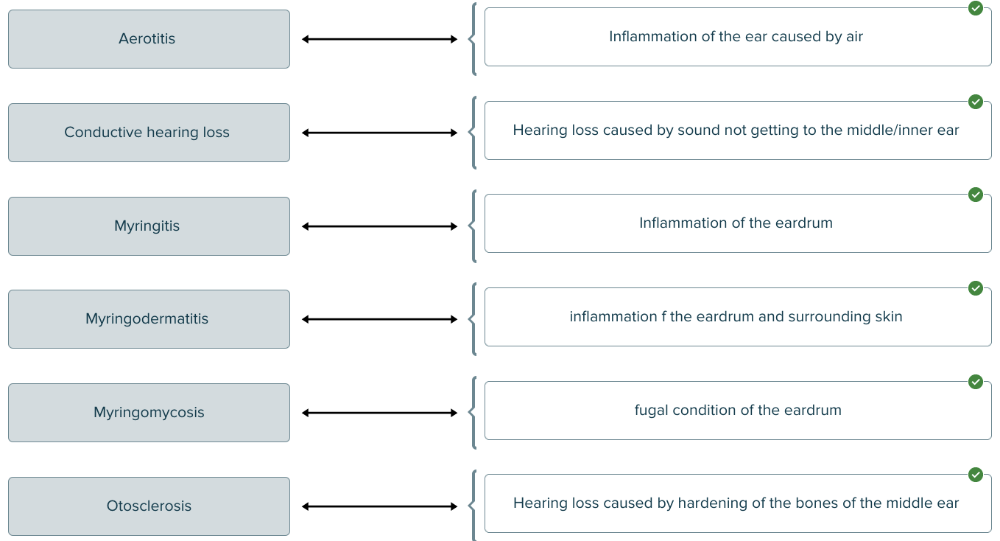
Which of the following is inflammation of the ciliary body and cornea?
Multiple choice question.
- Endophthalmitis
- Iridocyclitis
- Cyclokeratitis
- Iridopathy
Cyclokeratitis
The term for inflammation of the cochlea is ______.
cochleitis
Which of the following terms means atrophy of the eye?
Multiple choice question.
- Trichiasis
- Ophthalmatrophy
- Ophthamitis
- Conjunctivitis
Ophthalmatrophy
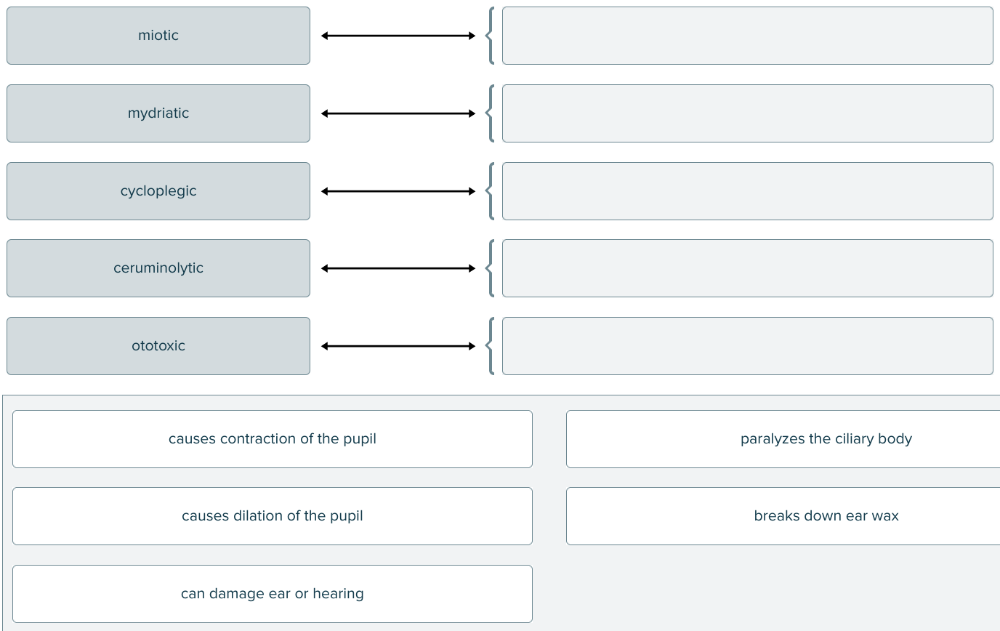
Match the following drug types with their actions.
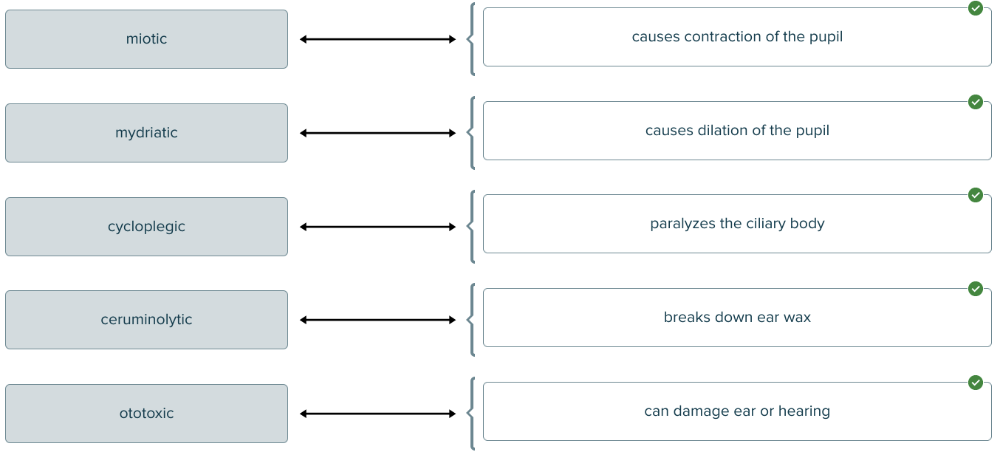
The term that means inflammation of the lens is ______.
phakitis
Blepharoplasty is the medical term for ______.
Multiple choice question.
- inflammation of the eyelid
- surgical reconstruction of the eyelid
- incision into the eyelid
- drooping eyelid
surgical reconstruction of the eyelid
The term for fungal ear condition is ______.
otomycosis
A dacryocystectomy is the removal of the ______ sac.
tear or lacrimal
The term for inflammation of the nose and eustachain tubes is ______.
rhinosalpingitis
Select all that apply
Which terms refer to removal of the eye?
Multiple select question.
- Oculoplasty
- Ophthalmitis
- Enucleation
- Ophthalmectomy
- Enucleation
- Ophthalmectomy
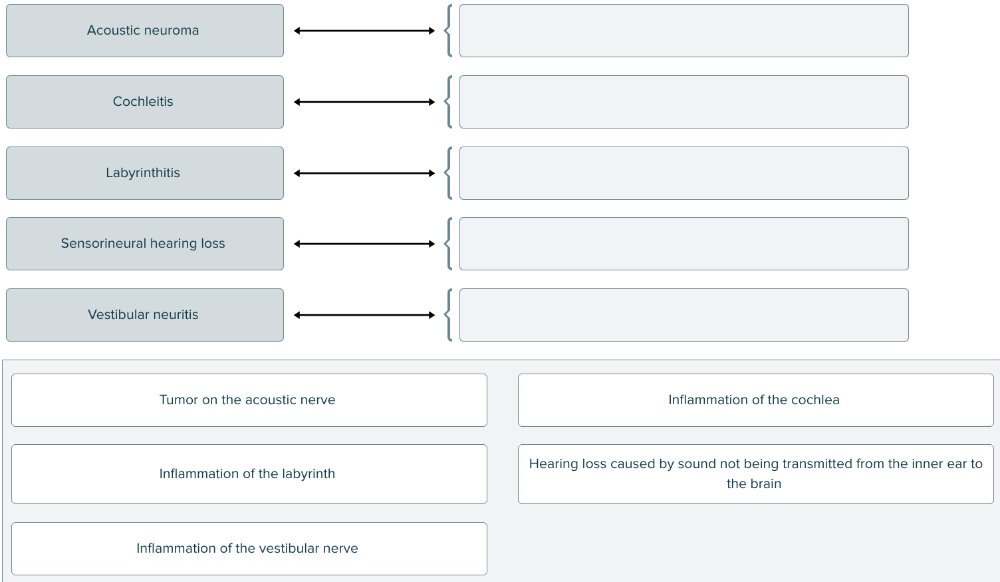
Match the inner ear conditions to the correct definition.
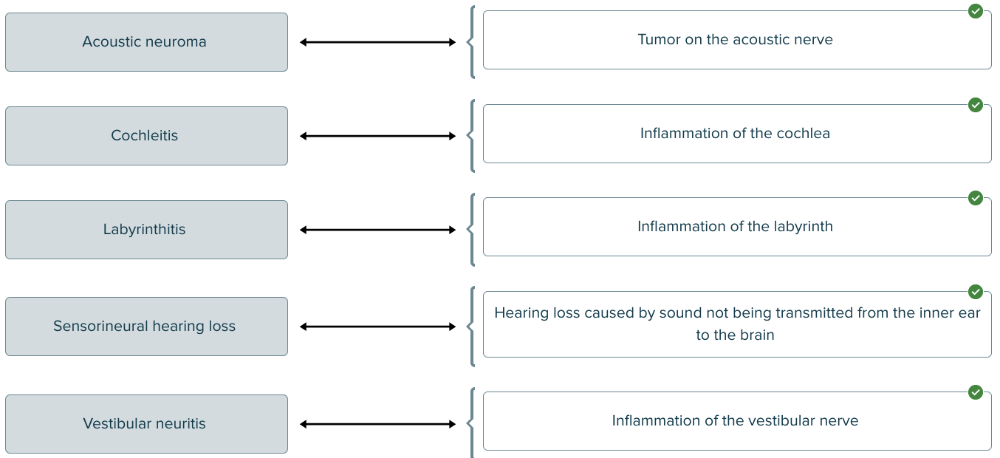
Surgical reconstruction of the cornea is a(n) ______.
Multiple choice question.
- corneal transplant
- keratoplasty
- enucleation
- keratotomy
keratoplasty
Which of the following is an antibiotic administered directly into the vitreous gel liquid?
Multiple choice question.
- Cycloplegic
- Oxytocic
- Mydriatic
- Intravitreal antibiotic
Intravitreal antibiotic
Retinopexy is the surgical fixation of the ______.
retina
Surgical reconstruction of the eyelid is termed ______.
Multiple choice question.
- blepharoplasty
- blepharotomy
- blepharitis
- blepharoptosis
blepharoplasty
An auditory prosthesis is a ______.
Multiple choice question.
- hearing aid
- surgical reconstruction of the ear
- rinsing/washing of the external ear canal
- measurement of hearing
hearing aid
Select all that apply
A dacryocystorhinostomy is the creation of an opening between which two structures?
Multiple select question.
- Throat
- Nose
- Tear sac
- Tear gland
- Nose
- Tear sac
The term for breakdown of ear wax is ______.
ceruminolysis
Enucleation is the removal of a(n) ______.
Multiple choice question.
- tear sac
- eye
- eardrum
- eyelid
eye
Deconstruct the term otoplasty by separating the root from the suffix with a hyphen. ______
oto-plasty
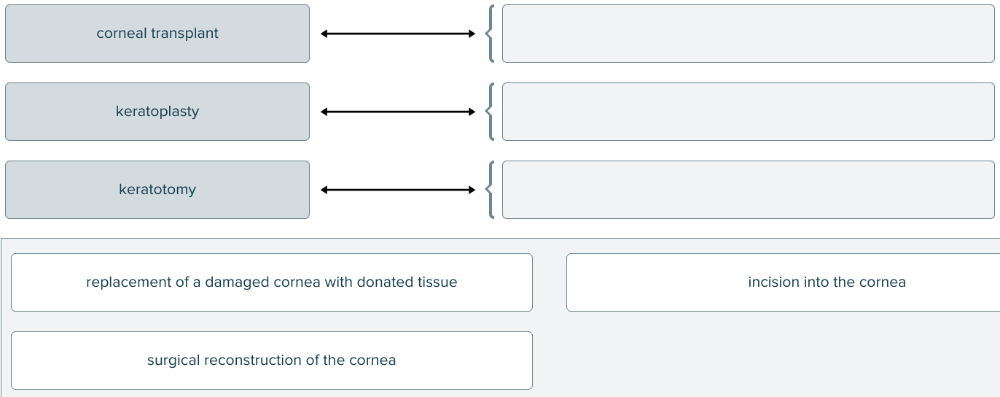
Match each term related to the sclera with its description.

Removal of the eardrum is a ______.
Multiple choice question.
- myringoplasty
- myringotomy
- myringitis
- myringectomy
myringectomy
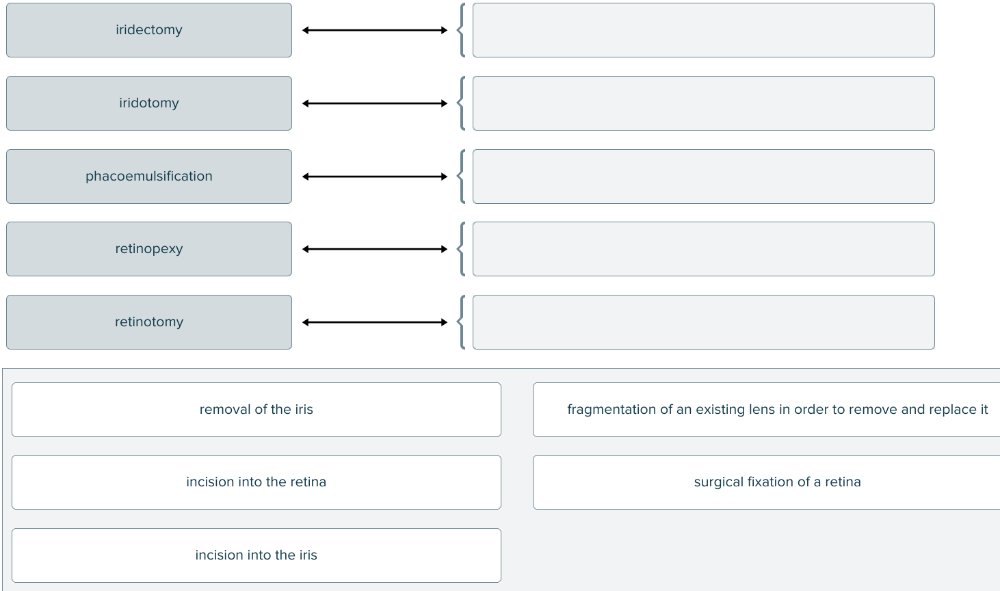
Match each surgical term of the eye with its description.
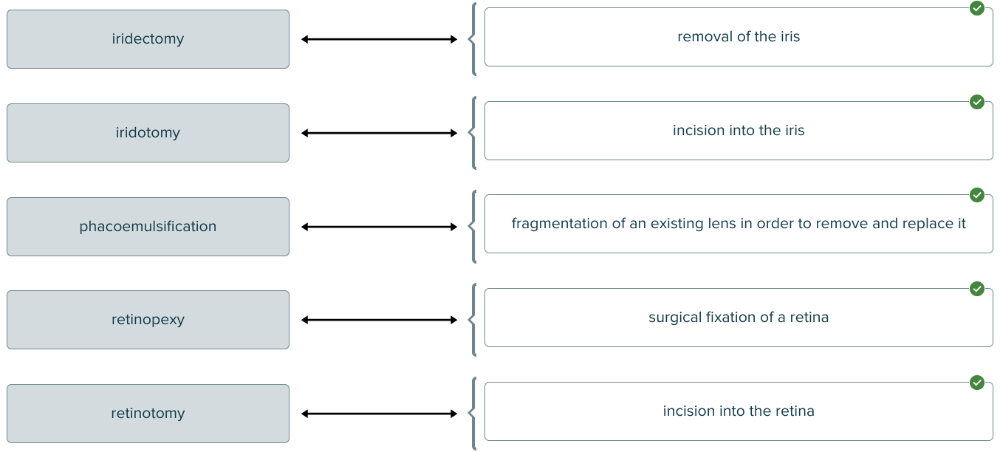
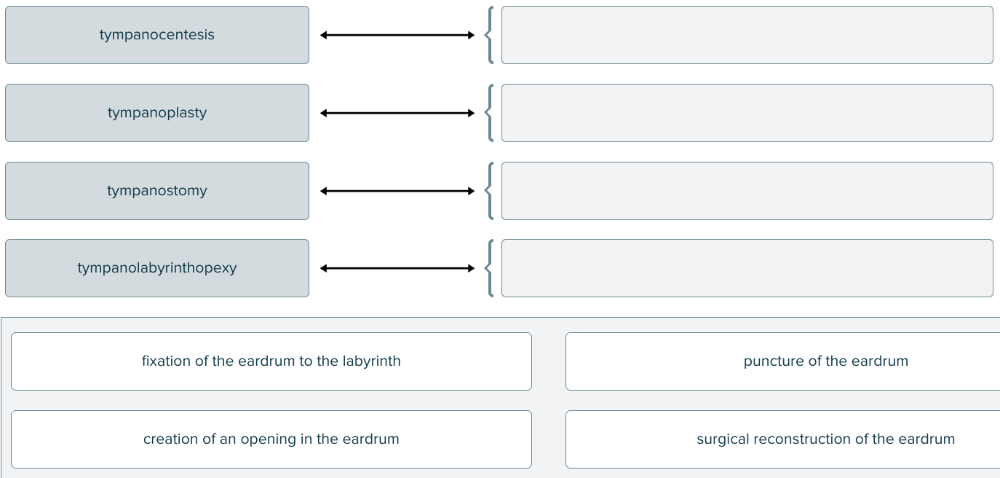
Match the terms related to procedures on the eardrum to their meaning.
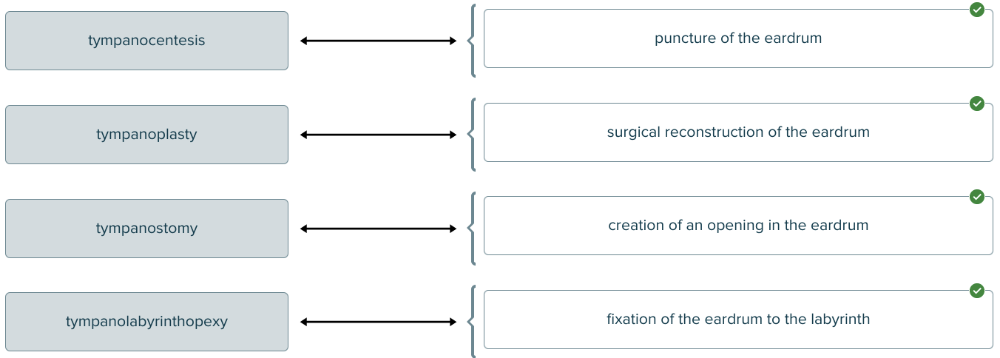
The medical term for a hearing aid is a(n) ______.
Multiple choice question.
- auditory prosthesis
- ear lavage
- tympanocentesis
- enucleation
auditory prosthesis
Select all that apply
Which of the following are true regarding a cochlear implant?
Multiple select question.
- It can give a sense of sound to those who are profoundly deaf.
- It surgically fixates the cochlea to the eardrum.
- It is an electronic device that stimulates the cochlea.
- It creates an opening into the cochlea.
- It can give a sense of sound to those who are profoundly deaf.
- It is an electronic device that stimulates the cochlea.
Which of the following is the removal of the mastoid?
Multiple choice question.
- Mastoidectomy
- Myringotomy
- Otoplasty
- Mastoidecentesis
Mastoidectomy
The P in IOP stands for ______.
Multiple choice question.
- pupil
- pressure
- peak
- pain
pressure
Surgical reconstruction of the ear is ______.
Multiple choice question.
- ear lavage
- ceruminolysis
- keratoplasty
- otoplasty
otoplasty
The L in LASIK stands for ______.
Multiple choice question.
- left
- lens
- light
- laser
laser
Myringoplasty is the surgical reconstruction of the tympanic membrane, more commonly known as the ______.
eardrum
The abbreviation for the right eye is ______.
OD
Puncture of the eardrum is ______.
Multiple choice question.
- tympanostomy
- mastoidocentesis
- tympanocentesis
- otoplasty
tympanocentesis
The A in the abbreviation VA that refers to the eye stands for ______.
Multiple choice question.
- acute
- amblyopia
- astigmatism
- acuity
acuity
The term for incision into the vestibule is ______.
vestibulotomy
The abbreviation for the left ear is ______.
Multiple choice question.
- AD
- AOM
- AS
- AU
AS
The IO in IOP stands for ______.
Multiple choice question.
- intraocular
- intraoptic
- infraorbital
- interophthalmic
intraocular
Select all that apply
The abbreviation ENT refers to ______.
Multiple select question.
- throat
- nose
- ear
- eye
- throat
- nose
- ear
Which of the following is true regarding LASIK?
Multiple choice question.
- It involves macular degeneration.
- It evaluates the pupils.
- It is laser-assisted.
- It treats increased intraocular pressure.
It is laser-assisted.
The abbreviation OM stands for otitis media, or a middle ______ infection.
ear
The abbreviation for both eyes is ______.
Multiple choice question.
- OU
- OM
- OD
- OS
OU
The T in TM stands for ______.
Multiple choice question.
- tympanic
- tear
- throat
- tube
tympanic
The V in VA stands for ______.
Multiple choice question.
- visual
- venous
- vitreous
- valve
visual
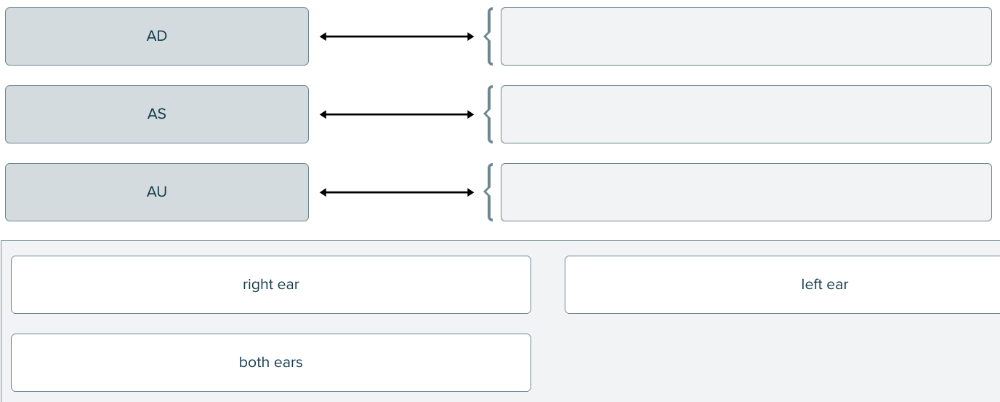
Match each abbreviation of the left or right ear to its definition.

Which of the following is NOT part of the abbreviation ENT?
Multiple choice question.
- Nose
- Ear
- Eye
- Throat
Eye
The M in OM stands for ______.
Multiple choice question.
- membrane
- media
- minimal
- myringotomy
media
The M in TM stands for ______.
Multiple choice question.
- macula
- media
- membrane
- myringoplasty
membrane